Quick filters:
Amaterasu shinto Stock Photos and Images
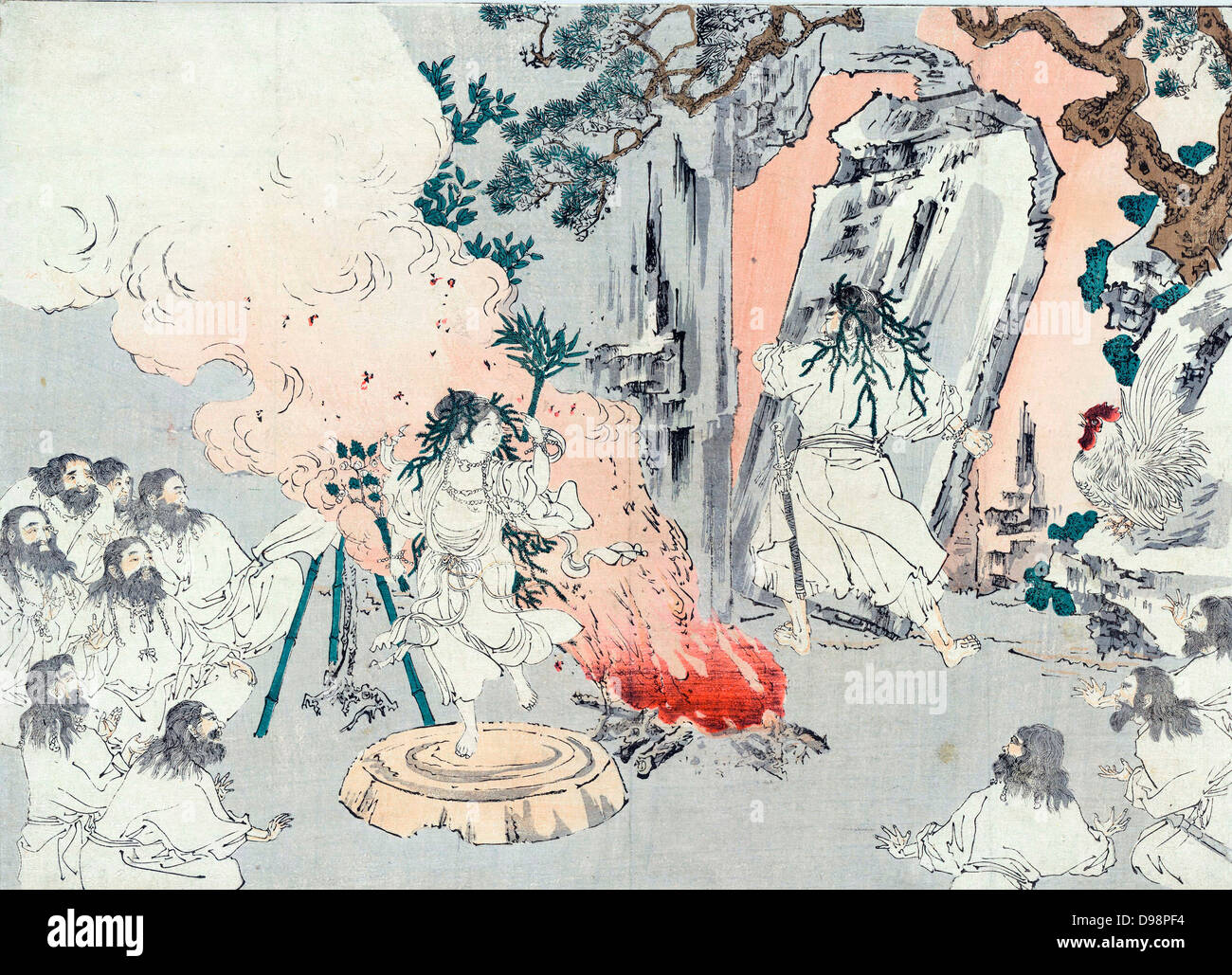 Gate to Amaterasu's cave. Warrior moves the stone gate in front of A cave while woman dances in hope of enticing Amaterasu, Shinto sun goddess, to make an appearance. Anonymous Japanese print c1900. Stock Photohttps://www.alamy.com/image-license-details/?v=1https://www.alamy.com/stock-photo-gate-to-amaterasus-cave-warrior-moves-the-stone-gate-in-front-of-a-57356296.html
Gate to Amaterasu's cave. Warrior moves the stone gate in front of A cave while woman dances in hope of enticing Amaterasu, Shinto sun goddess, to make an appearance. Anonymous Japanese print c1900. Stock Photohttps://www.alamy.com/image-license-details/?v=1https://www.alamy.com/stock-photo-gate-to-amaterasus-cave-warrior-moves-the-stone-gate-in-front-of-a-57356296.htmlRMD98PF4–Gate to Amaterasu's cave. Warrior moves the stone gate in front of A cave while woman dances in hope of enticing Amaterasu, Shinto sun goddess, to make an appearance. Anonymous Japanese print c1900.
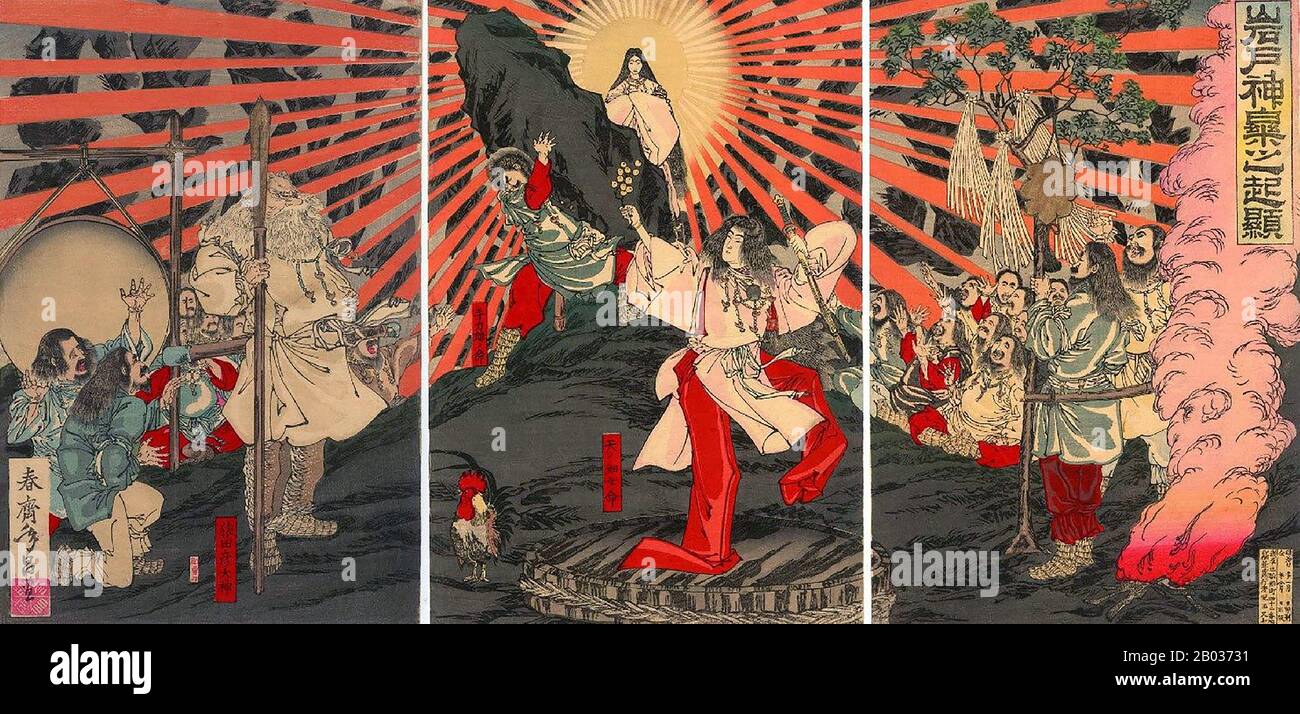 Amaterasu, sometimes called by her full name Amaterasu-omikami, is one of the most important deities in the Shinto religion. Goddess of the sun and the universe, Amaterasu's name means 'shining in heaven', while her full name translates to 'the great august kami (god) who shines in the heaven'. Amaterasu was born from the left eye of the creator god Izanagi as he purified himself from his attempt to save his wife Izanami from the underworld, Yomi. Her brother and later husband, the moon god Tsukuyomi, was born from Izanagi's right eye, while her other brother, the storm god Susanoo, was born Stock Photohttps://www.alamy.com/image-license-details/?v=1https://www.alamy.com/amaterasu-sometimes-called-by-her-full-name-amaterasu-omikami-is-one-of-the-most-important-deities-in-the-shinto-religion-goddess-of-the-sun-and-the-universe-amaterasus-name-means-shining-in-heaven-while-her-full-name-translates-to-the-great-august-kami-god-who-shines-in-the-heaven-amaterasu-was-born-from-the-left-eye-of-the-creator-god-izanagi-as-he-purified-himself-from-his-attempt-to-save-his-wife-izanami-from-the-underworld-yomi-her-brother-and-later-husband-the-moon-god-tsukuyomi-was-born-from-izanagis-right-eye-while-her-other-brother-the-storm-god-susanoo-was-born-image344278789.html
Amaterasu, sometimes called by her full name Amaterasu-omikami, is one of the most important deities in the Shinto religion. Goddess of the sun and the universe, Amaterasu's name means 'shining in heaven', while her full name translates to 'the great august kami (god) who shines in the heaven'. Amaterasu was born from the left eye of the creator god Izanagi as he purified himself from his attempt to save his wife Izanami from the underworld, Yomi. Her brother and later husband, the moon god Tsukuyomi, was born from Izanagi's right eye, while her other brother, the storm god Susanoo, was born Stock Photohttps://www.alamy.com/image-license-details/?v=1https://www.alamy.com/amaterasu-sometimes-called-by-her-full-name-amaterasu-omikami-is-one-of-the-most-important-deities-in-the-shinto-religion-goddess-of-the-sun-and-the-universe-amaterasus-name-means-shining-in-heaven-while-her-full-name-translates-to-the-great-august-kami-god-who-shines-in-the-heaven-amaterasu-was-born-from-the-left-eye-of-the-creator-god-izanagi-as-he-purified-himself-from-his-attempt-to-save-his-wife-izanami-from-the-underworld-yomi-her-brother-and-later-husband-the-moon-god-tsukuyomi-was-born-from-izanagis-right-eye-while-her-other-brother-the-storm-god-susanoo-was-born-image344278789.htmlRM2B03731–Amaterasu, sometimes called by her full name Amaterasu-omikami, is one of the most important deities in the Shinto religion. Goddess of the sun and the universe, Amaterasu's name means 'shining in heaven', while her full name translates to 'the great august kami (god) who shines in the heaven'. Amaterasu was born from the left eye of the creator god Izanagi as he purified himself from his attempt to save his wife Izanami from the underworld, Yomi. Her brother and later husband, the moon god Tsukuyomi, was born from Izanagi's right eye, while her other brother, the storm god Susanoo, was born
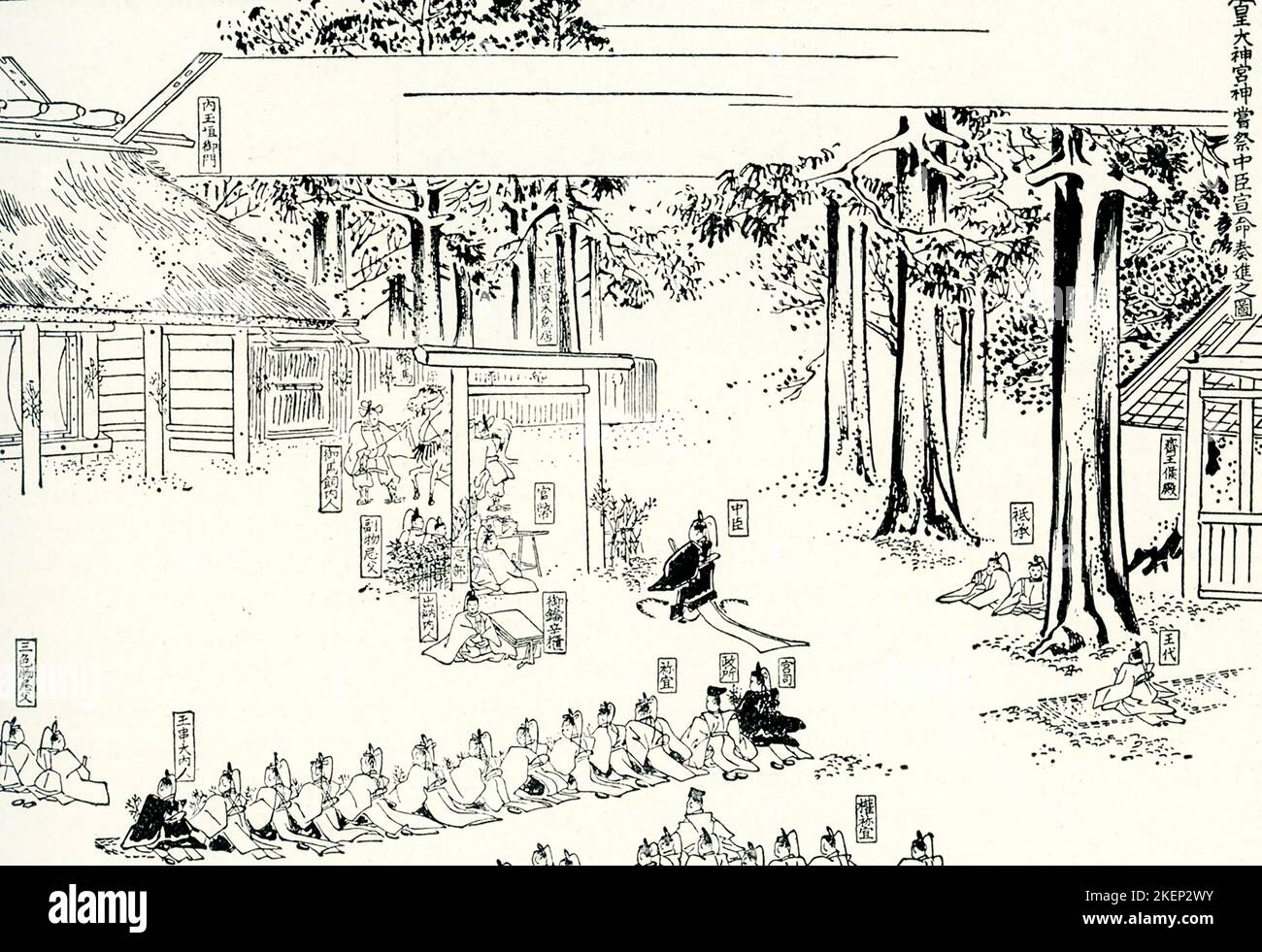 This 1910 image shows the festival of the goddess - the bringing of the first gifts to the temple of the sun goddess Amaterasu at Ise in Japan. The Ise Grand Shrine or Ise Jingu, located in the heart of a sacred forest in the Mie Prefecture of Japan, is the most important Shinto shrine in the country and is dedicated to the sun goddess Amaterasu with a separate shrine dedicated to Toyouke, the food goddess. First built in 4 BC, the present-day structures are based on the buildings erected in the 7th century AD. In the Shinto religion, the indigenous religion of Japan, Amaterasu was the sun god Stock Photohttps://www.alamy.com/image-license-details/?v=1https://www.alamy.com/this-1910-image-shows-the-festival-of-the-goddess-the-bringing-of-the-first-gifts-to-the-temple-of-the-sun-goddess-amaterasu-at-ise-in-japan-the-ise-grand-shrine-or-ise-jingu-located-in-the-heart-of-a-sacred-forest-in-the-mie-prefecture-of-japan-is-the-most-important-shinto-shrine-in-the-country-and-is-dedicated-to-the-sun-goddess-amaterasu-with-a-separate-shrine-dedicated-to-toyouke-the-food-goddess-first-built-in-4-bc-the-present-day-structures-are-based-on-the-buildings-erected-in-the-7th-century-ad-in-the-shinto-religion-the-indigenous-religion-of-japan-amaterasu-was-the-sun-god-image490980727.html
This 1910 image shows the festival of the goddess - the bringing of the first gifts to the temple of the sun goddess Amaterasu at Ise in Japan. The Ise Grand Shrine or Ise Jingu, located in the heart of a sacred forest in the Mie Prefecture of Japan, is the most important Shinto shrine in the country and is dedicated to the sun goddess Amaterasu with a separate shrine dedicated to Toyouke, the food goddess. First built in 4 BC, the present-day structures are based on the buildings erected in the 7th century AD. In the Shinto religion, the indigenous religion of Japan, Amaterasu was the sun god Stock Photohttps://www.alamy.com/image-license-details/?v=1https://www.alamy.com/this-1910-image-shows-the-festival-of-the-goddess-the-bringing-of-the-first-gifts-to-the-temple-of-the-sun-goddess-amaterasu-at-ise-in-japan-the-ise-grand-shrine-or-ise-jingu-located-in-the-heart-of-a-sacred-forest-in-the-mie-prefecture-of-japan-is-the-most-important-shinto-shrine-in-the-country-and-is-dedicated-to-the-sun-goddess-amaterasu-with-a-separate-shrine-dedicated-to-toyouke-the-food-goddess-first-built-in-4-bc-the-present-day-structures-are-based-on-the-buildings-erected-in-the-7th-century-ad-in-the-shinto-religion-the-indigenous-religion-of-japan-amaterasu-was-the-sun-god-image490980727.htmlRF2KEP2WY–This 1910 image shows the festival of the goddess - the bringing of the first gifts to the temple of the sun goddess Amaterasu at Ise in Japan. The Ise Grand Shrine or Ise Jingu, located in the heart of a sacred forest in the Mie Prefecture of Japan, is the most important Shinto shrine in the country and is dedicated to the sun goddess Amaterasu with a separate shrine dedicated to Toyouke, the food goddess. First built in 4 BC, the present-day structures are based on the buildings erected in the 7th century AD. In the Shinto religion, the indigenous religion of Japan, Amaterasu was the sun god
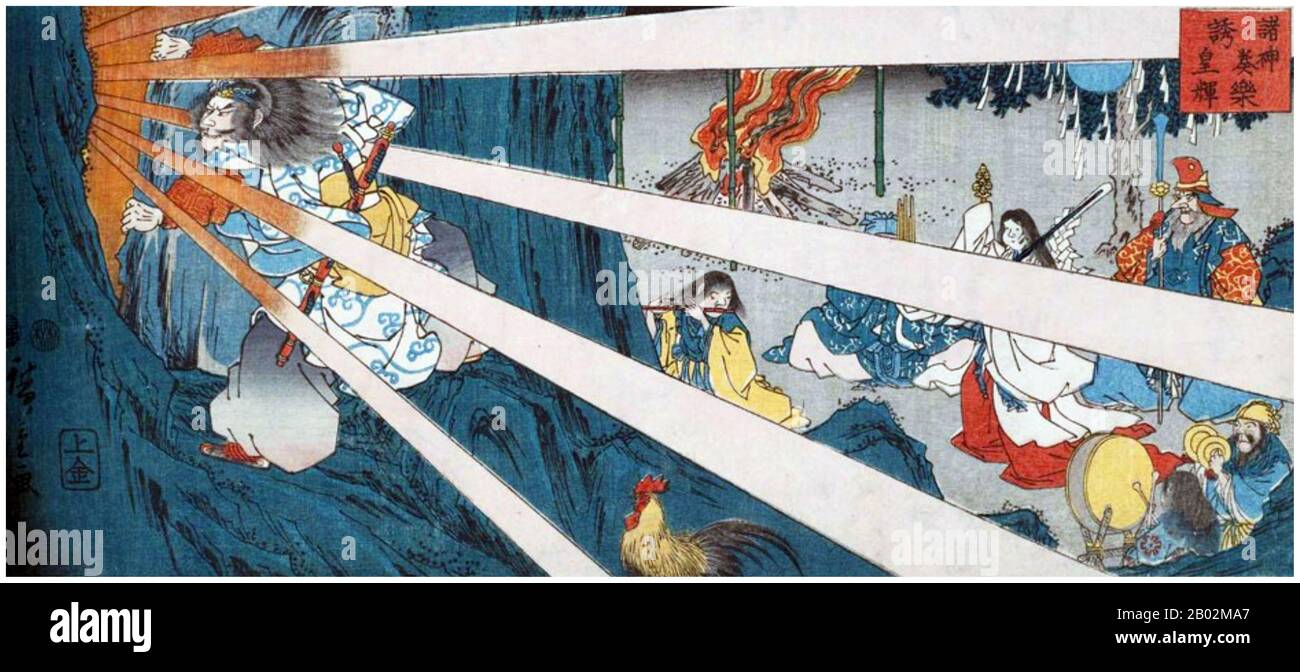 Amaterasu (天照), Amaterasu-ōmikami (天照大神/天照大御神) or Ōhirume-no-muchi-no-kami (大日孁貴神) is a part of the Japanese myth cycle and also a major deity of the Shinto religion. She is the goddess of the sun, but also of the universe. The name Amaterasu derived from Amateru meaning 'shining in heaven'. The meaning of her whole name, Amaterasu-ōmikami, is 'the great august kami (God) who shines in the heaven'. The Emperor of Japan is said to be a direct descendant of Amaterasu. Ama-no-Iwato (天岩戸) literally means 'The cave of the sun goddess' or 'heavenly rock cave'. In Japanese mythology, Susanoo, the Stock Photohttps://www.alamy.com/image-license-details/?v=1https://www.alamy.com/amaterasu-amaterasu-mikami-or-hirume-no-muchi-no-kami-is-a-part-of-the-japanese-myth-cycle-and-also-a-major-deity-of-the-shinto-religion-she-is-the-goddess-of-the-sun-but-also-of-the-universe-the-name-amaterasu-derived-from-amateru-meaning-shining-in-heaven-the-meaning-of-her-whole-name-amaterasu-mikami-is-the-great-august-kami-god-who-shines-in-the-heaven-the-emperor-of-japan-is-said-to-be-a-direct-descendant-of-amaterasu-ama-no-iwato-literally-means-the-cave-of-the-sun-goddess-or-heavenly-rock-cave-in-japanese-mythology-susanoo-the-image344267231.html
Amaterasu (天照), Amaterasu-ōmikami (天照大神/天照大御神) or Ōhirume-no-muchi-no-kami (大日孁貴神) is a part of the Japanese myth cycle and also a major deity of the Shinto religion. She is the goddess of the sun, but also of the universe. The name Amaterasu derived from Amateru meaning 'shining in heaven'. The meaning of her whole name, Amaterasu-ōmikami, is 'the great august kami (God) who shines in the heaven'. The Emperor of Japan is said to be a direct descendant of Amaterasu. Ama-no-Iwato (天岩戸) literally means 'The cave of the sun goddess' or 'heavenly rock cave'. In Japanese mythology, Susanoo, the Stock Photohttps://www.alamy.com/image-license-details/?v=1https://www.alamy.com/amaterasu-amaterasu-mikami-or-hirume-no-muchi-no-kami-is-a-part-of-the-japanese-myth-cycle-and-also-a-major-deity-of-the-shinto-religion-she-is-the-goddess-of-the-sun-but-also-of-the-universe-the-name-amaterasu-derived-from-amateru-meaning-shining-in-heaven-the-meaning-of-her-whole-name-amaterasu-mikami-is-the-great-august-kami-god-who-shines-in-the-heaven-the-emperor-of-japan-is-said-to-be-a-direct-descendant-of-amaterasu-ama-no-iwato-literally-means-the-cave-of-the-sun-goddess-or-heavenly-rock-cave-in-japanese-mythology-susanoo-the-image344267231.htmlRM2B02MA7–Amaterasu (天照), Amaterasu-ōmikami (天照大神/天照大御神) or Ōhirume-no-muchi-no-kami (大日孁貴神) is a part of the Japanese myth cycle and also a major deity of the Shinto religion. She is the goddess of the sun, but also of the universe. The name Amaterasu derived from Amateru meaning 'shining in heaven'. The meaning of her whole name, Amaterasu-ōmikami, is 'the great august kami (God) who shines in the heaven'. The Emperor of Japan is said to be a direct descendant of Amaterasu. Ama-no-Iwato (天岩戸) literally means 'The cave of the sun goddess' or 'heavenly rock cave'. In Japanese mythology, Susanoo, the
 Nishiki brocade with Amaterasu Kotai Jingu Shinto shrine Nis Stock Photohttps://www.alamy.com/image-license-details/?v=1https://www.alamy.com/stock-photo-nishiki-brocade-with-amaterasu-kotai-jingu-shinto-shrine-nis-83178514.html
Nishiki brocade with Amaterasu Kotai Jingu Shinto shrine Nis Stock Photohttps://www.alamy.com/image-license-details/?v=1https://www.alamy.com/stock-photo-nishiki-brocade-with-amaterasu-kotai-jingu-shinto-shrine-nis-83178514.htmlRMER9316–Nishiki brocade with Amaterasu Kotai Jingu Shinto shrine Nis
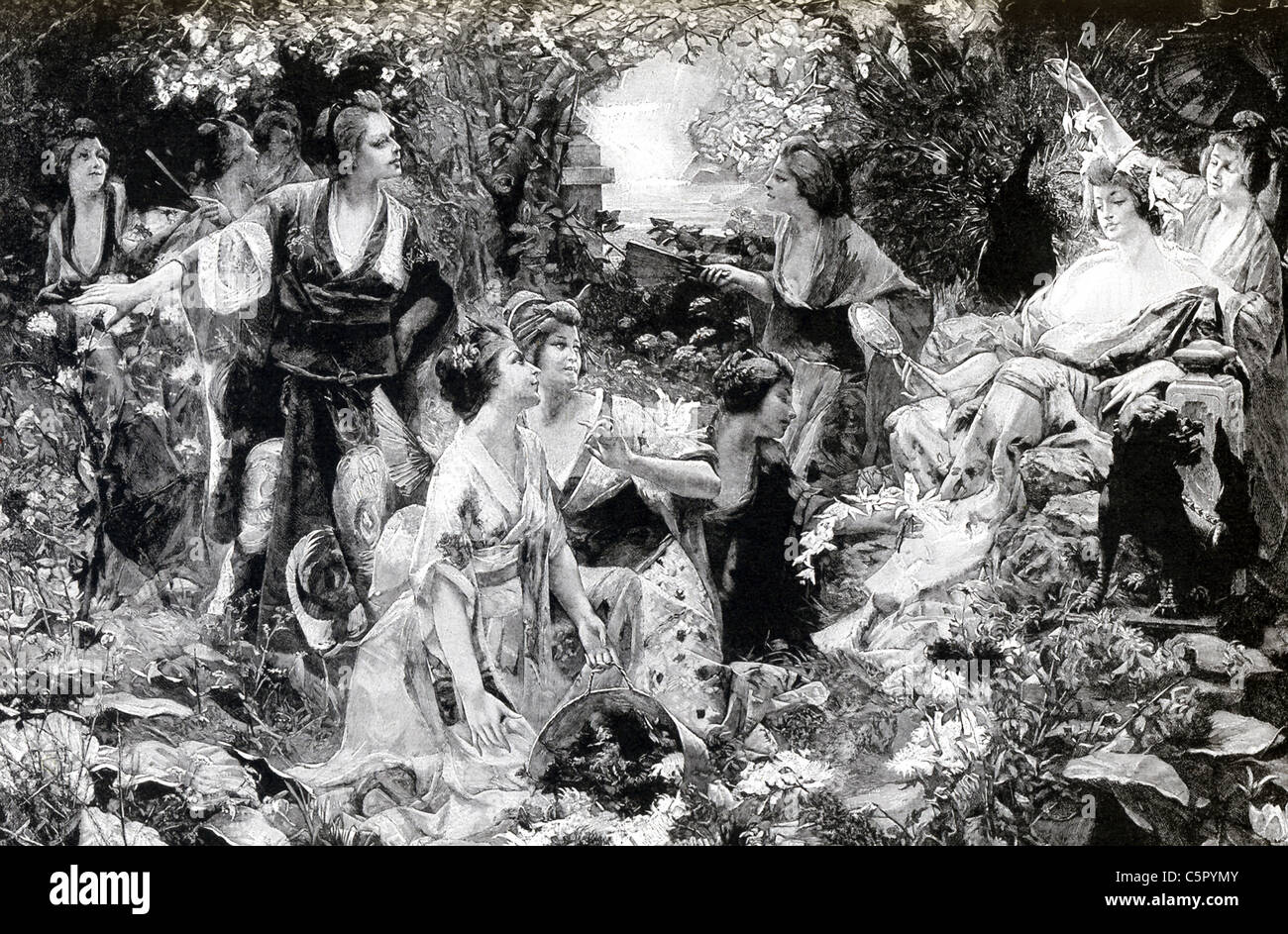 In the Shinto religion, the indigenous religion of Japan, Amaterasu was the sun goddess. Stock Photohttps://www.alamy.com/image-license-details/?v=1https://www.alamy.com/stock-photo-in-the-shinto-religion-the-indigenous-religion-of-japan-amaterasu-37998715.html
In the Shinto religion, the indigenous religion of Japan, Amaterasu was the sun goddess. Stock Photohttps://www.alamy.com/image-license-details/?v=1https://www.alamy.com/stock-photo-in-the-shinto-religion-the-indigenous-religion-of-japan-amaterasu-37998715.htmlRFC5PYMY–In the Shinto religion, the indigenous religion of Japan, Amaterasu was the sun goddess.
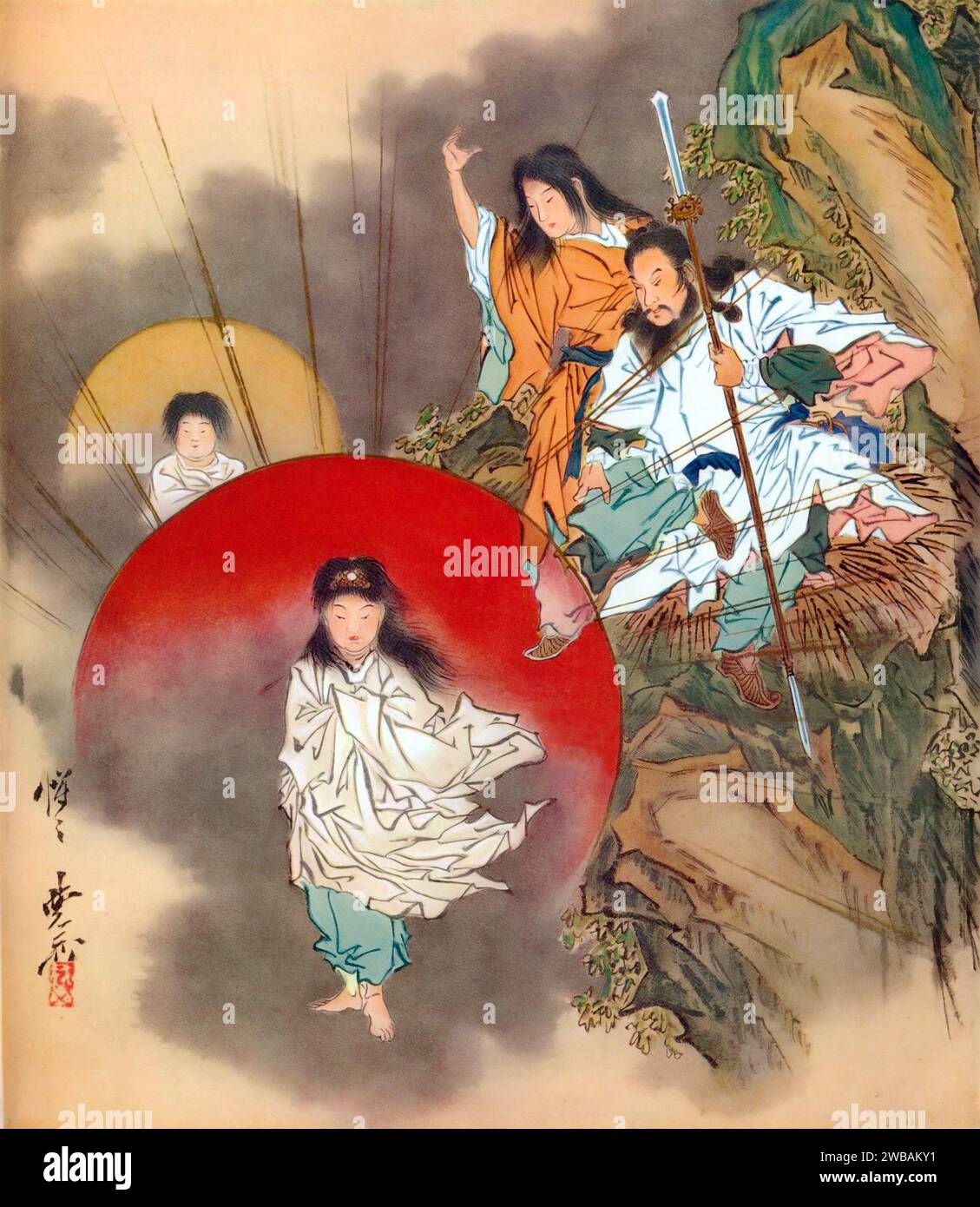 Amaterasu. Illustration entitled 'Installation of the Sun Goddess’. Amaterasu, also known as Amaterasu Ōmikami or Ōhirume no Muchi no Kami, is the goddess of the sun in Japanese mythology and often considered the chief deity (kami) of the Shinto pantheon, c. 1870 Stock Photohttps://www.alamy.com/image-license-details/?v=1https://www.alamy.com/amaterasu-illustration-entitled-installation-of-the-sun-goddess-amaterasu-also-known-as-amaterasu-mikami-or-hirume-no-muchi-no-kami-is-the-goddess-of-the-sun-in-japanese-mythology-and-often-considered-the-chief-deity-kami-of-the-shinto-pantheon-c-1870-image592148901.html
Amaterasu. Illustration entitled 'Installation of the Sun Goddess’. Amaterasu, also known as Amaterasu Ōmikami or Ōhirume no Muchi no Kami, is the goddess of the sun in Japanese mythology and often considered the chief deity (kami) of the Shinto pantheon, c. 1870 Stock Photohttps://www.alamy.com/image-license-details/?v=1https://www.alamy.com/amaterasu-illustration-entitled-installation-of-the-sun-goddess-amaterasu-also-known-as-amaterasu-mikami-or-hirume-no-muchi-no-kami-is-the-goddess-of-the-sun-in-japanese-mythology-and-often-considered-the-chief-deity-kami-of-the-shinto-pantheon-c-1870-image592148901.htmlRM2WBAKY1–Amaterasu. Illustration entitled 'Installation of the Sun Goddess’. Amaterasu, also known as Amaterasu Ōmikami or Ōhirume no Muchi no Kami, is the goddess of the sun in Japanese mythology and often considered the chief deity (kami) of the Shinto pantheon, c. 1870
 The 1910 image shows: “The sanctuary of the Sun Goddess at Ise.” The Ise Grand Shrine or Ise Jingu, located in the heart of a sacred forest in the Mie Prefecture of Japan, is the most important Shinto shrine in the country and is dedicated to the sun goddess Amaterasu with a separate shrine dedicated to Toyouke, the food goddess. First built in 4 BC, the present-day structures are based on the buildings erected in the 7th century AD. In the Shinto religion, the indigenous religion of Japan, Amaterasu was the sun goddess. Amaterasu was also believed to be linked with the imperial household in J Stock Photohttps://www.alamy.com/image-license-details/?v=1https://www.alamy.com/the-1910-image-shows-the-sanctuary-of-the-sun-goddess-at-ise-the-ise-grand-shrine-or-ise-jingu-located-in-the-heart-of-a-sacred-forest-in-the-mie-prefecture-of-japan-is-the-most-important-shinto-shrine-in-the-country-and-is-dedicated-to-the-sun-goddess-amaterasu-with-a-separate-shrine-dedicated-to-toyouke-the-food-goddess-first-built-in-4-bc-the-present-day-structures-are-based-on-the-buildings-erected-in-the-7th-century-ad-in-the-shinto-religion-the-indigenous-religion-of-japan-amaterasu-was-the-sun-goddess-amaterasu-was-also-believed-to-be-linked-with-the-imperial-household-in-j-image490980723.html
The 1910 image shows: “The sanctuary of the Sun Goddess at Ise.” The Ise Grand Shrine or Ise Jingu, located in the heart of a sacred forest in the Mie Prefecture of Japan, is the most important Shinto shrine in the country and is dedicated to the sun goddess Amaterasu with a separate shrine dedicated to Toyouke, the food goddess. First built in 4 BC, the present-day structures are based on the buildings erected in the 7th century AD. In the Shinto religion, the indigenous religion of Japan, Amaterasu was the sun goddess. Amaterasu was also believed to be linked with the imperial household in J Stock Photohttps://www.alamy.com/image-license-details/?v=1https://www.alamy.com/the-1910-image-shows-the-sanctuary-of-the-sun-goddess-at-ise-the-ise-grand-shrine-or-ise-jingu-located-in-the-heart-of-a-sacred-forest-in-the-mie-prefecture-of-japan-is-the-most-important-shinto-shrine-in-the-country-and-is-dedicated-to-the-sun-goddess-amaterasu-with-a-separate-shrine-dedicated-to-toyouke-the-food-goddess-first-built-in-4-bc-the-present-day-structures-are-based-on-the-buildings-erected-in-the-7th-century-ad-in-the-shinto-religion-the-indigenous-religion-of-japan-amaterasu-was-the-sun-goddess-amaterasu-was-also-believed-to-be-linked-with-the-imperial-household-in-j-image490980723.htmlRF2KEP2WR–The 1910 image shows: “The sanctuary of the Sun Goddess at Ise.” The Ise Grand Shrine or Ise Jingu, located in the heart of a sacred forest in the Mie Prefecture of Japan, is the most important Shinto shrine in the country and is dedicated to the sun goddess Amaterasu with a separate shrine dedicated to Toyouke, the food goddess. First built in 4 BC, the present-day structures are based on the buildings erected in the 7th century AD. In the Shinto religion, the indigenous religion of Japan, Amaterasu was the sun goddess. Amaterasu was also believed to be linked with the imperial household in J
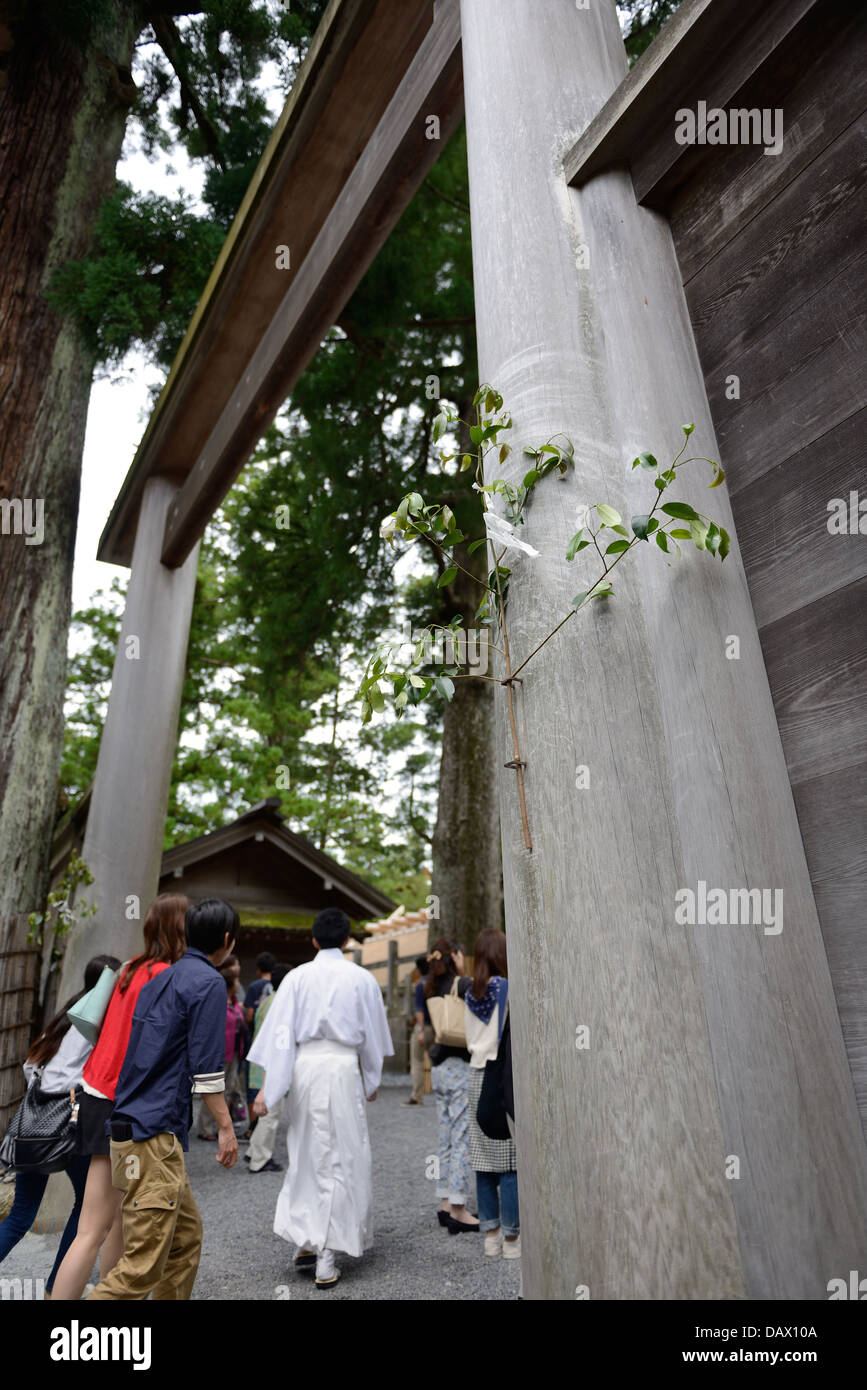 The main Shinto sanctuary Geku (外宮) known also as Toyouke Daijing located in Ise Grand Shrine complex, in Mie prefecture, Japan. Stock Photohttps://www.alamy.com/image-license-details/?v=1https://www.alamy.com/stock-photo-the-main-shinto-sanctuary-geku-known-also-as-toyouke-daijing-located-58349210.html
The main Shinto sanctuary Geku (外宮) known also as Toyouke Daijing located in Ise Grand Shrine complex, in Mie prefecture, Japan. Stock Photohttps://www.alamy.com/image-license-details/?v=1https://www.alamy.com/stock-photo-the-main-shinto-sanctuary-geku-known-also-as-toyouke-daijing-located-58349210.htmlRMDAX10A–The main Shinto sanctuary Geku (外宮) known also as Toyouke Daijing located in Ise Grand Shrine complex, in Mie prefecture, Japan.
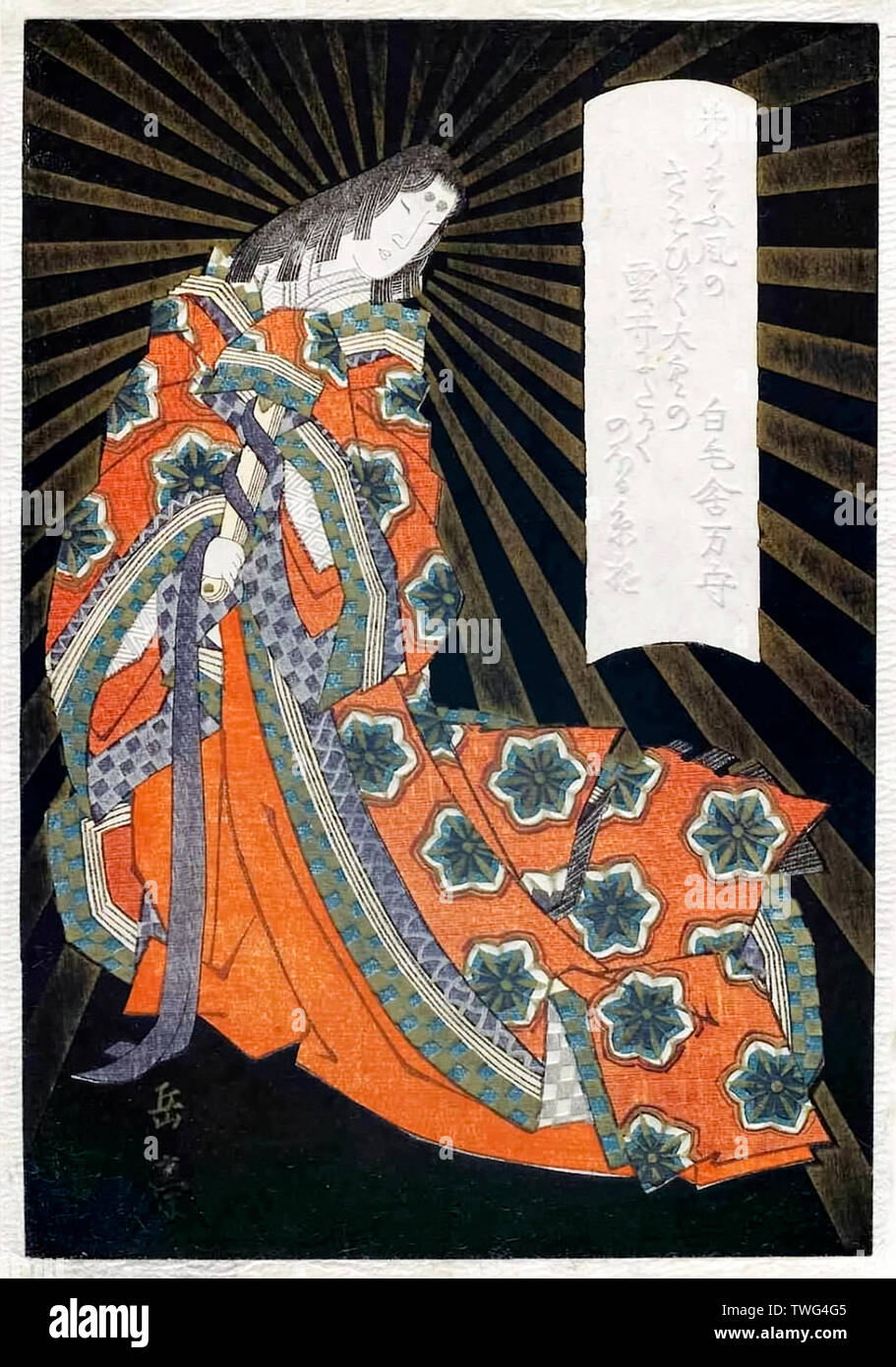 Amaterasu (Amaterasu Omikami or “shining in heaven”) goddess of the sun from Japanese mythology. Woodblock print by Yashima Gakutei (1786-1868). Stock Photohttps://www.alamy.com/image-license-details/?v=1https://www.alamy.com/amaterasu-amaterasu-omikami-or-shining-in-heaven-goddess-of-the-sun-from-japanese-mythology-woodblock-print-by-yashima-gakutei-1786-1868-image256666373.html
Amaterasu (Amaterasu Omikami or “shining in heaven”) goddess of the sun from Japanese mythology. Woodblock print by Yashima Gakutei (1786-1868). Stock Photohttps://www.alamy.com/image-license-details/?v=1https://www.alamy.com/amaterasu-amaterasu-omikami-or-shining-in-heaven-goddess-of-the-sun-from-japanese-mythology-woodblock-print-by-yashima-gakutei-1786-1868-image256666373.htmlRMTWG4G5–Amaterasu (Amaterasu Omikami or “shining in heaven”) goddess of the sun from Japanese mythology. Woodblock print by Yashima Gakutei (1786-1868).
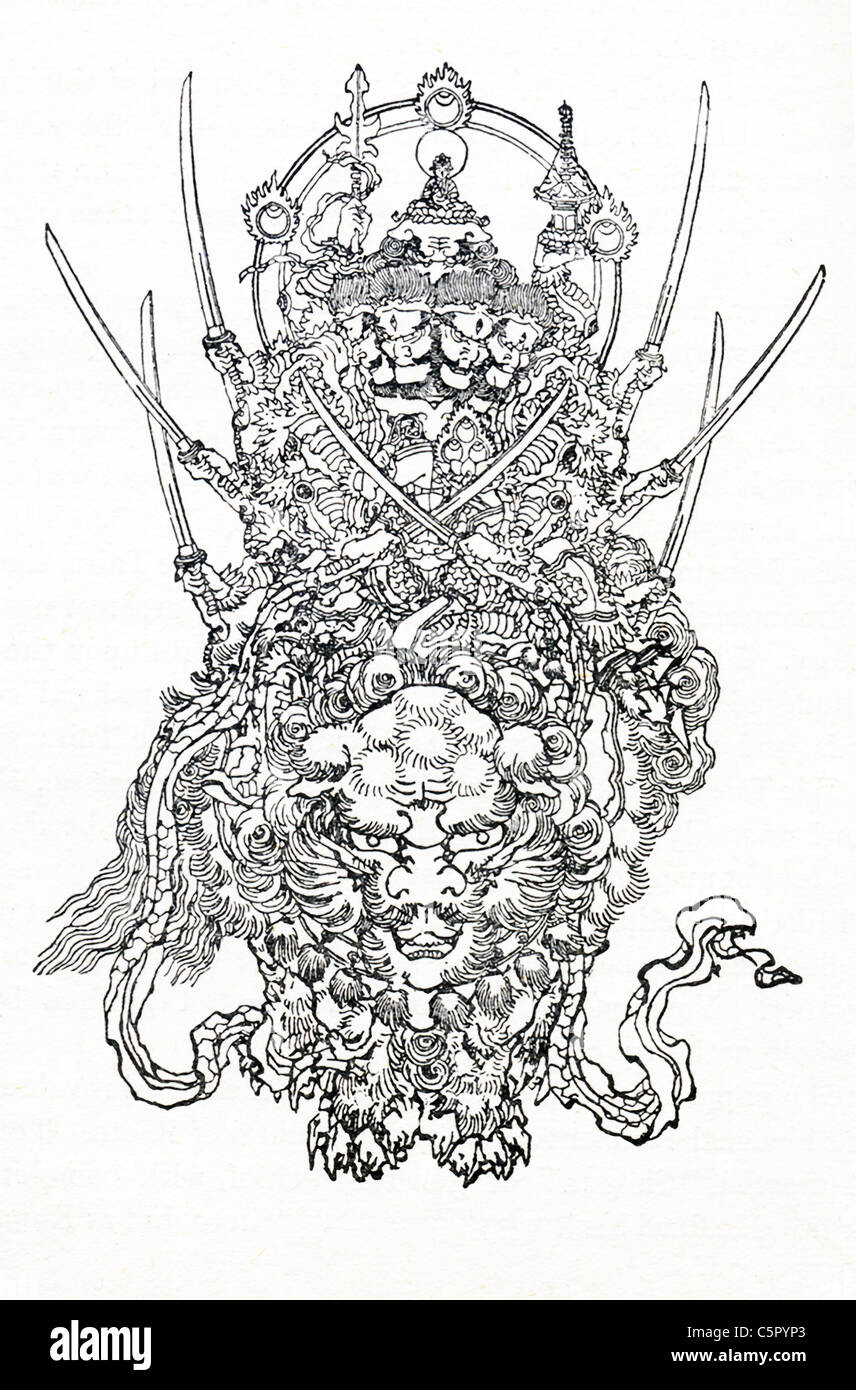 Japanese war god Futsunushi was a kami (spirit) of swords and lightning and served as a general for the sun goddess Amaterasu. Stock Photohttps://www.alamy.com/image-license-details/?v=1https://www.alamy.com/stock-photo-japanese-war-god-futsunushi-was-a-kami-spirit-of-swords-and-lightning-37998747.html
Japanese war god Futsunushi was a kami (spirit) of swords and lightning and served as a general for the sun goddess Amaterasu. Stock Photohttps://www.alamy.com/image-license-details/?v=1https://www.alamy.com/stock-photo-japanese-war-god-futsunushi-was-a-kami-spirit-of-swords-and-lightning-37998747.htmlRFC5PYP3–Japanese war god Futsunushi was a kami (spirit) of swords and lightning and served as a general for the sun goddess Amaterasu.
 Toyouke Daijingu Betsugu Tsuchinomiya, Shinto Shrine, (Ise Jingu Geku, Outer Shrine), Ise Grand Shrine, Ise, Mie, Japan Stock Photohttps://www.alamy.com/image-license-details/?v=1https://www.alamy.com/toyouke-daijingu-betsugu-tsuchinomiya-shinto-shrine-ise-jingu-geku-outer-shrine-ise-grand-shrine-ise-mie-japan-image502888033.html
Toyouke Daijingu Betsugu Tsuchinomiya, Shinto Shrine, (Ise Jingu Geku, Outer Shrine), Ise Grand Shrine, Ise, Mie, Japan Stock Photohttps://www.alamy.com/image-license-details/?v=1https://www.alamy.com/toyouke-daijingu-betsugu-tsuchinomiya-shinto-shrine-ise-jingu-geku-outer-shrine-ise-grand-shrine-ise-mie-japan-image502888033.htmlRM2M64EPW–Toyouke Daijingu Betsugu Tsuchinomiya, Shinto Shrine, (Ise Jingu Geku, Outer Shrine), Ise Grand Shrine, Ise, Mie, Japan
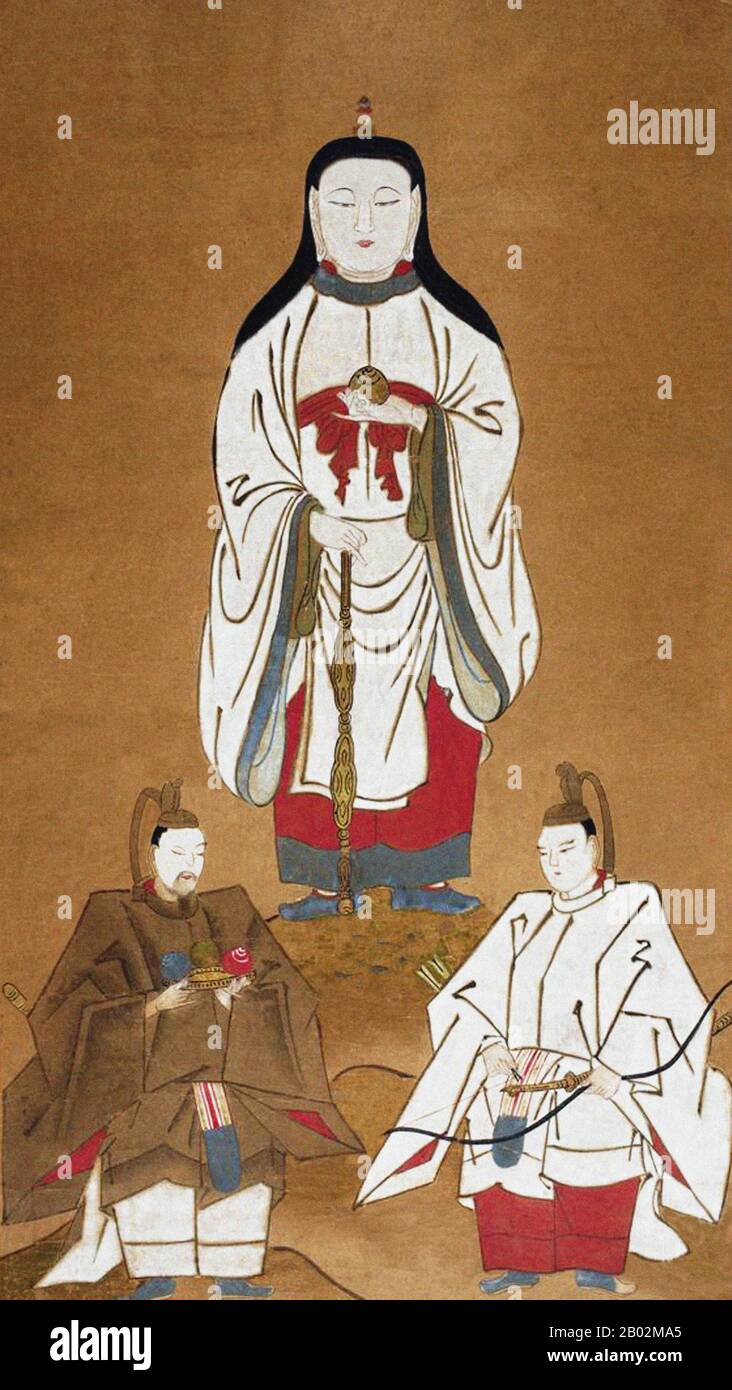 Amaterasu (天照), Amaterasu-ōmikami (天照大神/天照大御神) or Ōhirume-no-muchi-no-kami (大日孁貴神) is a part of the Japanese myth cycle and also a major deity of the Shinto religion. She is the goddess of the sun, but also of the universe. The name Amaterasu derived from Amateru meaning 'shining in heaven'. The meaning of her whole name, Amaterasu-ōmikami, is 'the great august kami (God) who shines in the heaven'. The Emperor of Japan is said to be a direct descendant of Amaterasu. Stock Photohttps://www.alamy.com/image-license-details/?v=1https://www.alamy.com/amaterasu-amaterasu-mikami-or-hirume-no-muchi-no-kami-is-a-part-of-the-japanese-myth-cycle-and-also-a-major-deity-of-the-shinto-religion-she-is-the-goddess-of-the-sun-but-also-of-the-universe-the-name-amaterasu-derived-from-amateru-meaning-shining-in-heaven-the-meaning-of-her-whole-name-amaterasu-mikami-is-the-great-august-kami-god-who-shines-in-the-heaven-the-emperor-of-japan-is-said-to-be-a-direct-descendant-of-amaterasu-image344267229.html
Amaterasu (天照), Amaterasu-ōmikami (天照大神/天照大御神) or Ōhirume-no-muchi-no-kami (大日孁貴神) is a part of the Japanese myth cycle and also a major deity of the Shinto religion. She is the goddess of the sun, but also of the universe. The name Amaterasu derived from Amateru meaning 'shining in heaven'. The meaning of her whole name, Amaterasu-ōmikami, is 'the great august kami (God) who shines in the heaven'. The Emperor of Japan is said to be a direct descendant of Amaterasu. Stock Photohttps://www.alamy.com/image-license-details/?v=1https://www.alamy.com/amaterasu-amaterasu-mikami-or-hirume-no-muchi-no-kami-is-a-part-of-the-japanese-myth-cycle-and-also-a-major-deity-of-the-shinto-religion-she-is-the-goddess-of-the-sun-but-also-of-the-universe-the-name-amaterasu-derived-from-amateru-meaning-shining-in-heaven-the-meaning-of-her-whole-name-amaterasu-mikami-is-the-great-august-kami-god-who-shines-in-the-heaven-the-emperor-of-japan-is-said-to-be-a-direct-descendant-of-amaterasu-image344267229.htmlRM2B02MA5–Amaterasu (天照), Amaterasu-ōmikami (天照大神/天照大御神) or Ōhirume-no-muchi-no-kami (大日孁貴神) is a part of the Japanese myth cycle and also a major deity of the Shinto religion. She is the goddess of the sun, but also of the universe. The name Amaterasu derived from Amateru meaning 'shining in heaven'. The meaning of her whole name, Amaterasu-ōmikami, is 'the great august kami (God) who shines in the heaven'. The Emperor of Japan is said to be a direct descendant of Amaterasu.
 March 26, 2023: Kushida Shrine, a Shinto shrine founded in 757 and located in Hakata ku, Fukuoka, Japan. It is dedicated to the gods of Ohatanushi no Stock Photohttps://www.alamy.com/image-license-details/?v=1https://www.alamy.com/march-26-2023-kushida-shrine-a-shinto-shrine-founded-in-757-and-located-in-hakata-ku-fukuoka-japan-it-is-dedicated-to-the-gods-of-ohatanushi-no-image545772533.html
March 26, 2023: Kushida Shrine, a Shinto shrine founded in 757 and located in Hakata ku, Fukuoka, Japan. It is dedicated to the gods of Ohatanushi no Stock Photohttps://www.alamy.com/image-license-details/?v=1https://www.alamy.com/march-26-2023-kushida-shrine-a-shinto-shrine-founded-in-757-and-located-in-hakata-ku-fukuoka-japan-it-is-dedicated-to-the-gods-of-ohatanushi-no-image545772533.htmlRF2PKX2C5–March 26, 2023: Kushida Shrine, a Shinto shrine founded in 757 and located in Hakata ku, Fukuoka, Japan. It is dedicated to the gods of Ohatanushi no
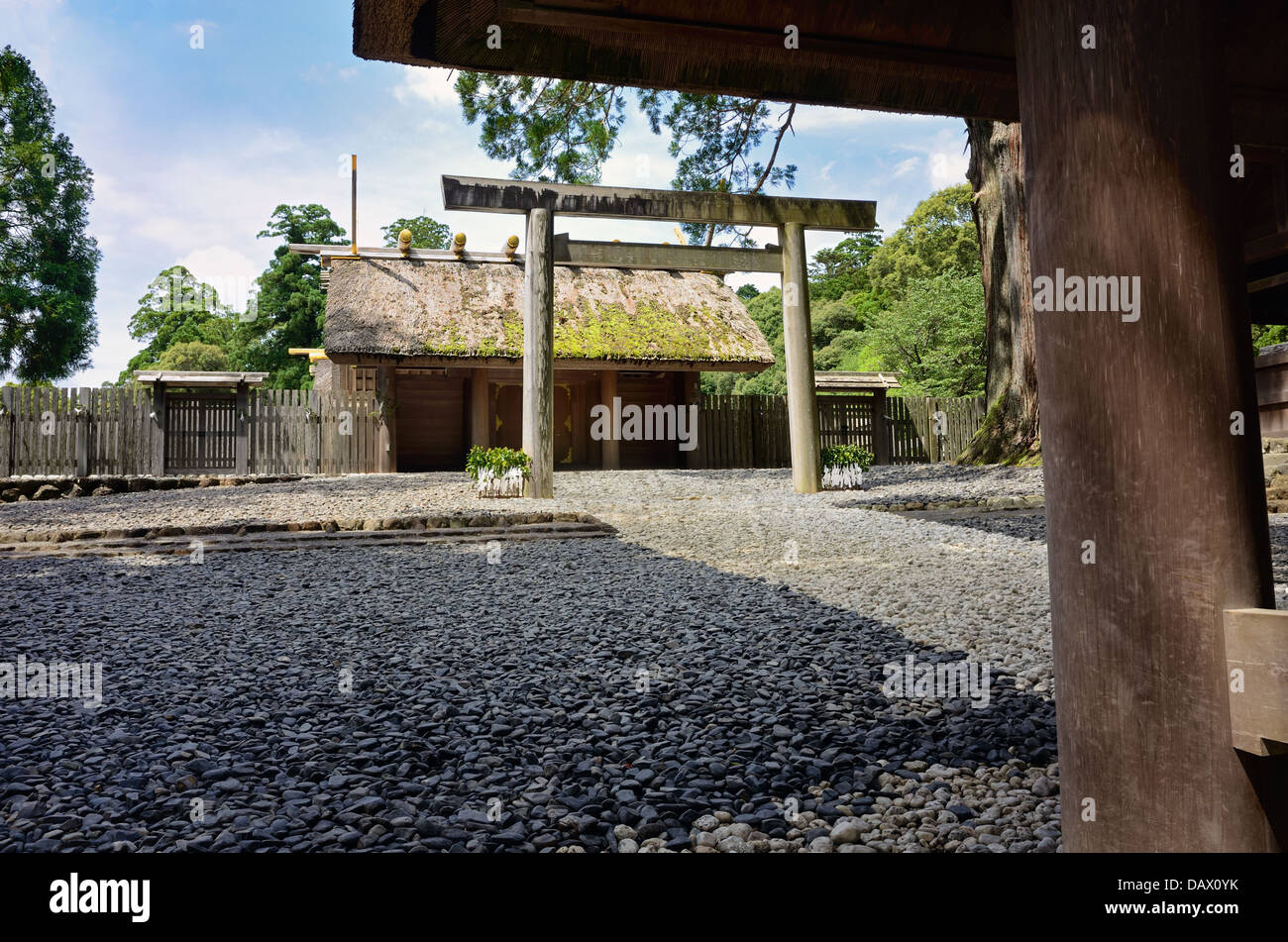 The main Shinto sanctuary Naikū (内宮) located in Ise Grand Shrine complex, in Mie prefecture, Japan. Stock Photohttps://www.alamy.com/image-license-details/?v=1https://www.alamy.com/stock-photo-the-main-shinto-sanctuary-naik-located-in-ise-grand-shrine-complex-58349191.html
The main Shinto sanctuary Naikū (内宮) located in Ise Grand Shrine complex, in Mie prefecture, Japan. Stock Photohttps://www.alamy.com/image-license-details/?v=1https://www.alamy.com/stock-photo-the-main-shinto-sanctuary-naik-located-in-ise-grand-shrine-complex-58349191.htmlRMDAX0YK–The main Shinto sanctuary Naikū (内宮) located in Ise Grand Shrine complex, in Mie prefecture, Japan.
 Ise Jingu Shrine Stock Photohttps://www.alamy.com/image-license-details/?v=1https://www.alamy.com/ise-jingu-shrine-image559603380.html
Ise Jingu Shrine Stock Photohttps://www.alamy.com/image-license-details/?v=1https://www.alamy.com/ise-jingu-shrine-image559603380.htmlRM2REC3R0–Ise Jingu Shrine
 The main Shinto sanctuary Geku (外宮) known also as Toyouke Daijingu located in Ise Grand Shrine complex, in Mie Japan. Stock Photohttps://www.alamy.com/image-license-details/?v=1https://www.alamy.com/stock-photo-the-main-shinto-sanctuary-geku-known-also-as-toyouke-daijingu-located-48127460.html
The main Shinto sanctuary Geku (外宮) known also as Toyouke Daijingu located in Ise Grand Shrine complex, in Mie Japan. Stock Photohttps://www.alamy.com/image-license-details/?v=1https://www.alamy.com/stock-photo-the-main-shinto-sanctuary-geku-known-also-as-toyouke-daijingu-located-48127460.htmlRMCP8B1T–The main Shinto sanctuary Geku (外宮) known also as Toyouke Daijingu located in Ise Grand Shrine complex, in Mie Japan.
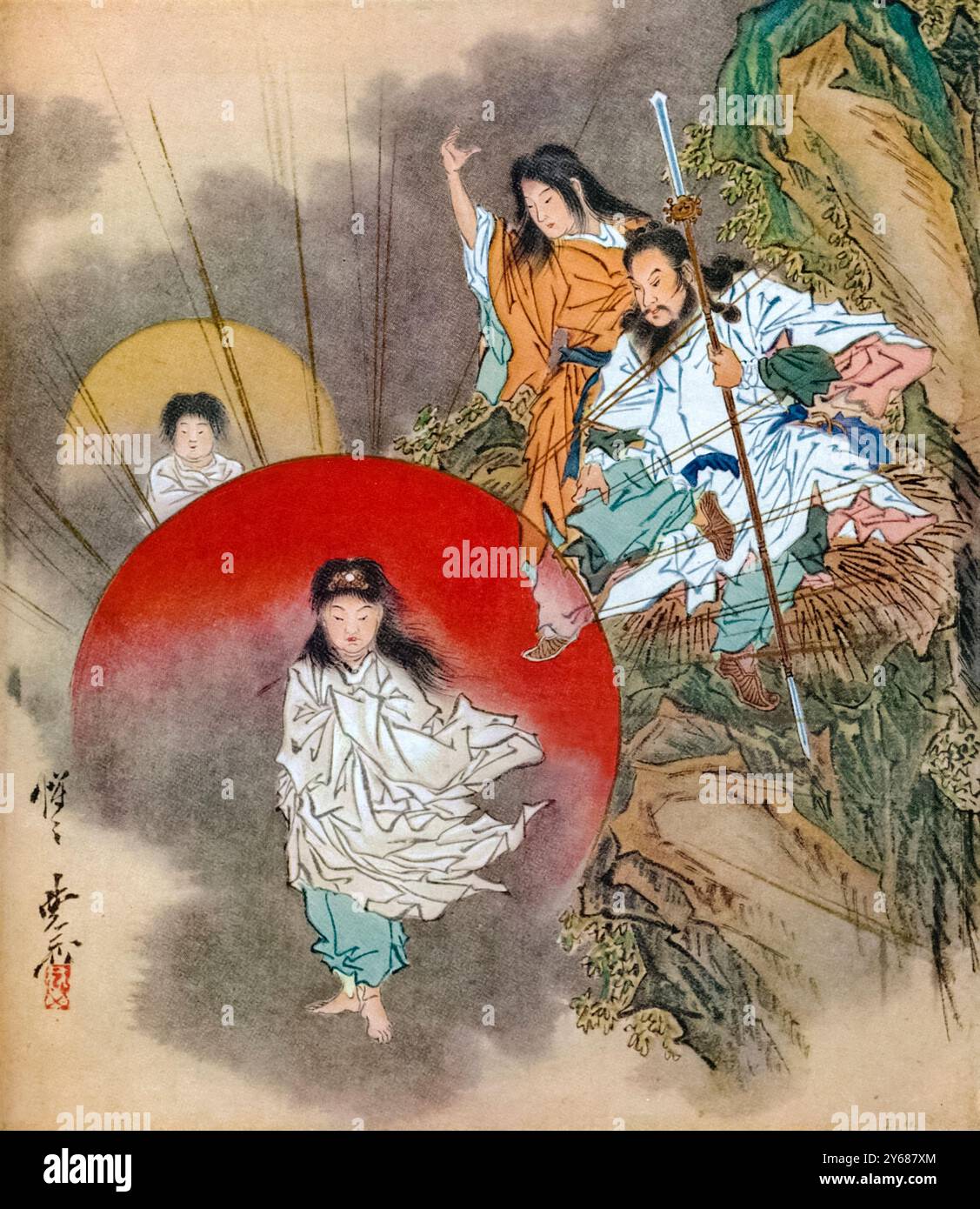 Installation of the Sun Goddess circa 1870,. Artist unknown showing Amaterasu Ōmikami, the revered sun goddess of Japanese mythology with her sibling Tsukuyomi, the moon deity behind and her parents Izanami and Izanagi to her right. Stock Photohttps://www.alamy.com/image-license-details/?v=1https://www.alamy.com/installation-of-the-sun-goddess-circa-1870-artist-unknown-showing-amaterasu-mikami-the-revered-sun-goddess-of-japanese-mythology-with-her-sibling-tsukuyomi-the-moon-deity-behind-and-her-parents-izanami-and-izanagi-to-her-right-image623443036.html
Installation of the Sun Goddess circa 1870,. Artist unknown showing Amaterasu Ōmikami, the revered sun goddess of Japanese mythology with her sibling Tsukuyomi, the moon deity behind and her parents Izanami and Izanagi to her right. Stock Photohttps://www.alamy.com/image-license-details/?v=1https://www.alamy.com/installation-of-the-sun-goddess-circa-1870-artist-unknown-showing-amaterasu-mikami-the-revered-sun-goddess-of-japanese-mythology-with-her-sibling-tsukuyomi-the-moon-deity-behind-and-her-parents-izanami-and-izanagi-to-her-right-image623443036.htmlRM2Y687XM–Installation of the Sun Goddess circa 1870,. Artist unknown showing Amaterasu Ōmikami, the revered sun goddess of Japanese mythology with her sibling Tsukuyomi, the moon deity behind and her parents Izanami and Izanagi to her right.
![[ 1930s Japan - Japanese Sun Goddess ] — An early 20th century depiction of Amaterasu Omikami. The sun goddess is one of the principal Shinto deities in Japanese mythology. 20th century vintage print. Stock Photo [ 1930s Japan - Japanese Sun Goddess ] — An early 20th century depiction of Amaterasu Omikami. The sun goddess is one of the principal Shinto deities in Japanese mythology. 20th century vintage print. Stock Photo](https://c8.alamy.com/comp/W2N0A8/1930s-japan-japanese-sun-goddess-an-early-20th-century-depiction-of-amaterasu-omikami-the-sun-goddess-is-one-of-the-principal-shinto-deities-in-japanese-mythology-20th-century-vintage-print-W2N0A8.jpg) [ 1930s Japan - Japanese Sun Goddess ] — An early 20th century depiction of Amaterasu Omikami. The sun goddess is one of the principal Shinto deities in Japanese mythology. 20th century vintage print. Stock Photohttps://www.alamy.com/image-license-details/?v=1https://www.alamy.com/1930s-japan-japanese-sun-goddess-an-early-20th-century-depiction-of-amaterasu-omikami-the-sun-goddess-is-one-of-the-principal-shinto-deities-in-japanese-mythology-20th-century-vintage-print-image259846112.html
[ 1930s Japan - Japanese Sun Goddess ] — An early 20th century depiction of Amaterasu Omikami. The sun goddess is one of the principal Shinto deities in Japanese mythology. 20th century vintage print. Stock Photohttps://www.alamy.com/image-license-details/?v=1https://www.alamy.com/1930s-japan-japanese-sun-goddess-an-early-20th-century-depiction-of-amaterasu-omikami-the-sun-goddess-is-one-of-the-principal-shinto-deities-in-japanese-mythology-20th-century-vintage-print-image259846112.htmlRMW2N0A8–[ 1930s Japan - Japanese Sun Goddess ] — An early 20th century depiction of Amaterasu Omikami. The sun goddess is one of the principal Shinto deities in Japanese mythology. 20th century vintage print.
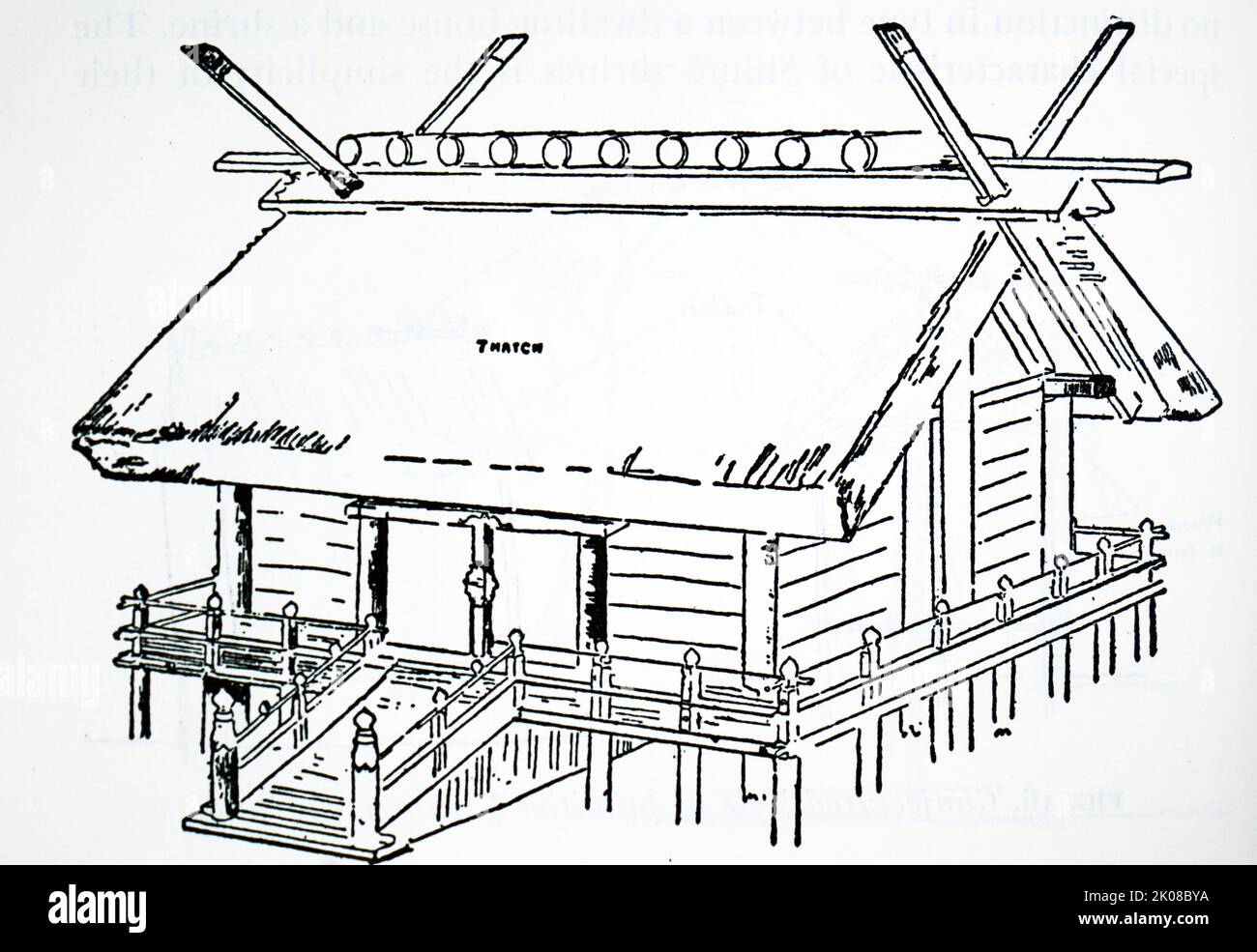 The Ise Grand Shrine, located in Ise, Mie Prefecture of Japan, is a Shinto shrine dedicated to the sun goddess Amaterasu. Officially known simply as Jingu, Ise Jingu is a shrine complex composed of many Shinto shrines centered on two main shrines, Naiku and Geku. Sketch showing the design of the main shrine at Yamada Stock Photohttps://www.alamy.com/image-license-details/?v=1https://www.alamy.com/the-ise-grand-shrine-located-in-ise-mie-prefecture-of-japan-is-a-shinto-shrine-dedicated-to-the-sun-goddess-amaterasu-officially-known-simply-as-jingu-ise-jingu-is-a-shrine-complex-composed-of-many-shinto-shrines-centered-on-two-main-shrines-naiku-and-geku-sketch-showing-the-design-of-the-main-shrine-at-yamada-image482075310.html
The Ise Grand Shrine, located in Ise, Mie Prefecture of Japan, is a Shinto shrine dedicated to the sun goddess Amaterasu. Officially known simply as Jingu, Ise Jingu is a shrine complex composed of many Shinto shrines centered on two main shrines, Naiku and Geku. Sketch showing the design of the main shrine at Yamada Stock Photohttps://www.alamy.com/image-license-details/?v=1https://www.alamy.com/the-ise-grand-shrine-located-in-ise-mie-prefecture-of-japan-is-a-shinto-shrine-dedicated-to-the-sun-goddess-amaterasu-officially-known-simply-as-jingu-ise-jingu-is-a-shrine-complex-composed-of-many-shinto-shrines-centered-on-two-main-shrines-naiku-and-geku-sketch-showing-the-design-of-the-main-shrine-at-yamada-image482075310.htmlRM2K08BYA–The Ise Grand Shrine, located in Ise, Mie Prefecture of Japan, is a Shinto shrine dedicated to the sun goddess Amaterasu. Officially known simply as Jingu, Ise Jingu is a shrine complex composed of many Shinto shrines centered on two main shrines, Naiku and Geku. Sketch showing the design of the main shrine at Yamada
![[ 1900s Japan - Ise Grand Shrine ] — Shrine visitors cleanse their hands before visiting the sacred Naiku shrine at Ise Grand Shrine (伊勢神宮, Ise Jingu), a Shinto shrine dedicated to the sun goddess Amaterasu, in Ise, Mie prefecture. 20th century vintage postcard. Stock Photo [ 1900s Japan - Ise Grand Shrine ] — Shrine visitors cleanse their hands before visiting the sacred Naiku shrine at Ise Grand Shrine (伊勢神宮, Ise Jingu), a Shinto shrine dedicated to the sun goddess Amaterasu, in Ise, Mie prefecture. 20th century vintage postcard. Stock Photo](https://c8.alamy.com/comp/2BMFGC6/1900s-japan-ise-grand-shrine-shrine-visitors-cleanse-their-hands-before-visiting-the-sacred-naiku-shrine-at-ise-grand-shrine-ise-jingu-a-shinto-shrine-dedicated-to-the-sun-goddess-amaterasu-in-ise-mie-prefecture-20th-century-vintage-postcard-2BMFGC6.jpg) [ 1900s Japan - Ise Grand Shrine ] — Shrine visitors cleanse their hands before visiting the sacred Naiku shrine at Ise Grand Shrine (伊勢神宮, Ise Jingu), a Shinto shrine dedicated to the sun goddess Amaterasu, in Ise, Mie prefecture. 20th century vintage postcard. Stock Photohttps://www.alamy.com/image-license-details/?v=1https://www.alamy.com/1900s-japan-ise-grand-shrine-shrine-visitors-cleanse-their-hands-before-visiting-the-sacred-naiku-shrine-at-ise-grand-shrine-ise-jingu-a-shinto-shrine-dedicated-to-the-sun-goddess-amaterasu-in-ise-mie-prefecture-20th-century-vintage-postcard-image356842646.html
[ 1900s Japan - Ise Grand Shrine ] — Shrine visitors cleanse their hands before visiting the sacred Naiku shrine at Ise Grand Shrine (伊勢神宮, Ise Jingu), a Shinto shrine dedicated to the sun goddess Amaterasu, in Ise, Mie prefecture. 20th century vintage postcard. Stock Photohttps://www.alamy.com/image-license-details/?v=1https://www.alamy.com/1900s-japan-ise-grand-shrine-shrine-visitors-cleanse-their-hands-before-visiting-the-sacred-naiku-shrine-at-ise-grand-shrine-ise-jingu-a-shinto-shrine-dedicated-to-the-sun-goddess-amaterasu-in-ise-mie-prefecture-20th-century-vintage-postcard-image356842646.htmlRM2BMFGC6–[ 1900s Japan - Ise Grand Shrine ] — Shrine visitors cleanse their hands before visiting the sacred Naiku shrine at Ise Grand Shrine (伊勢神宮, Ise Jingu), a Shinto shrine dedicated to the sun goddess Amaterasu, in Ise, Mie prefecture. 20th century vintage postcard.
 Shinto Temple (Ise Grand Shrine) Shokonsha, Kudan, Tokio, line illlustration from Central Africa, Japan and Fiji published in 1882 by Hodder & Stought Stock Photohttps://www.alamy.com/image-license-details/?v=1https://www.alamy.com/shinto-temple-ise-grand-shrine-shokonsha-kudan-tokio-line-illlustration-from-central-africa-japan-and-fiji-published-in-1882-by-hodder-stought-image456610639.html
Shinto Temple (Ise Grand Shrine) Shokonsha, Kudan, Tokio, line illlustration from Central Africa, Japan and Fiji published in 1882 by Hodder & Stought Stock Photohttps://www.alamy.com/image-license-details/?v=1https://www.alamy.com/shinto-temple-ise-grand-shrine-shokonsha-kudan-tokio-line-illlustration-from-central-africa-japan-and-fiji-published-in-1882-by-hodder-stought-image456610639.htmlRF2HETBER–Shinto Temple (Ise Grand Shrine) Shokonsha, Kudan, Tokio, line illlustration from Central Africa, Japan and Fiji published in 1882 by Hodder & Stought
![[ 1910s Japan - Japanese Children at Shinto Shrine ] — A group of children and two adults stand below the gate at Iseyama Kotai-jingu Shrine, better known as Oise-san, in Yokohama, Kanagawa Prefecture. Built in 1870, the shrine is dedicated to Amaterasu Omikami (Sun Goddess). It is the grand guardian god shrine for Yokohama. 20th century vintage postcard. Stock Photo [ 1910s Japan - Japanese Children at Shinto Shrine ] — A group of children and two adults stand below the gate at Iseyama Kotai-jingu Shrine, better known as Oise-san, in Yokohama, Kanagawa Prefecture. Built in 1870, the shrine is dedicated to Amaterasu Omikami (Sun Goddess). It is the grand guardian god shrine for Yokohama. 20th century vintage postcard. Stock Photo](https://c8.alamy.com/comp/WP58BH/1910s-japan-japanese-children-at-shinto-shrine-a-group-of-children-and-two-adults-stand-below-the-gate-at-iseyama-kotai-jingu-shrine-better-known-as-oise-san-in-yokohama-kanagawa-prefecture-built-in-1870-the-shrine-is-dedicated-to-amaterasu-omikami-sun-goddess-it-is-the-grand-guardian-god-shrine-for-yokohama-20th-century-vintage-postcard-WP58BH.jpg) [ 1910s Japan - Japanese Children at Shinto Shrine ] — A group of children and two adults stand below the gate at Iseyama Kotai-jingu Shrine, better known as Oise-san, in Yokohama, Kanagawa Prefecture. Built in 1870, the shrine is dedicated to Amaterasu Omikami (Sun Goddess). It is the grand guardian god shrine for Yokohama. 20th century vintage postcard. Stock Photohttps://www.alamy.com/image-license-details/?v=1https://www.alamy.com/1910s-japan-japanese-children-at-shinto-shrine-a-group-of-children-and-two-adults-stand-below-the-gate-at-iseyama-kotai-jingu-shrine-better-known-as-oise-san-in-yokohama-kanagawa-prefecture-built-in-1870-the-shrine-is-dedicated-to-amaterasu-omikami-sun-goddess-it-is-the-grand-guardian-god-shrine-for-yokohama-20th-century-vintage-postcard-image271794309.html
[ 1910s Japan - Japanese Children at Shinto Shrine ] — A group of children and two adults stand below the gate at Iseyama Kotai-jingu Shrine, better known as Oise-san, in Yokohama, Kanagawa Prefecture. Built in 1870, the shrine is dedicated to Amaterasu Omikami (Sun Goddess). It is the grand guardian god shrine for Yokohama. 20th century vintage postcard. Stock Photohttps://www.alamy.com/image-license-details/?v=1https://www.alamy.com/1910s-japan-japanese-children-at-shinto-shrine-a-group-of-children-and-two-adults-stand-below-the-gate-at-iseyama-kotai-jingu-shrine-better-known-as-oise-san-in-yokohama-kanagawa-prefecture-built-in-1870-the-shrine-is-dedicated-to-amaterasu-omikami-sun-goddess-it-is-the-grand-guardian-god-shrine-for-yokohama-20th-century-vintage-postcard-image271794309.htmlRMWP58BH–[ 1910s Japan - Japanese Children at Shinto Shrine ] — A group of children and two adults stand below the gate at Iseyama Kotai-jingu Shrine, better known as Oise-san, in Yokohama, Kanagawa Prefecture. Built in 1870, the shrine is dedicated to Amaterasu Omikami (Sun Goddess). It is the grand guardian god shrine for Yokohama. 20th century vintage postcard.
 Omikuji fortune papers with picture of the god Tajikarao who lifted the rock door to free Amaterasu. Amanoiwato Jinja, Shinto Shrine, Takachiho, Kyush Stock Photohttps://www.alamy.com/image-license-details/?v=1https://www.alamy.com/omikuji-fortune-papers-with-picture-of-the-god-tajikarao-who-lifted-the-rock-door-to-free-amaterasu-amanoiwato-jinja-shinto-shrine-takachiho-kyush-image468841867.html
Omikuji fortune papers with picture of the god Tajikarao who lifted the rock door to free Amaterasu. Amanoiwato Jinja, Shinto Shrine, Takachiho, Kyush Stock Photohttps://www.alamy.com/image-license-details/?v=1https://www.alamy.com/omikuji-fortune-papers-with-picture-of-the-god-tajikarao-who-lifted-the-rock-door-to-free-amaterasu-amanoiwato-jinja-shinto-shrine-takachiho-kyush-image468841867.htmlRM2J6NGGB–Omikuji fortune papers with picture of the god Tajikarao who lifted the rock door to free Amaterasu. Amanoiwato Jinja, Shinto Shrine, Takachiho, Kyush
![[ 1920s Japan - First Census in Japan ] — Memorial card for Japan’s first nationwide population census, taken on October 1, 1920 (Taisho 9). The census revealed that the country had a population of 55.4 million. More than half of the population worked in primary industries. The card features an illustration of Amaterasu Omikami. The sun goddess is one of the principal Shinto deities in Japanese mythology. Japanese text: 第一回国勢調査記念 大正九年十月一日 20th century vintage postcard. Stock Photo [ 1920s Japan - First Census in Japan ] — Memorial card for Japan’s first nationwide population census, taken on October 1, 1920 (Taisho 9). The census revealed that the country had a population of 55.4 million. More than half of the population worked in primary industries. The card features an illustration of Amaterasu Omikami. The sun goddess is one of the principal Shinto deities in Japanese mythology. Japanese text: 第一回国勢調査記念 大正九年十月一日 20th century vintage postcard. Stock Photo](https://c8.alamy.com/comp/2C06T3Y/1920s-japan-first-census-in-japan-memorial-card-for-japans-first-nationwide-population-census-taken-on-october-1-1920-taisho-9-the-census-revealed-that-the-country-had-a-population-of-554-million-more-than-half-of-the-population-worked-in-primary-industries-the-card-features-an-illustration-of-amaterasu-omikami-the-sun-goddess-is-one-of-the-principal-shinto-deities-in-japanese-mythology-japanese-text-20th-century-vintage-postcard-2C06T3Y.jpg) [ 1920s Japan - First Census in Japan ] — Memorial card for Japan’s first nationwide population census, taken on October 1, 1920 (Taisho 9). The census revealed that the country had a population of 55.4 million. More than half of the population worked in primary industries. The card features an illustration of Amaterasu Omikami. The sun goddess is one of the principal Shinto deities in Japanese mythology. Japanese text: 第一回国勢調査記念 大正九年十月一日 20th century vintage postcard. Stock Photohttps://www.alamy.com/image-license-details/?v=1https://www.alamy.com/1920s-japan-first-census-in-japan-memorial-card-for-japans-first-nationwide-population-census-taken-on-october-1-1920-taisho-9-the-census-revealed-that-the-country-had-a-population-of-554-million-more-than-half-of-the-population-worked-in-primary-industries-the-card-features-an-illustration-of-amaterasu-omikami-the-sun-goddess-is-one-of-the-principal-shinto-deities-in-japanese-mythology-japanese-text-20th-century-vintage-postcard-image361568367.html
[ 1920s Japan - First Census in Japan ] — Memorial card for Japan’s first nationwide population census, taken on October 1, 1920 (Taisho 9). The census revealed that the country had a population of 55.4 million. More than half of the population worked in primary industries. The card features an illustration of Amaterasu Omikami. The sun goddess is one of the principal Shinto deities in Japanese mythology. Japanese text: 第一回国勢調査記念 大正九年十月一日 20th century vintage postcard. Stock Photohttps://www.alamy.com/image-license-details/?v=1https://www.alamy.com/1920s-japan-first-census-in-japan-memorial-card-for-japans-first-nationwide-population-census-taken-on-october-1-1920-taisho-9-the-census-revealed-that-the-country-had-a-population-of-554-million-more-than-half-of-the-population-worked-in-primary-industries-the-card-features-an-illustration-of-amaterasu-omikami-the-sun-goddess-is-one-of-the-principal-shinto-deities-in-japanese-mythology-japanese-text-20th-century-vintage-postcard-image361568367.htmlRM2C06T3Y–[ 1920s Japan - First Census in Japan ] — Memorial card for Japan’s first nationwide population census, taken on October 1, 1920 (Taisho 9). The census revealed that the country had a population of 55.4 million. More than half of the population worked in primary industries. The card features an illustration of Amaterasu Omikami. The sun goddess is one of the principal Shinto deities in Japanese mythology. Japanese text: 第一回国勢調査記念 大正九年十月一日 20th century vintage postcard.
![Nishiki brocade with Amaterasu Kotai Jingu Shinto shrine] [Nishike brocade with wheelbarrow] Stock Photo Nishiki brocade with Amaterasu Kotai Jingu Shinto shrine] [Nishike brocade with wheelbarrow] Stock Photo](https://c8.alamy.com/comp/2A1KNRY/nishiki-brocade-with-amaterasu-kotai-jingu-shinto-shrine-nishike-brocade-with-wheelbarrow-2A1KNRY.jpg) Nishiki brocade with Amaterasu Kotai Jingu Shinto shrine] [Nishike brocade with wheelbarrow] Stock Photohttps://www.alamy.com/image-license-details/?v=1https://www.alamy.com/nishiki-brocade-with-amaterasu-kotai-jingu-shinto-shrine-nishike-brocade-with-wheelbarrow-image328045871.html
Nishiki brocade with Amaterasu Kotai Jingu Shinto shrine] [Nishike brocade with wheelbarrow] Stock Photohttps://www.alamy.com/image-license-details/?v=1https://www.alamy.com/nishiki-brocade-with-amaterasu-kotai-jingu-shinto-shrine-nishike-brocade-with-wheelbarrow-image328045871.htmlRM2A1KNRY–Nishiki brocade with Amaterasu Kotai Jingu Shinto shrine] [Nishike brocade with wheelbarrow]
![[ 1920s Japan - Japanese Shops at Ise in Mie prefecture ] — Ise in Mie Prefecture. Ise houses the most important Shinto shrine in Japan, dedicated to the goddess Amaterasu, and was one of the most popular pilgrimage destinations during the Edo period. 20th century vintage postcard. Stock Photo [ 1920s Japan - Japanese Shops at Ise in Mie prefecture ] — Ise in Mie Prefecture. Ise houses the most important Shinto shrine in Japan, dedicated to the goddess Amaterasu, and was one of the most popular pilgrimage destinations during the Edo period. 20th century vintage postcard. Stock Photo](https://c8.alamy.com/comp/WATJK2/1920s-japan-japanese-shops-at-ise-in-mie-prefecture-ise-in-mie-prefecture-ise-houses-the-most-important-shinto-shrine-in-japan-dedicated-to-the-goddess-amaterasu-and-was-one-of-the-most-popular-pilgrimage-destinations-during-the-edo-period-20th-century-vintage-postcard-WATJK2.jpg) [ 1920s Japan - Japanese Shops at Ise in Mie prefecture ] — Ise in Mie Prefecture. Ise houses the most important Shinto shrine in Japan, dedicated to the goddess Amaterasu, and was one of the most popular pilgrimage destinations during the Edo period. 20th century vintage postcard. Stock Photohttps://www.alamy.com/image-license-details/?v=1https://www.alamy.com/1920s-japan-japanese-shops-at-ise-in-mie-prefecture-ise-in-mie-prefecture-ise-houses-the-most-important-shinto-shrine-in-japan-dedicated-to-the-goddess-amaterasu-and-was-one-of-the-most-popular-pilgrimage-destinations-during-the-edo-period-20th-century-vintage-postcard-image264843574.html
[ 1920s Japan - Japanese Shops at Ise in Mie prefecture ] — Ise in Mie Prefecture. Ise houses the most important Shinto shrine in Japan, dedicated to the goddess Amaterasu, and was one of the most popular pilgrimage destinations during the Edo period. 20th century vintage postcard. Stock Photohttps://www.alamy.com/image-license-details/?v=1https://www.alamy.com/1920s-japan-japanese-shops-at-ise-in-mie-prefecture-ise-in-mie-prefecture-ise-houses-the-most-important-shinto-shrine-in-japan-dedicated-to-the-goddess-amaterasu-and-was-one-of-the-most-popular-pilgrimage-destinations-during-the-edo-period-20th-century-vintage-postcard-image264843574.htmlRMWATJK2–[ 1920s Japan - Japanese Shops at Ise in Mie prefecture ] — Ise in Mie Prefecture. Ise houses the most important Shinto shrine in Japan, dedicated to the goddess Amaterasu, and was one of the most popular pilgrimage destinations during the Edo period. 20th century vintage postcard.
 Ema prayer plaques at the Kushida-jinja Shinto shrine, Fukuoka, Japan. Stock Photohttps://www.alamy.com/image-license-details/?v=1https://www.alamy.com/ema-prayer-plaques-at-the-kushida-jinja-shinto-shrine-fukuoka-japan-image453287254.html
Ema prayer plaques at the Kushida-jinja Shinto shrine, Fukuoka, Japan. Stock Photohttps://www.alamy.com/image-license-details/?v=1https://www.alamy.com/ema-prayer-plaques-at-the-kushida-jinja-shinto-shrine-fukuoka-japan-image453287254.htmlRF2H9D0EE–Ema prayer plaques at the Kushida-jinja Shinto shrine, Fukuoka, Japan.
![[ 1930s Japan - Shinto Exhibition ] — Poster advertising an exhibition (御遷宮奉祝博覧会, Gosengu Hoshuku Hakurankai) for the 58th Shikinen Sengu Ceremony in Ise, Mie Prefecture. The shrine for Amaterasu Omikami (天照大神), the Japanese goddess of the sun, is located here. Every twenty years it is rebuilt at a location adjacent to the current site in a ceremony known as Shikinen Sengu. The exposition took place from March 10 through May 10, 1930 (Showa 5) and attracted over half a million visitors. Ise was formerly known as Ujiyamada (宇治山田). 20th century vintage postcard. Stock Photo [ 1930s Japan - Shinto Exhibition ] — Poster advertising an exhibition (御遷宮奉祝博覧会, Gosengu Hoshuku Hakurankai) for the 58th Shikinen Sengu Ceremony in Ise, Mie Prefecture. The shrine for Amaterasu Omikami (天照大神), the Japanese goddess of the sun, is located here. Every twenty years it is rebuilt at a location adjacent to the current site in a ceremony known as Shikinen Sengu. The exposition took place from March 10 through May 10, 1930 (Showa 5) and attracted over half a million visitors. Ise was formerly known as Ujiyamada (宇治山田). 20th century vintage postcard. Stock Photo](https://c8.alamy.com/comp/W8N7BY/1930s-japan-shinto-exhibition-poster-advertising-an-exhibition-gosengu-hoshuku-hakurankai-for-the-58th-shikinen-sengu-ceremony-in-ise-mie-prefecture-the-shrine-for-amaterasu-omikami-the-japanese-goddess-of-the-sun-is-located-here-every-twenty-years-it-is-rebuilt-at-a-location-adjacent-to-the-current-site-in-a-ceremony-known-as-shikinen-sengu-the-exposition-took-place-from-march-10-through-may-10-1930-showa-5-and-attracted-over-half-a-million-visitors-ise-was-formerly-known-as-ujiyamada-20th-century-vintage-postcard-W8N7BY.jpg) [ 1930s Japan - Shinto Exhibition ] — Poster advertising an exhibition (御遷宮奉祝博覧会, Gosengu Hoshuku Hakurankai) for the 58th Shikinen Sengu Ceremony in Ise, Mie Prefecture. The shrine for Amaterasu Omikami (天照大神), the Japanese goddess of the sun, is located here. Every twenty years it is rebuilt at a location adjacent to the current site in a ceremony known as Shikinen Sengu. The exposition took place from March 10 through May 10, 1930 (Showa 5) and attracted over half a million visitors. Ise was formerly known as Ujiyamada (宇治山田). 20th century vintage postcard. Stock Photohttps://www.alamy.com/image-license-details/?v=1https://www.alamy.com/1930s-japan-shinto-exhibition-poster-advertising-an-exhibition-gosengu-hoshuku-hakurankai-for-the-58th-shikinen-sengu-ceremony-in-ise-mie-prefecture-the-shrine-for-amaterasu-omikami-the-japanese-goddess-of-the-sun-is-located-here-every-twenty-years-it-is-rebuilt-at-a-location-adjacent-to-the-current-site-in-a-ceremony-known-as-shikinen-sengu-the-exposition-took-place-from-march-10-through-may-10-1930-showa-5-and-attracted-over-half-a-million-visitors-ise-was-formerly-known-as-ujiyamada-20th-century-vintage-postcard-image263539583.html
[ 1930s Japan - Shinto Exhibition ] — Poster advertising an exhibition (御遷宮奉祝博覧会, Gosengu Hoshuku Hakurankai) for the 58th Shikinen Sengu Ceremony in Ise, Mie Prefecture. The shrine for Amaterasu Omikami (天照大神), the Japanese goddess of the sun, is located here. Every twenty years it is rebuilt at a location adjacent to the current site in a ceremony known as Shikinen Sengu. The exposition took place from March 10 through May 10, 1930 (Showa 5) and attracted over half a million visitors. Ise was formerly known as Ujiyamada (宇治山田). 20th century vintage postcard. Stock Photohttps://www.alamy.com/image-license-details/?v=1https://www.alamy.com/1930s-japan-shinto-exhibition-poster-advertising-an-exhibition-gosengu-hoshuku-hakurankai-for-the-58th-shikinen-sengu-ceremony-in-ise-mie-prefecture-the-shrine-for-amaterasu-omikami-the-japanese-goddess-of-the-sun-is-located-here-every-twenty-years-it-is-rebuilt-at-a-location-adjacent-to-the-current-site-in-a-ceremony-known-as-shikinen-sengu-the-exposition-took-place-from-march-10-through-may-10-1930-showa-5-and-attracted-over-half-a-million-visitors-ise-was-formerly-known-as-ujiyamada-20th-century-vintage-postcard-image263539583.htmlRMW8N7BY–[ 1930s Japan - Shinto Exhibition ] — Poster advertising an exhibition (御遷宮奉祝博覧会, Gosengu Hoshuku Hakurankai) for the 58th Shikinen Sengu Ceremony in Ise, Mie Prefecture. The shrine for Amaterasu Omikami (天照大神), the Japanese goddess of the sun, is located here. Every twenty years it is rebuilt at a location adjacent to the current site in a ceremony known as Shikinen Sengu. The exposition took place from March 10 through May 10, 1930 (Showa 5) and attracted over half a million visitors. Ise was formerly known as Ujiyamada (宇治山田). 20th century vintage postcard.
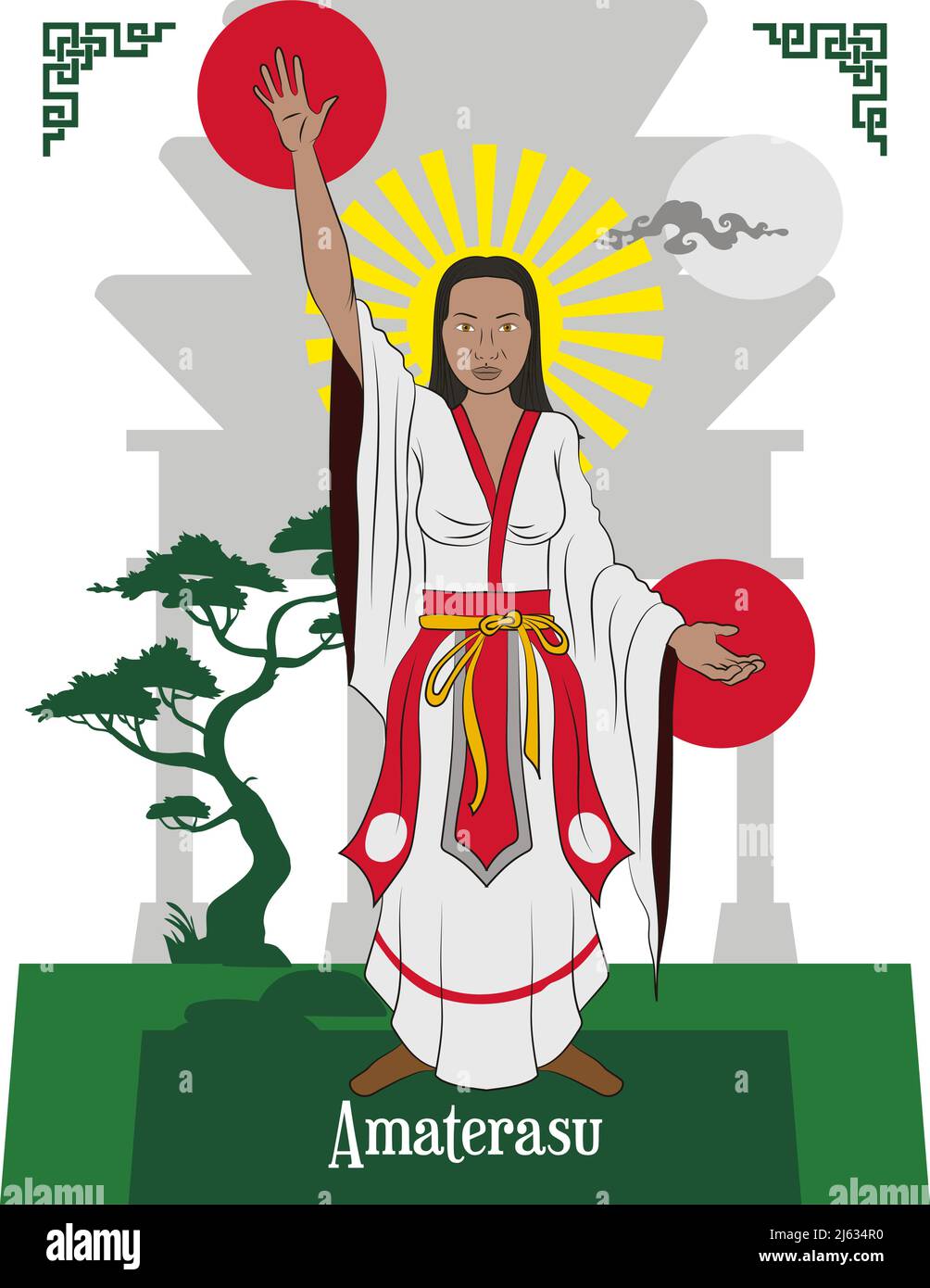 Illustration vector isolated of Japanese mythology, Japanese gods Amaterasu Stock Vectorhttps://www.alamy.com/image-license-details/?v=1https://www.alamy.com/illustration-vector-isolated-of-japanese-mythology-japanese-gods-amaterasu-image468437508.html
Illustration vector isolated of Japanese mythology, Japanese gods Amaterasu Stock Vectorhttps://www.alamy.com/image-license-details/?v=1https://www.alamy.com/illustration-vector-isolated-of-japanese-mythology-japanese-gods-amaterasu-image468437508.htmlRF2J634R0–Illustration vector isolated of Japanese mythology, Japanese gods Amaterasu
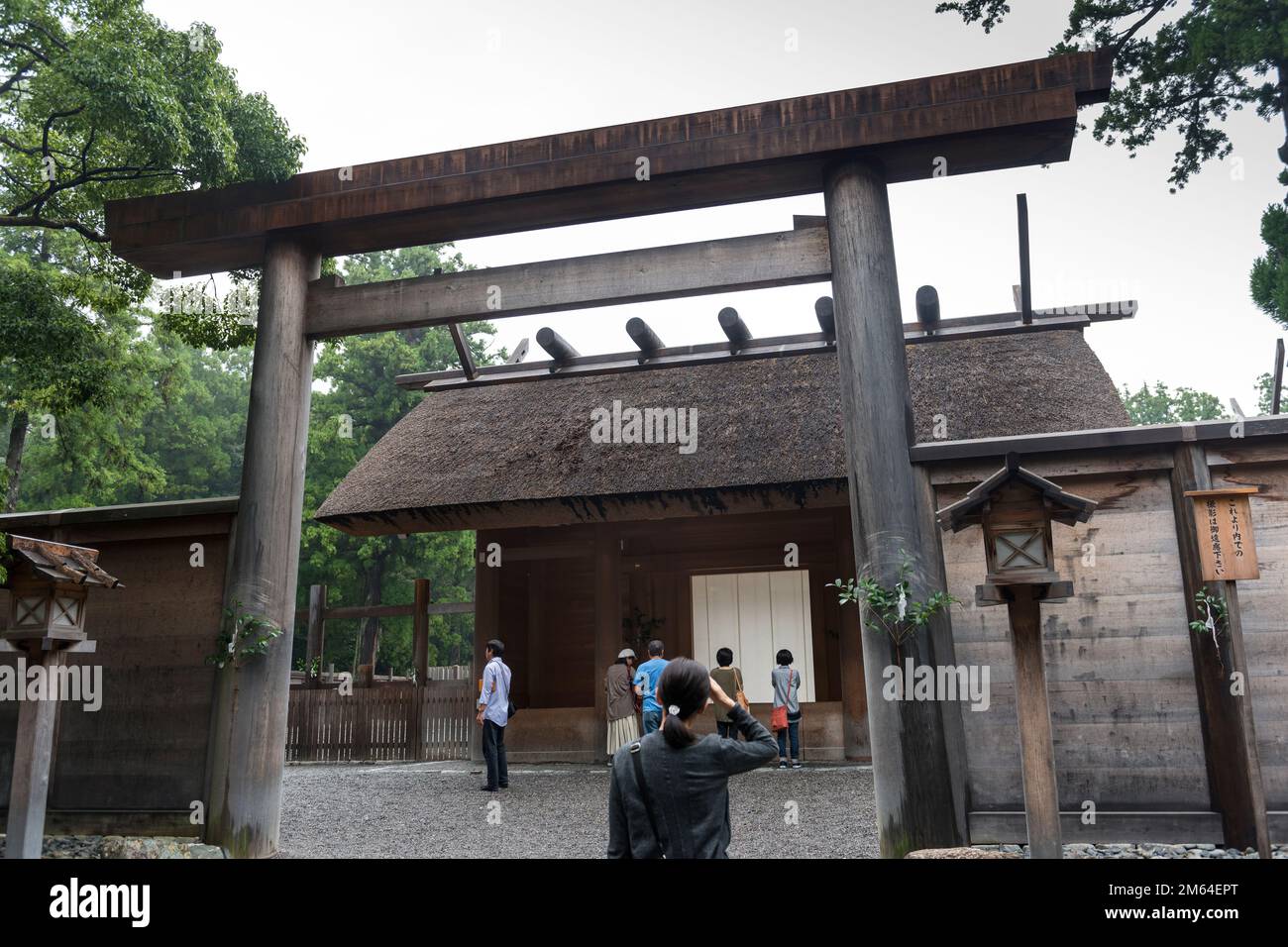 Toyouke Daijingu Betsugu Kazenomiya, (Ise Jingu Geku, Outer Shrine), Ise Grand Shrine, Ise, Mie, Japan Stock Photohttps://www.alamy.com/image-license-details/?v=1https://www.alamy.com/toyouke-daijingu-betsugu-kazenomiya-ise-jingu-geku-outer-shrine-ise-grand-shrine-ise-mie-japan-image502888032.html
Toyouke Daijingu Betsugu Kazenomiya, (Ise Jingu Geku, Outer Shrine), Ise Grand Shrine, Ise, Mie, Japan Stock Photohttps://www.alamy.com/image-license-details/?v=1https://www.alamy.com/toyouke-daijingu-betsugu-kazenomiya-ise-jingu-geku-outer-shrine-ise-grand-shrine-ise-mie-japan-image502888032.htmlRM2M64EPT–Toyouke Daijingu Betsugu Kazenomiya, (Ise Jingu Geku, Outer Shrine), Ise Grand Shrine, Ise, Mie, Japan
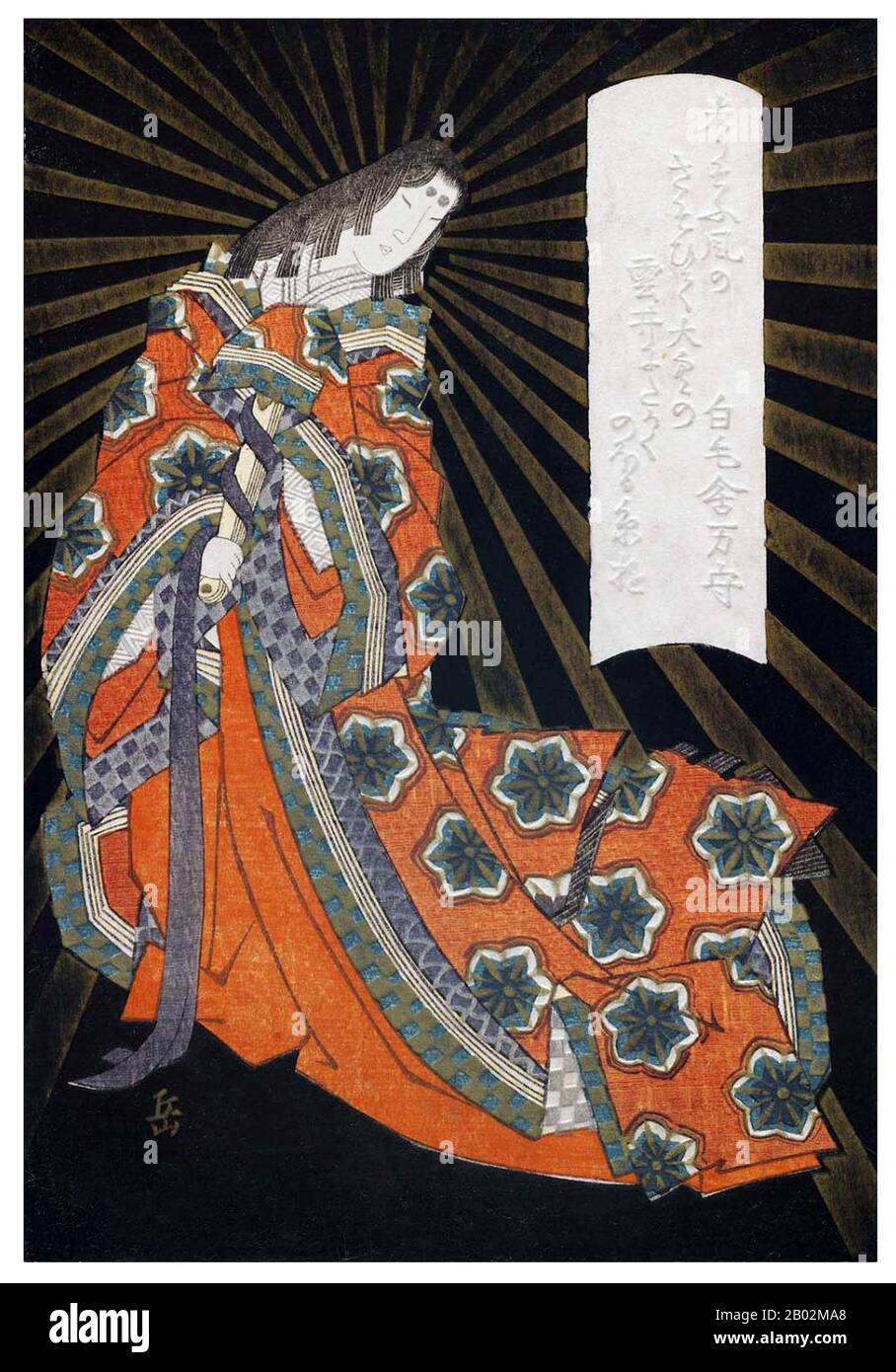 Amaterasu (天照), Amaterasu-ōmikami (天照大神/天照大御神) or Ōhirume-no-muchi-no-kami (大日孁貴神) is a part of the Japanese myth cycle and also a major deity of the Shinto religion. She is the goddess of the sun, but also of the universe. The name Amaterasu derived from Amateru meaning 'shining in heaven'. The meaning of her whole name, Amaterasu-ōmikami, is 'the great august kami (God) who shines in the heaven'. The Emperor of Japan is said to be a direct descendant of Amaterasu. Stock Photohttps://www.alamy.com/image-license-details/?v=1https://www.alamy.com/amaterasu-amaterasu-mikami-or-hirume-no-muchi-no-kami-is-a-part-of-the-japanese-myth-cycle-and-also-a-major-deity-of-the-shinto-religion-she-is-the-goddess-of-the-sun-but-also-of-the-universe-the-name-amaterasu-derived-from-amateru-meaning-shining-in-heaven-the-meaning-of-her-whole-name-amaterasu-mikami-is-the-great-august-kami-god-who-shines-in-the-heaven-the-emperor-of-japan-is-said-to-be-a-direct-descendant-of-amaterasu-image344267232.html
Amaterasu (天照), Amaterasu-ōmikami (天照大神/天照大御神) or Ōhirume-no-muchi-no-kami (大日孁貴神) is a part of the Japanese myth cycle and also a major deity of the Shinto religion. She is the goddess of the sun, but also of the universe. The name Amaterasu derived from Amateru meaning 'shining in heaven'. The meaning of her whole name, Amaterasu-ōmikami, is 'the great august kami (God) who shines in the heaven'. The Emperor of Japan is said to be a direct descendant of Amaterasu. Stock Photohttps://www.alamy.com/image-license-details/?v=1https://www.alamy.com/amaterasu-amaterasu-mikami-or-hirume-no-muchi-no-kami-is-a-part-of-the-japanese-myth-cycle-and-also-a-major-deity-of-the-shinto-religion-she-is-the-goddess-of-the-sun-but-also-of-the-universe-the-name-amaterasu-derived-from-amateru-meaning-shining-in-heaven-the-meaning-of-her-whole-name-amaterasu-mikami-is-the-great-august-kami-god-who-shines-in-the-heaven-the-emperor-of-japan-is-said-to-be-a-direct-descendant-of-amaterasu-image344267232.htmlRM2B02MA8–Amaterasu (天照), Amaterasu-ōmikami (天照大神/天照大御神) or Ōhirume-no-muchi-no-kami (大日孁貴神) is a part of the Japanese myth cycle and also a major deity of the Shinto religion. She is the goddess of the sun, but also of the universe. The name Amaterasu derived from Amateru meaning 'shining in heaven'. The meaning of her whole name, Amaterasu-ōmikami, is 'the great august kami (God) who shines in the heaven'. The Emperor of Japan is said to be a direct descendant of Amaterasu.
RF2TAKMP7–Japan Gate. Shinto - a symbol of Shintoism. Shinto icon in flat style isolated on white background
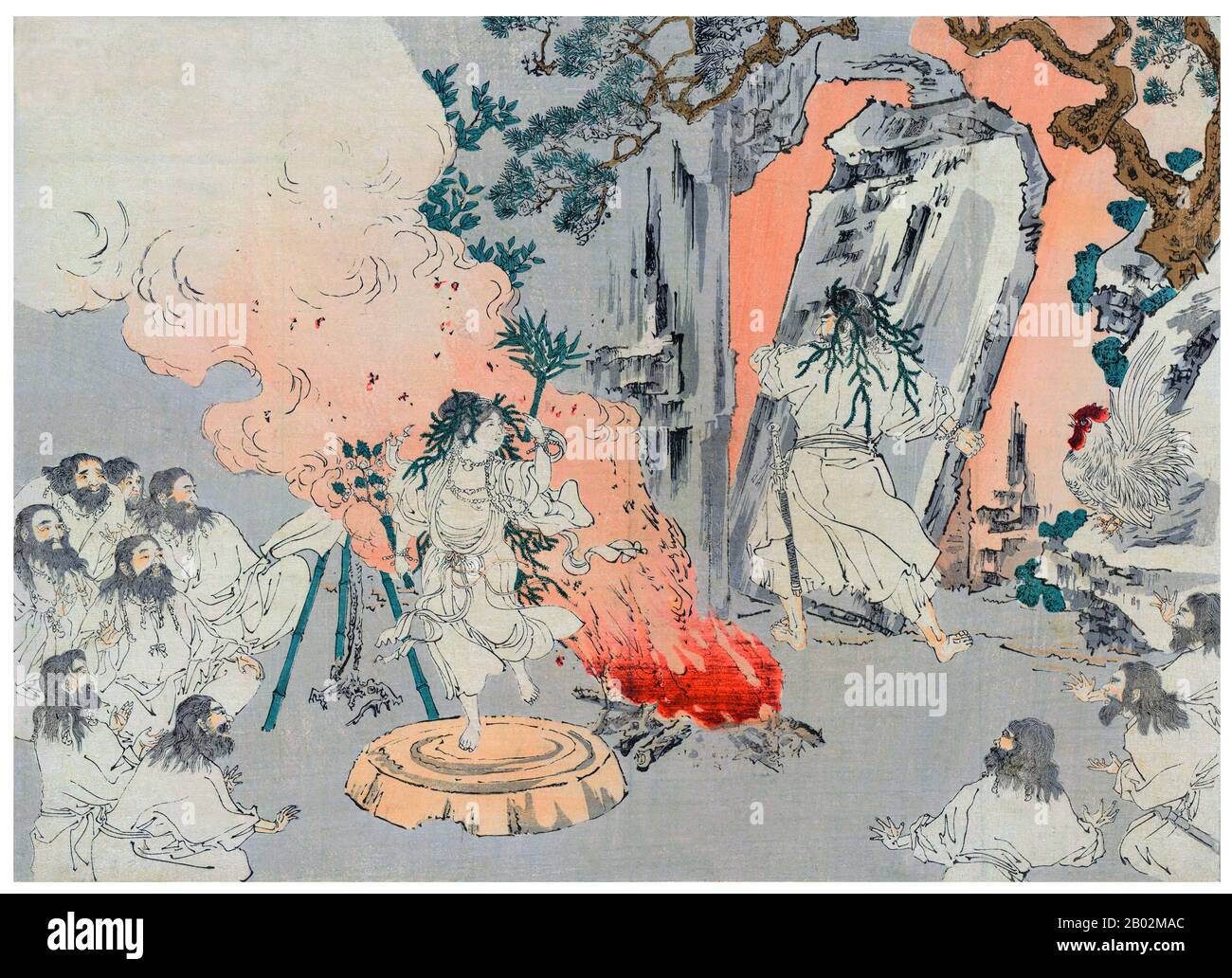 Amaterasu (天照), Amaterasu-ōmikami (天照大神/天照大御神) or Ōhirume-no-muchi-no-kami (大日孁貴神) is a part of the Japanese myth cycle and also a major deity of the Shinto religion. She is the goddess of the sun, but also of the universe. The name Amaterasu derived from Amateru meaning 'shining in heaven'. The meaning of her whole name, Amaterasu-ōmikami, is 'the great august kami (God) who shines in the heaven'. The Emperor of Japan is said to be a direct descendant of Amaterasu. Ama-no-Iwato (天岩戸) literally means 'The cave of the sun goddess' or 'heavenly rock cave'. In Japanese mythology, Susanoo, the Stock Photohttps://www.alamy.com/image-license-details/?v=1https://www.alamy.com/amaterasu-amaterasu-mikami-or-hirume-no-muchi-no-kami-is-a-part-of-the-japanese-myth-cycle-and-also-a-major-deity-of-the-shinto-religion-she-is-the-goddess-of-the-sun-but-also-of-the-universe-the-name-amaterasu-derived-from-amateru-meaning-shining-in-heaven-the-meaning-of-her-whole-name-amaterasu-mikami-is-the-great-august-kami-god-who-shines-in-the-heaven-the-emperor-of-japan-is-said-to-be-a-direct-descendant-of-amaterasu-ama-no-iwato-literally-means-the-cave-of-the-sun-goddess-or-heavenly-rock-cave-in-japanese-mythology-susanoo-the-image344267236.html
Amaterasu (天照), Amaterasu-ōmikami (天照大神/天照大御神) or Ōhirume-no-muchi-no-kami (大日孁貴神) is a part of the Japanese myth cycle and also a major deity of the Shinto religion. She is the goddess of the sun, but also of the universe. The name Amaterasu derived from Amateru meaning 'shining in heaven'. The meaning of her whole name, Amaterasu-ōmikami, is 'the great august kami (God) who shines in the heaven'. The Emperor of Japan is said to be a direct descendant of Amaterasu. Ama-no-Iwato (天岩戸) literally means 'The cave of the sun goddess' or 'heavenly rock cave'. In Japanese mythology, Susanoo, the Stock Photohttps://www.alamy.com/image-license-details/?v=1https://www.alamy.com/amaterasu-amaterasu-mikami-or-hirume-no-muchi-no-kami-is-a-part-of-the-japanese-myth-cycle-and-also-a-major-deity-of-the-shinto-religion-she-is-the-goddess-of-the-sun-but-also-of-the-universe-the-name-amaterasu-derived-from-amateru-meaning-shining-in-heaven-the-meaning-of-her-whole-name-amaterasu-mikami-is-the-great-august-kami-god-who-shines-in-the-heaven-the-emperor-of-japan-is-said-to-be-a-direct-descendant-of-amaterasu-ama-no-iwato-literally-means-the-cave-of-the-sun-goddess-or-heavenly-rock-cave-in-japanese-mythology-susanoo-the-image344267236.htmlRM2B02MAC–Amaterasu (天照), Amaterasu-ōmikami (天照大神/天照大御神) or Ōhirume-no-muchi-no-kami (大日孁貴神) is a part of the Japanese myth cycle and also a major deity of the Shinto religion. She is the goddess of the sun, but also of the universe. The name Amaterasu derived from Amateru meaning 'shining in heaven'. The meaning of her whole name, Amaterasu-ōmikami, is 'the great august kami (God) who shines in the heaven'. The Emperor of Japan is said to be a direct descendant of Amaterasu. Ama-no-Iwato (天岩戸) literally means 'The cave of the sun goddess' or 'heavenly rock cave'. In Japanese mythology, Susanoo, the
 Nishiki brocade with Amaterasu Kotai Jingu Shinto shrine) (Nishike brocade with wheelbarrow) Stock Photohttps://www.alamy.com/image-license-details/?v=1https://www.alamy.com/nishiki-brocade-with-amaterasu-kotai-jingu-shinto-shrine-nishike-brocade-with-wheelbarrow-image402292018.html
Nishiki brocade with Amaterasu Kotai Jingu Shinto shrine) (Nishike brocade with wheelbarrow) Stock Photohttps://www.alamy.com/image-license-details/?v=1https://www.alamy.com/nishiki-brocade-with-amaterasu-kotai-jingu-shinto-shrine-nishike-brocade-with-wheelbarrow-image402292018.htmlRM2EADYG2–Nishiki brocade with Amaterasu Kotai Jingu Shinto shrine) (Nishike brocade with wheelbarrow)
 Amaterasu, sometimes called by her full name Amaterasu-omikami, is one of the most important deities in the Shinto religion. Goddess of the sun and the universe, Amaterasu's name means 'shining in heaven', while her full name translates to 'the great august kami (god) who shines in the heaven'. Amaterasu was born from the left eye of the creator god Izanagi as he purified himself from his attempt to save his wife Izanami from the underworld, Yomi. Her brother and later husband, the moon god Tsukuyomi, was born from Izanagi's right eye, while her other brother, the storm god Susanoo, was born Stock Photohttps://www.alamy.com/image-license-details/?v=1https://www.alamy.com/amaterasu-sometimes-called-by-her-full-name-amaterasu-omikami-is-one-of-the-most-important-deities-in-the-shinto-religion-goddess-of-the-sun-and-the-universe-amaterasus-name-means-shining-in-heaven-while-her-full-name-translates-to-the-great-august-kami-god-who-shines-in-the-heaven-amaterasu-was-born-from-the-left-eye-of-the-creator-god-izanagi-as-he-purified-himself-from-his-attempt-to-save-his-wife-izanami-from-the-underworld-yomi-her-brother-and-later-husband-the-moon-god-tsukuyomi-was-born-from-izanagis-right-eye-while-her-other-brother-the-storm-god-susanoo-was-born-image344278791.html
Amaterasu, sometimes called by her full name Amaterasu-omikami, is one of the most important deities in the Shinto religion. Goddess of the sun and the universe, Amaterasu's name means 'shining in heaven', while her full name translates to 'the great august kami (god) who shines in the heaven'. Amaterasu was born from the left eye of the creator god Izanagi as he purified himself from his attempt to save his wife Izanami from the underworld, Yomi. Her brother and later husband, the moon god Tsukuyomi, was born from Izanagi's right eye, while her other brother, the storm god Susanoo, was born Stock Photohttps://www.alamy.com/image-license-details/?v=1https://www.alamy.com/amaterasu-sometimes-called-by-her-full-name-amaterasu-omikami-is-one-of-the-most-important-deities-in-the-shinto-religion-goddess-of-the-sun-and-the-universe-amaterasus-name-means-shining-in-heaven-while-her-full-name-translates-to-the-great-august-kami-god-who-shines-in-the-heaven-amaterasu-was-born-from-the-left-eye-of-the-creator-god-izanagi-as-he-purified-himself-from-his-attempt-to-save-his-wife-izanami-from-the-underworld-yomi-her-brother-and-later-husband-the-moon-god-tsukuyomi-was-born-from-izanagis-right-eye-while-her-other-brother-the-storm-god-susanoo-was-born-image344278791.htmlRM2B03733–Amaterasu, sometimes called by her full name Amaterasu-omikami, is one of the most important deities in the Shinto religion. Goddess of the sun and the universe, Amaterasu's name means 'shining in heaven', while her full name translates to 'the great august kami (god) who shines in the heaven'. Amaterasu was born from the left eye of the creator god Izanagi as he purified himself from his attempt to save his wife Izanami from the underworld, Yomi. Her brother and later husband, the moon god Tsukuyomi, was born from Izanagi's right eye, while her other brother, the storm god Susanoo, was born
 The gate of Kushida-jinja (Kushida Shrine), a Shinto shrine founded in 757 that dedicated to Amaterasu & Susanoo, in sunny day. Stock Photohttps://www.alamy.com/image-license-details/?v=1https://www.alamy.com/the-gate-of-kushida-jinja-kushida-shrine-a-shinto-shrine-founded-in-757-that-dedicated-to-amaterasu-susanoo-in-sunny-day-image471552761.html
The gate of Kushida-jinja (Kushida Shrine), a Shinto shrine founded in 757 that dedicated to Amaterasu & Susanoo, in sunny day. Stock Photohttps://www.alamy.com/image-license-details/?v=1https://www.alamy.com/the-gate-of-kushida-jinja-kushida-shrine-a-shinto-shrine-founded-in-757-that-dedicated-to-amaterasu-susanoo-in-sunny-day-image471552761.htmlRF2JB52A1–The gate of Kushida-jinja (Kushida Shrine), a Shinto shrine founded in 757 that dedicated to Amaterasu & Susanoo, in sunny day.
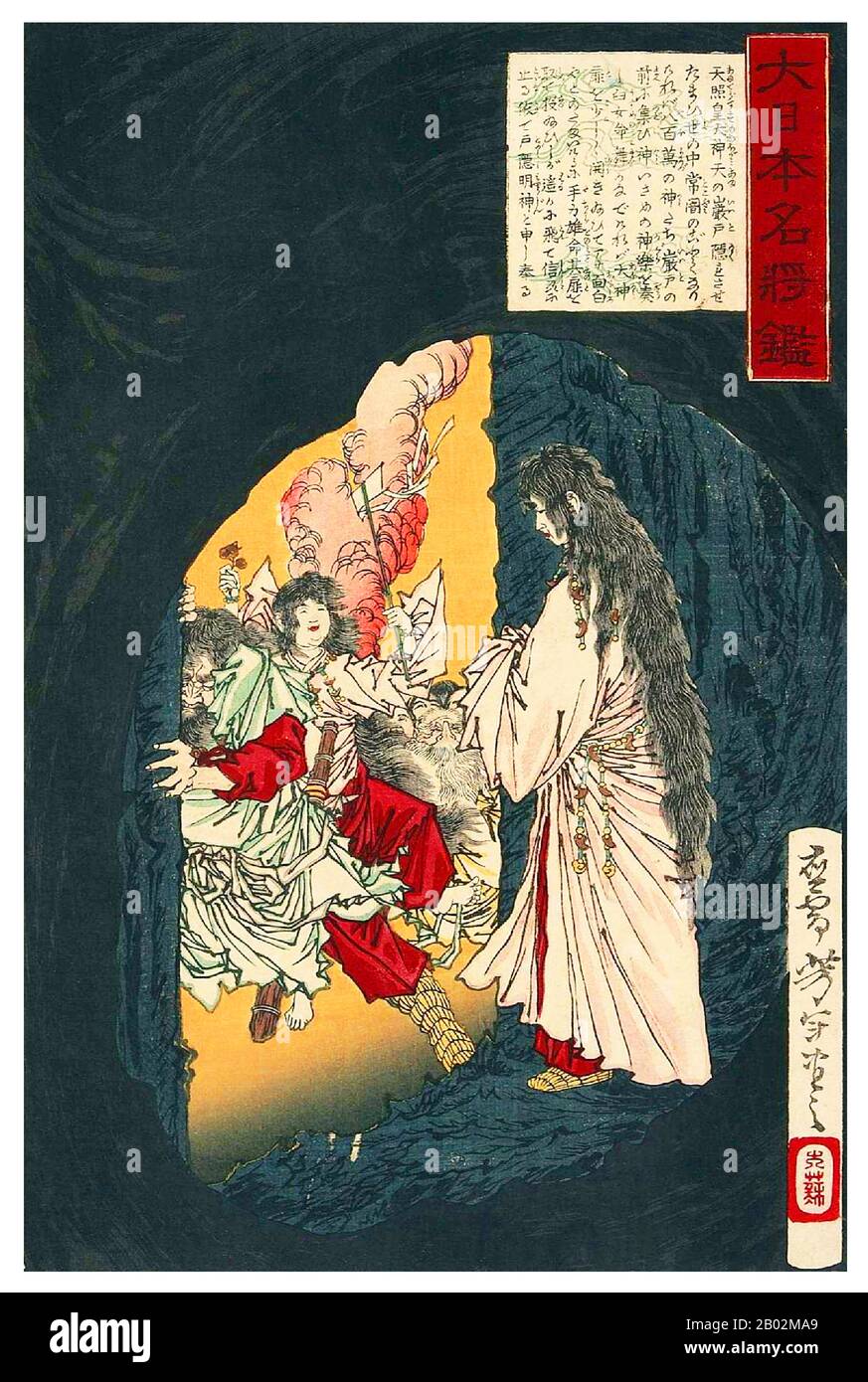 Amaterasu (天照), Amaterasu-ōmikami (天照大神/天照大御神) or Ōhirume-no-muchi-no-kami (大日孁貴神) is a part of the Japanese myth cycle and also a major deity of the Shinto religion. She is the goddess of the sun, but also of the universe. The name Amaterasu derived from Amateru meaning 'shining in heaven'. The meaning of her whole name, Amaterasu-ōmikami, is 'the great august kami (God) who shines in the heaven'. The Emperor of Japan is said to be a direct descendant of Amaterasu. Ama-no-Iwato (天岩戸) literally means 'The cave of the sun goddess' or 'heavenly rock cave'. In Japanese mythology, Susanoo, the Stock Photohttps://www.alamy.com/image-license-details/?v=1https://www.alamy.com/amaterasu-amaterasu-mikami-or-hirume-no-muchi-no-kami-is-a-part-of-the-japanese-myth-cycle-and-also-a-major-deity-of-the-shinto-religion-she-is-the-goddess-of-the-sun-but-also-of-the-universe-the-name-amaterasu-derived-from-amateru-meaning-shining-in-heaven-the-meaning-of-her-whole-name-amaterasu-mikami-is-the-great-august-kami-god-who-shines-in-the-heaven-the-emperor-of-japan-is-said-to-be-a-direct-descendant-of-amaterasu-ama-no-iwato-literally-means-the-cave-of-the-sun-goddess-or-heavenly-rock-cave-in-japanese-mythology-susanoo-the-image344267233.html
Amaterasu (天照), Amaterasu-ōmikami (天照大神/天照大御神) or Ōhirume-no-muchi-no-kami (大日孁貴神) is a part of the Japanese myth cycle and also a major deity of the Shinto religion. She is the goddess of the sun, but also of the universe. The name Amaterasu derived from Amateru meaning 'shining in heaven'. The meaning of her whole name, Amaterasu-ōmikami, is 'the great august kami (God) who shines in the heaven'. The Emperor of Japan is said to be a direct descendant of Amaterasu. Ama-no-Iwato (天岩戸) literally means 'The cave of the sun goddess' or 'heavenly rock cave'. In Japanese mythology, Susanoo, the Stock Photohttps://www.alamy.com/image-license-details/?v=1https://www.alamy.com/amaterasu-amaterasu-mikami-or-hirume-no-muchi-no-kami-is-a-part-of-the-japanese-myth-cycle-and-also-a-major-deity-of-the-shinto-religion-she-is-the-goddess-of-the-sun-but-also-of-the-universe-the-name-amaterasu-derived-from-amateru-meaning-shining-in-heaven-the-meaning-of-her-whole-name-amaterasu-mikami-is-the-great-august-kami-god-who-shines-in-the-heaven-the-emperor-of-japan-is-said-to-be-a-direct-descendant-of-amaterasu-ama-no-iwato-literally-means-the-cave-of-the-sun-goddess-or-heavenly-rock-cave-in-japanese-mythology-susanoo-the-image344267233.htmlRM2B02MA9–Amaterasu (天照), Amaterasu-ōmikami (天照大神/天照大御神) or Ōhirume-no-muchi-no-kami (大日孁貴神) is a part of the Japanese myth cycle and also a major deity of the Shinto religion. She is the goddess of the sun, but also of the universe. The name Amaterasu derived from Amateru meaning 'shining in heaven'. The meaning of her whole name, Amaterasu-ōmikami, is 'the great august kami (God) who shines in the heaven'. The Emperor of Japan is said to be a direct descendant of Amaterasu. Ama-no-Iwato (天岩戸) literally means 'The cave of the sun goddess' or 'heavenly rock cave'. In Japanese mythology, Susanoo, the
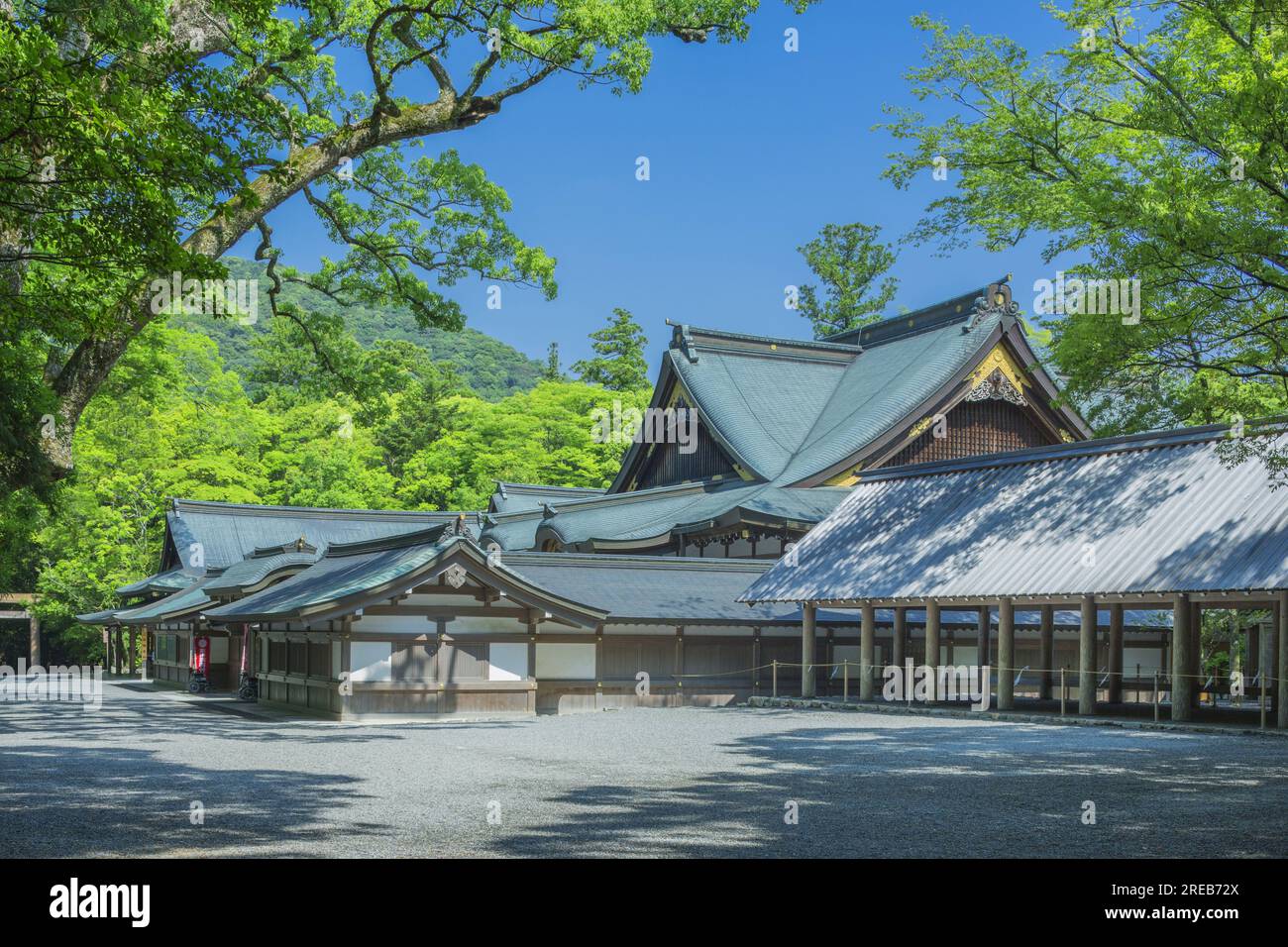 Ise Jingu Shrine Stock Photohttps://www.alamy.com/image-license-details/?v=1https://www.alamy.com/ise-jingu-shrine-image559584002.html
Ise Jingu Shrine Stock Photohttps://www.alamy.com/image-license-details/?v=1https://www.alamy.com/ise-jingu-shrine-image559584002.htmlRM2REB72X–Ise Jingu Shrine
 Japan: A bride at the Kushida Shrine (Kushida-jinja), Hakata, Fukuoka, Kyushu. Kushida-jinja is a Shinto shrine dedicated to Amaterasu, the Japanese Stock Photohttps://www.alamy.com/image-license-details/?v=1https://www.alamy.com/japan-a-bride-at-the-kushida-shrine-kushida-jinja-hakata-fukuoka-kyushu-kushida-jinja-is-a-shinto-shrine-dedicated-to-amaterasu-the-japanese-image357255440.html
Japan: A bride at the Kushida Shrine (Kushida-jinja), Hakata, Fukuoka, Kyushu. Kushida-jinja is a Shinto shrine dedicated to Amaterasu, the Japanese Stock Photohttps://www.alamy.com/image-license-details/?v=1https://www.alamy.com/japan-a-bride-at-the-kushida-shrine-kushida-jinja-hakata-fukuoka-kyushu-kushida-jinja-is-a-shinto-shrine-dedicated-to-amaterasu-the-japanese-image357255440.htmlRM2BN6AXT–Japan: A bride at the Kushida Shrine (Kushida-jinja), Hakata, Fukuoka, Kyushu. Kushida-jinja is a Shinto shrine dedicated to Amaterasu, the Japanese
 Ise Jingu Shrine in Autumn Stock Photohttps://www.alamy.com/image-license-details/?v=1https://www.alamy.com/ise-jingu-shrine-in-autumn-image559603098.html
Ise Jingu Shrine in Autumn Stock Photohttps://www.alamy.com/image-license-details/?v=1https://www.alamy.com/ise-jingu-shrine-in-autumn-image559603098.htmlRM2REC3CX–Ise Jingu Shrine in Autumn
 ?tsu-e of Uh? D?ji 17th century Japan Uh? D?ji, the “rainmaking youth,” is said to be either a manifestation of the Shinto goddess Amaterasu or the Buddha Dainichi Nyorai (Sanskrit: Vairochana). He holds a wish-fulfilling jewel and staff and has a five-tiered pagoda on his head.. ?tsu-e of Uh? D?ji. Japan. 17th century. Hanging scroll; ink, color, and woodblock print on paper. Edo period (1615–1868). Paintings Stock Photohttps://www.alamy.com/image-license-details/?v=1https://www.alamy.com/tsu-e-of-uh-dji-17th-century-japan-uh-dji-the-rainmaking-youth-is-said-to-be-either-a-manifestation-of-the-shinto-goddess-amaterasu-or-the-buddha-dainichi-nyorai-sanskrit-vairochana-he-holds-a-wish-fulfilling-jewel-and-staff-and-has-a-five-tiered-pagoda-on-his-head-tsu-e-of-uh-dji-japan-17th-century-hanging-scroll-ink-color-and-woodblock-print-on-paper-edo-period-16151868-paintings-image458476975.html
?tsu-e of Uh? D?ji 17th century Japan Uh? D?ji, the “rainmaking youth,” is said to be either a manifestation of the Shinto goddess Amaterasu or the Buddha Dainichi Nyorai (Sanskrit: Vairochana). He holds a wish-fulfilling jewel and staff and has a five-tiered pagoda on his head.. ?tsu-e of Uh? D?ji. Japan. 17th century. Hanging scroll; ink, color, and woodblock print on paper. Edo period (1615–1868). Paintings Stock Photohttps://www.alamy.com/image-license-details/?v=1https://www.alamy.com/tsu-e-of-uh-dji-17th-century-japan-uh-dji-the-rainmaking-youth-is-said-to-be-either-a-manifestation-of-the-shinto-goddess-amaterasu-or-the-buddha-dainichi-nyorai-sanskrit-vairochana-he-holds-a-wish-fulfilling-jewel-and-staff-and-has-a-five-tiered-pagoda-on-his-head-tsu-e-of-uh-dji-japan-17th-century-hanging-scroll-ink-color-and-woodblock-print-on-paper-edo-period-16151868-paintings-image458476975.htmlRM2HHWC1K–?tsu-e of Uh? D?ji 17th century Japan Uh? D?ji, the “rainmaking youth,” is said to be either a manifestation of the Shinto goddess Amaterasu or the Buddha Dainichi Nyorai (Sanskrit: Vairochana). He holds a wish-fulfilling jewel and staff and has a five-tiered pagoda on his head.. ?tsu-e of Uh? D?ji. Japan. 17th century. Hanging scroll; ink, color, and woodblock print on paper. Edo period (1615–1868). Paintings
 Tomoe hams pattern vector design, symbol of Japanese culture Stock Vectorhttps://www.alamy.com/image-license-details/?v=1https://www.alamy.com/tomoe-hams-pattern-vector-design-symbol-of-japanese-culture-image480079560.html
Tomoe hams pattern vector design, symbol of Japanese culture Stock Vectorhttps://www.alamy.com/image-license-details/?v=1https://www.alamy.com/tomoe-hams-pattern-vector-design-symbol-of-japanese-culture-image480079560.htmlRF2JW1EAG–Tomoe hams pattern vector design, symbol of Japanese culture
 Helmet (Suji-Kabuto) late 17th–early 18th century Japanese The bowl of this helmet is formed from one hundred individual radial iron plates, the overlapping edges of which form ridges (suji). The inscription on the frontal plate now reads jing? (shrine); however, the first character is missing, and it likely originally read Daijing?. This inscription may refer to the Ise Shrine, the most famous Shinto shrine in Japan, which is dedicated to the sun goddess Amaterasu. Wearing or displaying the helmet would thus have invoked divine powers.. Helmet (Suji-Kabuto). Japanese. late 17th–early 18th cen Stock Photohttps://www.alamy.com/image-license-details/?v=1https://www.alamy.com/helmet-suji-kabuto-late-17thearly-18th-century-japanese-the-bowl-of-this-helmet-is-formed-from-one-hundred-individual-radial-iron-plates-the-overlapping-edges-of-which-form-ridges-suji-the-inscription-on-the-frontal-plate-now-reads-jing-shrine-however-the-first-character-is-missing-and-it-likely-originally-read-daijing-this-inscription-may-refer-to-the-ise-shrine-the-most-famous-shinto-shrine-in-japan-which-is-dedicated-to-the-sun-goddess-amaterasu-wearing-or-displaying-the-helmet-would-thus-have-invoked-divine-powers-helmet-suji-kabuto-japanese-late-17thearly-18th-cen-image457899473.html
Helmet (Suji-Kabuto) late 17th–early 18th century Japanese The bowl of this helmet is formed from one hundred individual radial iron plates, the overlapping edges of which form ridges (suji). The inscription on the frontal plate now reads jing? (shrine); however, the first character is missing, and it likely originally read Daijing?. This inscription may refer to the Ise Shrine, the most famous Shinto shrine in Japan, which is dedicated to the sun goddess Amaterasu. Wearing or displaying the helmet would thus have invoked divine powers.. Helmet (Suji-Kabuto). Japanese. late 17th–early 18th cen Stock Photohttps://www.alamy.com/image-license-details/?v=1https://www.alamy.com/helmet-suji-kabuto-late-17thearly-18th-century-japanese-the-bowl-of-this-helmet-is-formed-from-one-hundred-individual-radial-iron-plates-the-overlapping-edges-of-which-form-ridges-suji-the-inscription-on-the-frontal-plate-now-reads-jing-shrine-however-the-first-character-is-missing-and-it-likely-originally-read-daijing-this-inscription-may-refer-to-the-ise-shrine-the-most-famous-shinto-shrine-in-japan-which-is-dedicated-to-the-sun-goddess-amaterasu-wearing-or-displaying-the-helmet-would-thus-have-invoked-divine-powers-helmet-suji-kabuto-japanese-late-17thearly-18th-cen-image457899473.htmlRM2HGY3CH–Helmet (Suji-Kabuto) late 17th–early 18th century Japanese The bowl of this helmet is formed from one hundred individual radial iron plates, the overlapping edges of which form ridges (suji). The inscription on the frontal plate now reads jing? (shrine); however, the first character is missing, and it likely originally read Daijing?. This inscription may refer to the Ise Shrine, the most famous Shinto shrine in Japan, which is dedicated to the sun goddess Amaterasu. Wearing or displaying the helmet would thus have invoked divine powers.. Helmet (Suji-Kabuto). Japanese. late 17th–early 18th cen
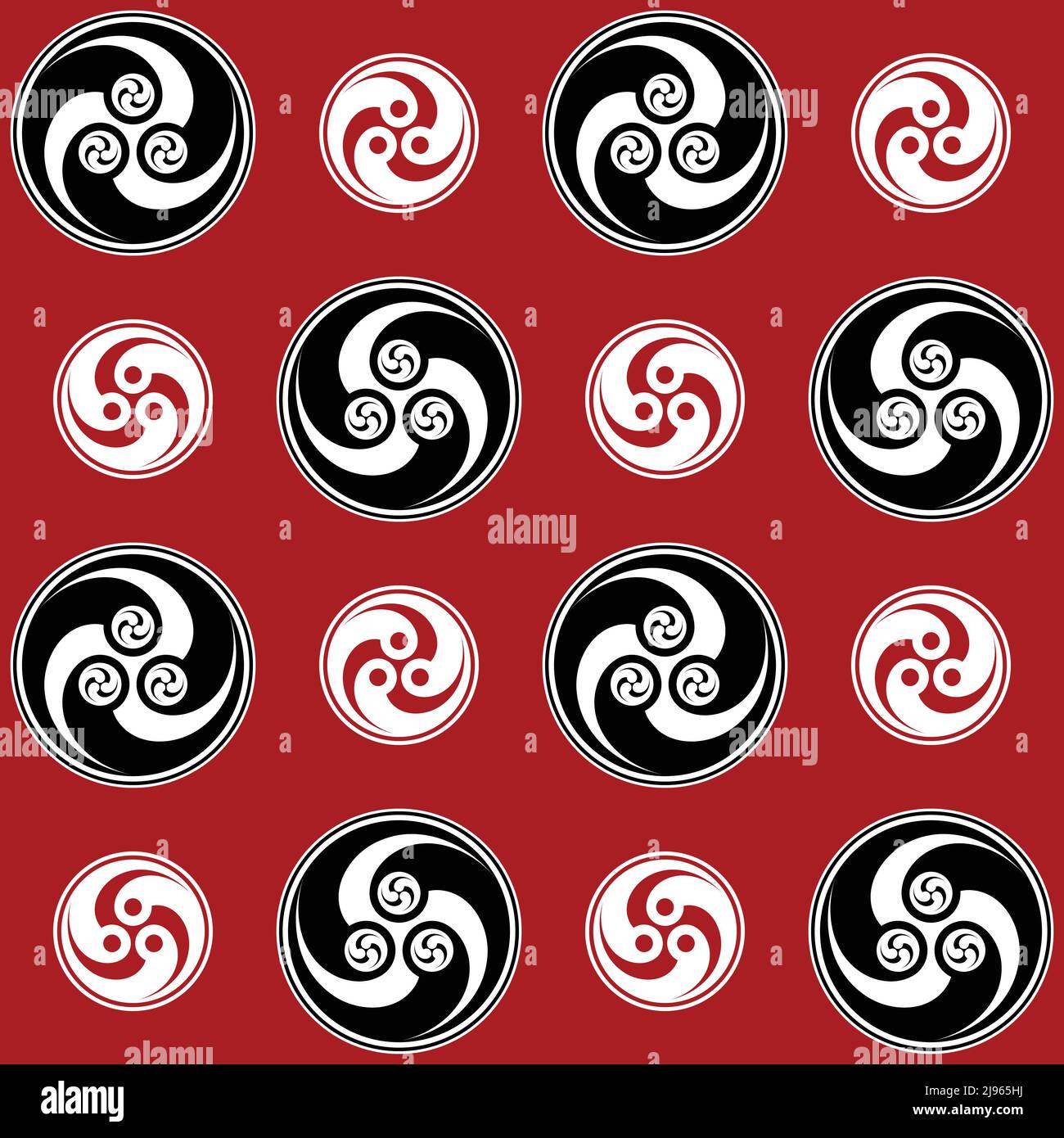 Tomoe hams pattern vector design, symbol of Japanese culture Stock Vectorhttps://www.alamy.com/image-license-details/?v=1https://www.alamy.com/tomoe-hams-pattern-vector-design-symbol-of-japanese-culture-image470347966.html
Tomoe hams pattern vector design, symbol of Japanese culture Stock Vectorhttps://www.alamy.com/image-license-details/?v=1https://www.alamy.com/tomoe-hams-pattern-vector-design-symbol-of-japanese-culture-image470347966.htmlRF2J965HJ–Tomoe hams pattern vector design, symbol of Japanese culture
 Rooster at the Naiku (Inner Shrine) of the Ise Shrine, the main sanctuary of Shintoism in Japan. Roosters symbolize Amaterasu, the main deity of Shint Stock Photohttps://www.alamy.com/image-license-details/?v=1https://www.alamy.com/rooster-at-the-naiku-inner-shrine-of-the-ise-shrine-the-main-sanctuary-of-shintoism-in-japan-roosters-symbolize-amaterasu-the-main-deity-of-shint-image235755400.html
Rooster at the Naiku (Inner Shrine) of the Ise Shrine, the main sanctuary of Shintoism in Japan. Roosters symbolize Amaterasu, the main deity of Shint Stock Photohttps://www.alamy.com/image-license-details/?v=1https://www.alamy.com/rooster-at-the-naiku-inner-shrine-of-the-ise-shrine-the-main-sanctuary-of-shintoism-in-japan-roosters-symbolize-amaterasu-the-main-deity-of-shint-image235755400.htmlRMRKFGBM–Rooster at the Naiku (Inner Shrine) of the Ise Shrine, the main sanctuary of Shintoism in Japan. Roosters symbolize Amaterasu, the main deity of Shint
 Kushida Shrine Fukuoka Kyushu Japan Stock Photohttps://www.alamy.com/image-license-details/?v=1https://www.alamy.com/stock-photo-kushida-shrine-fukuoka-kyushu-japan-59223081.html
Kushida Shrine Fukuoka Kyushu Japan Stock Photohttps://www.alamy.com/image-license-details/?v=1https://www.alamy.com/stock-photo-kushida-shrine-fukuoka-kyushu-japan-59223081.htmlRMDC9RJ1–Kushida Shrine Fukuoka Kyushu Japan
 Asia culture concept - the beautiful roof decoration art of traditional kushida shrine in Fukuoka Japan Stock Photohttps://www.alamy.com/image-license-details/?v=1https://www.alamy.com/asia-culture-concept-the-beautiful-roof-decoration-art-of-traditional-kushida-shrine-in-fukuoka-japan-image232389718.html
Asia culture concept - the beautiful roof decoration art of traditional kushida shrine in Fukuoka Japan Stock Photohttps://www.alamy.com/image-license-details/?v=1https://www.alamy.com/asia-culture-concept-the-beautiful-roof-decoration-art-of-traditional-kushida-shrine-in-fukuoka-japan-image232389718.htmlRFRE27CP–Asia culture concept - the beautiful roof decoration art of traditional kushida shrine in Fukuoka Japan
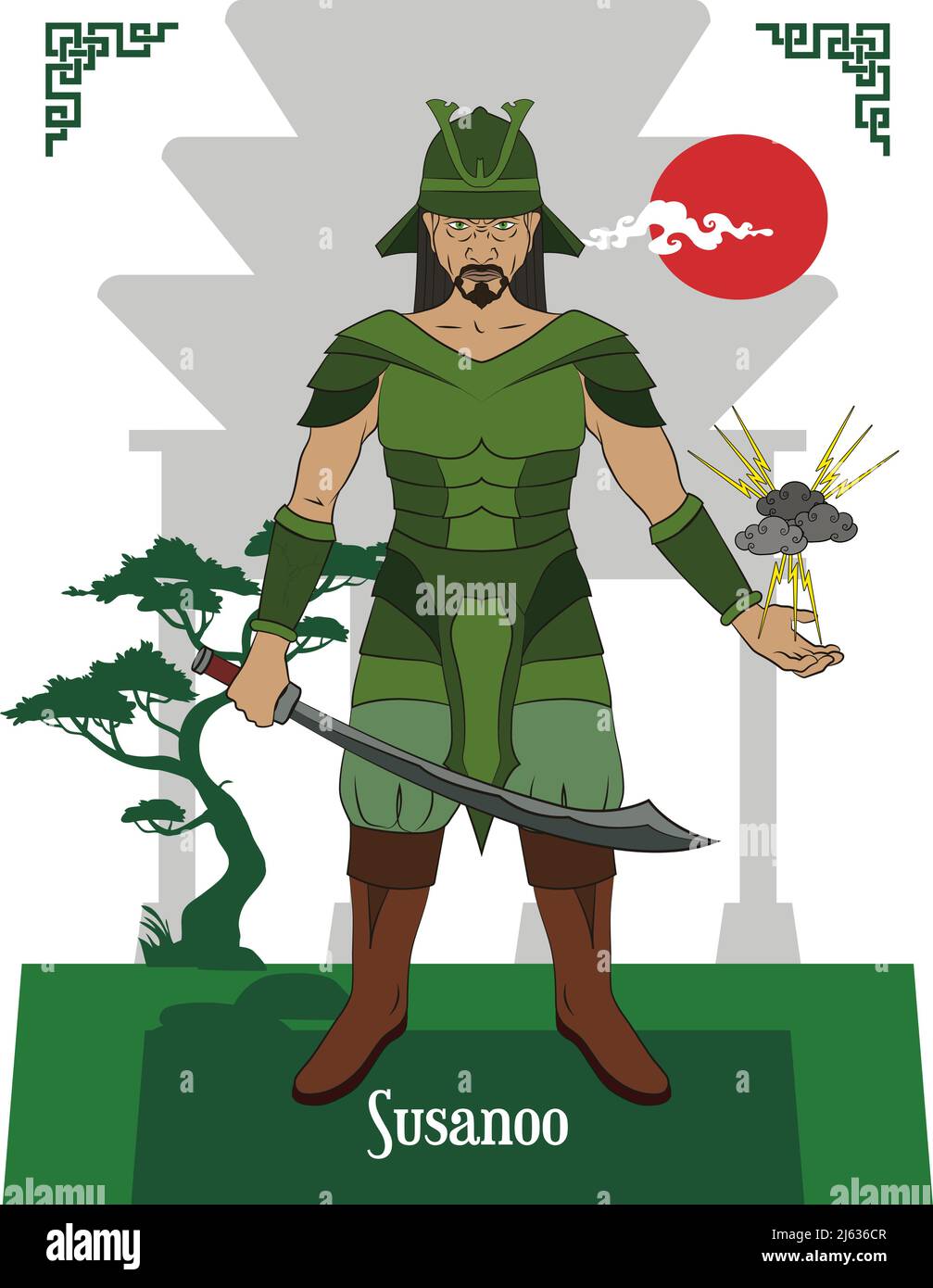 Illustration vector isolated of Japanese mythology, Japanese gods Susanoo Stock Vectorhttps://www.alamy.com/image-license-details/?v=1https://www.alamy.com/illustration-vector-isolated-of-japanese-mythology-japanese-gods-susanoo-image468438791.html
Illustration vector isolated of Japanese mythology, Japanese gods Susanoo Stock Vectorhttps://www.alamy.com/image-license-details/?v=1https://www.alamy.com/illustration-vector-isolated-of-japanese-mythology-japanese-gods-susanoo-image468438791.htmlRF2J636CR–Illustration vector isolated of Japanese mythology, Japanese gods Susanoo
 Yohashira Shrine, Matsumoto, Japan Stock Photohttps://www.alamy.com/image-license-details/?v=1https://www.alamy.com/yohashira-shrine-matsumoto-japan-image591075197.html
Yohashira Shrine, Matsumoto, Japan Stock Photohttps://www.alamy.com/image-license-details/?v=1https://www.alamy.com/yohashira-shrine-matsumoto-japan-image591075197.htmlRF2W9HPCD–Yohashira Shrine, Matsumoto, Japan
 Kotai Jingu temple or Ise Jingu Naiku, in Ise, Mie, Japan Stock Photohttps://www.alamy.com/image-license-details/?v=1https://www.alamy.com/kotai-jingu-temple-or-ise-jingu-naiku-in-ise-mie-japan-image623189745.html
Kotai Jingu temple or Ise Jingu Naiku, in Ise, Mie, Japan Stock Photohttps://www.alamy.com/image-license-details/?v=1https://www.alamy.com/kotai-jingu-temple-or-ise-jingu-naiku-in-ise-mie-japan-image623189745.htmlRF2Y5TMTH–Kotai Jingu temple or Ise Jingu Naiku, in Ise, Mie, Japan
 TOKYO, JAPAN - JUNE 27 : A shinto priest staging a prayer to a deceased anime figure in front of an altar in Akihabara shrine in Akihabara, Tokyo, Japan on June 27, 2016. The newly opened Akihabara Shrine offers a memorial services for 'deceased' anime figures. © Richard Atrero de Guzman/AFLO/Alamy Live News Stock Photohttps://www.alamy.com/image-license-details/?v=1https://www.alamy.com/stock-photo-tokyo-japan-june-27-a-shinto-priest-staging-a-prayer-to-a-deceased-108163424.html
TOKYO, JAPAN - JUNE 27 : A shinto priest staging a prayer to a deceased anime figure in front of an altar in Akihabara shrine in Akihabara, Tokyo, Japan on June 27, 2016. The newly opened Akihabara Shrine offers a memorial services for 'deceased' anime figures. © Richard Atrero de Guzman/AFLO/Alamy Live News Stock Photohttps://www.alamy.com/image-license-details/?v=1https://www.alamy.com/stock-photo-tokyo-japan-june-27-a-shinto-priest-staging-a-prayer-to-a-deceased-108163424.htmlRMG7Y7FC–TOKYO, JAPAN - JUNE 27 : A shinto priest staging a prayer to a deceased anime figure in front of an altar in Akihabara shrine in Akihabara, Tokyo, Japan on June 27, 2016. The newly opened Akihabara Shrine offers a memorial services for 'deceased' anime figures. © Richard Atrero de Guzman/AFLO/Alamy Live News
 Luring the Sun Goddess Amaterasu Out of a Cave; Death of the Historical Buddha (Nehan-zu) , late 19th century. Meiji period (1868-1912) Stock Photohttps://www.alamy.com/image-license-details/?v=1https://www.alamy.com/luring-the-sun-goddess-amaterasu-out-of-a-cave-death-of-the-historical-buddha-nehan-zu-late-19th-century-meiji-period-1868-1912-image343012639.html
Luring the Sun Goddess Amaterasu Out of a Cave; Death of the Historical Buddha (Nehan-zu) , late 19th century. Meiji period (1868-1912) Stock Photohttps://www.alamy.com/image-license-details/?v=1https://www.alamy.com/luring-the-sun-goddess-amaterasu-out-of-a-cave-death-of-the-historical-buddha-nehan-zu-late-19th-century-meiji-period-1868-1912-image343012639.htmlRM2AX1G3B–Luring the Sun Goddess Amaterasu Out of a Cave; Death of the Historical Buddha (Nehan-zu) , late 19th century. Meiji period (1868-1912)
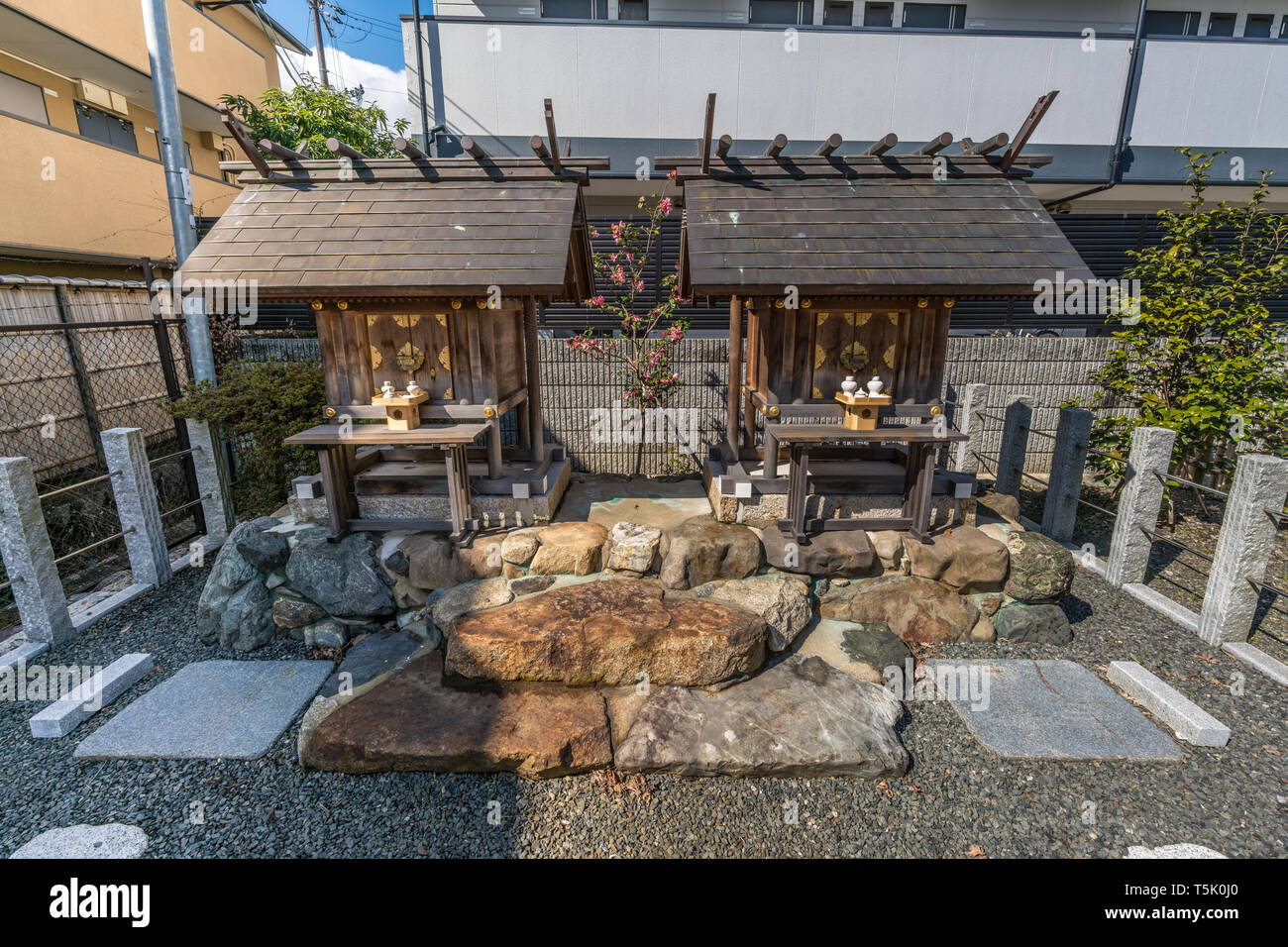 Kyoto, Japan - March 8, 2019 : Nishi-Umetsu Shinmyo-sha. Shinto Shrine devoted to Amaterasu-omikami and Toyoke-kami. Located in the grounds of Umenomi Stock Photohttps://www.alamy.com/image-license-details/?v=1https://www.alamy.com/kyoto-japan-march-8-2019-nishi-umetsu-shinmyo-sha-shinto-shrine-devoted-to-amaterasu-omikami-and-toyoke-kami-located-in-the-grounds-of-umenomi-image244436024.html
Kyoto, Japan - March 8, 2019 : Nishi-Umetsu Shinmyo-sha. Shinto Shrine devoted to Amaterasu-omikami and Toyoke-kami. Located in the grounds of Umenomi Stock Photohttps://www.alamy.com/image-license-details/?v=1https://www.alamy.com/kyoto-japan-march-8-2019-nishi-umetsu-shinmyo-sha-shinto-shrine-devoted-to-amaterasu-omikami-and-toyoke-kami-located-in-the-grounds-of-umenomi-image244436024.htmlRFT5K0J0–Kyoto, Japan - March 8, 2019 : Nishi-Umetsu Shinmyo-sha. Shinto Shrine devoted to Amaterasu-omikami and Toyoke-kami. Located in the grounds of Umenomi
 Tori At Ise Grand Shrine At Ise Japan 2016 Stock Photohttps://www.alamy.com/image-license-details/?v=1https://www.alamy.com/tori-at-ise-grand-shrine-at-ise-japan-2016-image262429179.html
Tori At Ise Grand Shrine At Ise Japan 2016 Stock Photohttps://www.alamy.com/image-license-details/?v=1https://www.alamy.com/tori-at-ise-grand-shrine-at-ise-japan-2016-image262429179.htmlRFW6XK2K–Tori At Ise Grand Shrine At Ise Japan 2016
 Main shrine of Kushida-jinja (Kushida Shrine), a Shinto shrine founded in 757 that dedicated to Amaterasu & Susanoo, in sunny day Stock Photohttps://www.alamy.com/image-license-details/?v=1https://www.alamy.com/main-shrine-of-kushida-jinja-kushida-shrine-a-shinto-shrine-founded-in-757-that-dedicated-to-amaterasu-susanoo-in-sunny-day-image471552766.html
Main shrine of Kushida-jinja (Kushida Shrine), a Shinto shrine founded in 757 that dedicated to Amaterasu & Susanoo, in sunny day Stock Photohttps://www.alamy.com/image-license-details/?v=1https://www.alamy.com/main-shrine-of-kushida-jinja-kushida-shrine-a-shinto-shrine-founded-in-757-that-dedicated-to-amaterasu-susanoo-in-sunny-day-image471552766.htmlRF2JB52A6–Main shrine of Kushida-jinja (Kushida Shrine), a Shinto shrine founded in 757 that dedicated to Amaterasu & Susanoo, in sunny day
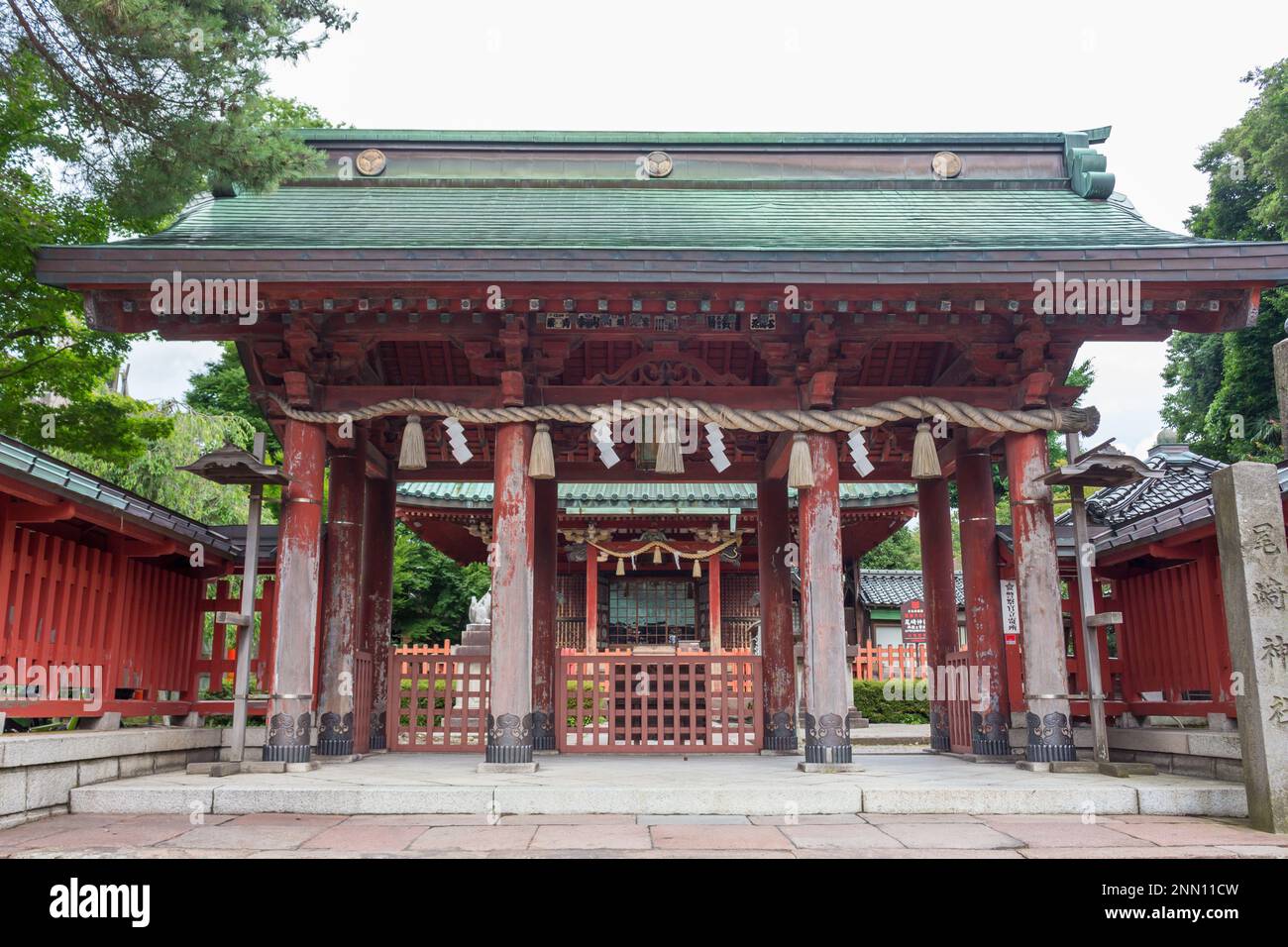 Osaki jinja shinto shrine, Kanazawa, Ishikawa, Japan. Stock Photohttps://www.alamy.com/image-license-details/?v=1https://www.alamy.com/osaki-jinja-shinto-shrine-kanazawa-ishikawa-japan-image529241913.html
Osaki jinja shinto shrine, Kanazawa, Ishikawa, Japan. Stock Photohttps://www.alamy.com/image-license-details/?v=1https://www.alamy.com/osaki-jinja-shinto-shrine-kanazawa-ishikawa-japan-image529241913.htmlRF2NN11CW–Osaki jinja shinto shrine, Kanazawa, Ishikawa, Japan.
 Miyazaki, Japan - Nov 24 2022: Takachiho Shrine founded over 1,900 year, Ninigi no Mikoto, the grandchild of Amaterasu Omikami. It's widely worshipped Stock Photohttps://www.alamy.com/image-license-details/?v=1https://www.alamy.com/miyazaki-japan-nov-24-2022-takachiho-shrine-founded-over-1900-year-ninigi-no-mikoto-the-grandchild-of-amaterasu-omikami-its-widely-worshipped-image546007891.html
Miyazaki, Japan - Nov 24 2022: Takachiho Shrine founded over 1,900 year, Ninigi no Mikoto, the grandchild of Amaterasu Omikami. It's widely worshipped Stock Photohttps://www.alamy.com/image-license-details/?v=1https://www.alamy.com/miyazaki-japan-nov-24-2022-takachiho-shrine-founded-over-1900-year-ninigi-no-mikoto-the-grandchild-of-amaterasu-omikami-its-widely-worshipped-image546007891.htmlRF2PM8PHR–Miyazaki, Japan - Nov 24 2022: Takachiho Shrine founded over 1,900 year, Ninigi no Mikoto, the grandchild of Amaterasu Omikami. It's widely worshipped
 Japan: A bride and groom at the Kushida Shrine (Kushida-jinja), Hakata, Fukuoka, Kyushu. Kushida-jinja is a Shinto shrine dedicated to Amaterasu, the Stock Photohttps://www.alamy.com/image-license-details/?v=1https://www.alamy.com/japan-a-bride-and-groom-at-the-kushida-shrine-kushida-jinja-hakata-fukuoka-kyushu-kushida-jinja-is-a-shinto-shrine-dedicated-to-amaterasu-the-image357255484.html
Japan: A bride and groom at the Kushida Shrine (Kushida-jinja), Hakata, Fukuoka, Kyushu. Kushida-jinja is a Shinto shrine dedicated to Amaterasu, the Stock Photohttps://www.alamy.com/image-license-details/?v=1https://www.alamy.com/japan-a-bride-and-groom-at-the-kushida-shrine-kushida-jinja-hakata-fukuoka-kyushu-kushida-jinja-is-a-shinto-shrine-dedicated-to-amaterasu-the-image357255484.htmlRM2BN6B0C–Japan: A bride and groom at the Kushida Shrine (Kushida-jinja), Hakata, Fukuoka, Kyushu. Kushida-jinja is a Shinto shrine dedicated to Amaterasu, the
RF2GAAE0B–Japanese Kami God Goddess Deities stick figure icons. Vector illustration of Japan popular gods lords Jizo, Inari Okami, Raijin Fujin, Agyo Ungyo, Kan
 Ise Jingu Shrine Stock Photohttps://www.alamy.com/image-license-details/?v=1https://www.alamy.com/ise-jingu-shrine-image559583995.html
Ise Jingu Shrine Stock Photohttps://www.alamy.com/image-license-details/?v=1https://www.alamy.com/ise-jingu-shrine-image559583995.htmlRM2REB72K–Ise Jingu Shrine
 Torii Gate, Ise Shrine, Kansai, Honshu, Japan Stock Photohttps://www.alamy.com/image-license-details/?v=1https://www.alamy.com/stock-photo-torii-gate-ise-shrine-kansai-honshu-japan-16841304.html
Torii Gate, Ise Shrine, Kansai, Honshu, Japan Stock Photohttps://www.alamy.com/image-license-details/?v=1https://www.alamy.com/stock-photo-torii-gate-ise-shrine-kansai-honshu-japan-16841304.htmlRFAXGNGW–Torii Gate, Ise Shrine, Kansai, Honshu, Japan
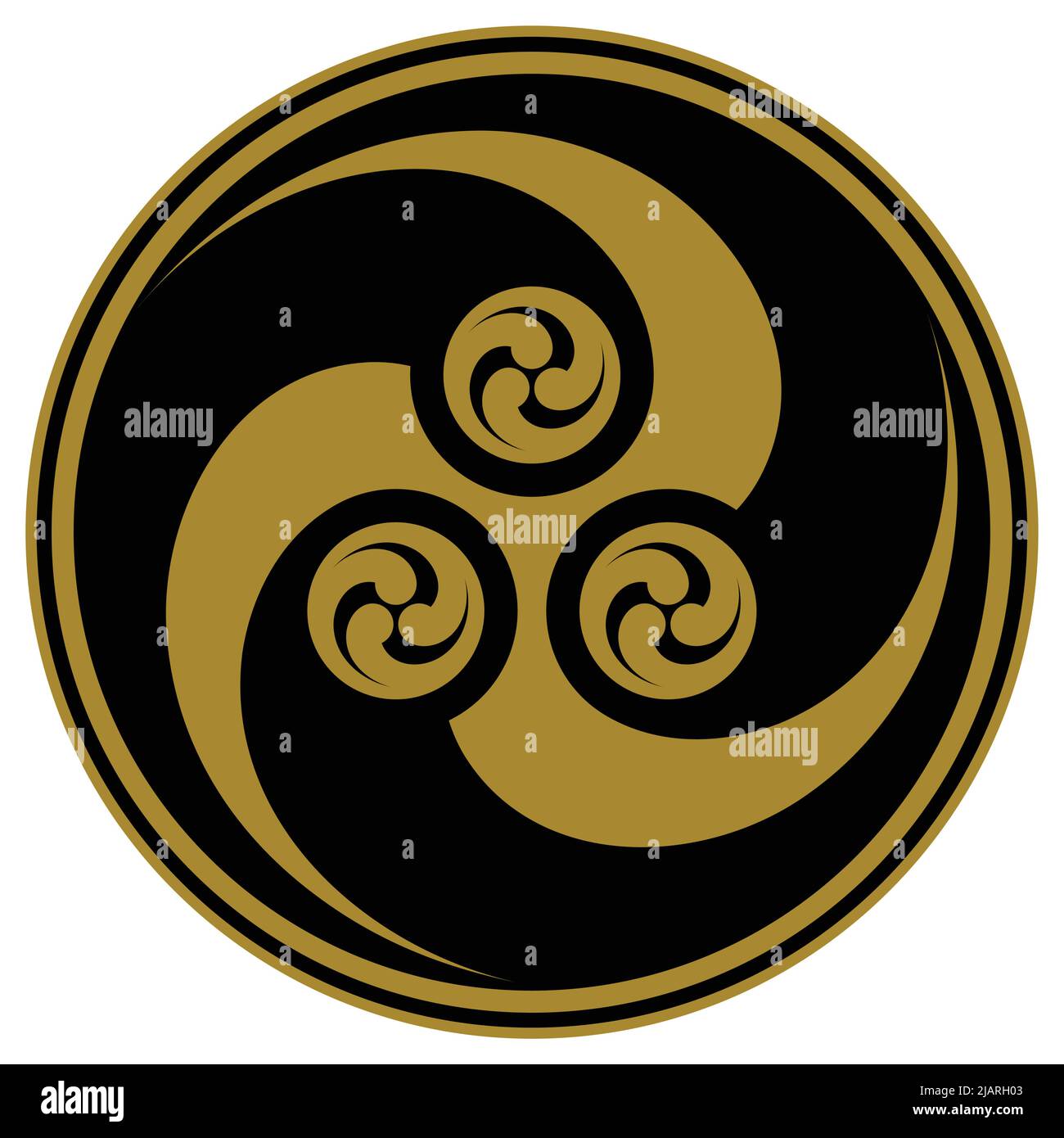 Vector design. Tomoe hams symbol formed by three magatama Stock Vectorhttps://www.alamy.com/image-license-details/?v=1https://www.alamy.com/vector-design-tomoe-hams-symbol-formed-by-three-magatama-image471344723.html
Vector design. Tomoe hams symbol formed by three magatama Stock Vectorhttps://www.alamy.com/image-license-details/?v=1https://www.alamy.com/vector-design-tomoe-hams-symbol-formed-by-three-magatama-image471344723.htmlRF2JARH03–Vector design. Tomoe hams symbol formed by three magatama
 Rooster at the Naiku (Inner Shrine) of the Ise Shrine, the main sanctuary of Shintoism in Japan. Roosters symbolize Amaterasu, the main deity of Shint Stock Photohttps://www.alamy.com/image-license-details/?v=1https://www.alamy.com/rooster-at-the-naiku-inner-shrine-of-the-ise-shrine-the-main-sanctuary-of-shintoism-in-japan-roosters-symbolize-amaterasu-the-main-deity-of-shint-image235755405.html
Rooster at the Naiku (Inner Shrine) of the Ise Shrine, the main sanctuary of Shintoism in Japan. Roosters symbolize Amaterasu, the main deity of Shint Stock Photohttps://www.alamy.com/image-license-details/?v=1https://www.alamy.com/rooster-at-the-naiku-inner-shrine-of-the-ise-shrine-the-main-sanctuary-of-shintoism-in-japan-roosters-symbolize-amaterasu-the-main-deity-of-shint-image235755405.htmlRMRKFGBW–Rooster at the Naiku (Inner Shrine) of the Ise Shrine, the main sanctuary of Shintoism in Japan. Roosters symbolize Amaterasu, the main deity of Shint
 Kushida Shrine Fukuoka Kyushu Japan Stock Photohttps://www.alamy.com/image-license-details/?v=1https://www.alamy.com/stock-photo-kushida-shrine-fukuoka-kyushu-japan-59223197.html
Kushida Shrine Fukuoka Kyushu Japan Stock Photohttps://www.alamy.com/image-license-details/?v=1https://www.alamy.com/stock-photo-kushida-shrine-fukuoka-kyushu-japan-59223197.htmlRMDC9RP5–Kushida Shrine Fukuoka Kyushu Japan
 Asia culture concept - the beautiful roof decoration art and shimenawa rope of traditional kushida shrine in Fukuoka Japan Stock Photohttps://www.alamy.com/image-license-details/?v=1https://www.alamy.com/asia-culture-concept-the-beautiful-roof-decoration-art-and-shimenawa-rope-of-traditional-kushida-shrine-in-fukuoka-japan-image232389723.html
Asia culture concept - the beautiful roof decoration art and shimenawa rope of traditional kushida shrine in Fukuoka Japan Stock Photohttps://www.alamy.com/image-license-details/?v=1https://www.alamy.com/asia-culture-concept-the-beautiful-roof-decoration-art-and-shimenawa-rope-of-traditional-kushida-shrine-in-fukuoka-japan-image232389723.htmlRFRE27CY–Asia culture concept - the beautiful roof decoration art and shimenawa rope of traditional kushida shrine in Fukuoka Japan
 Illustration vector isolated of Japanese mythology, Japanese gods Inzanagi Stock Vectorhttps://www.alamy.com/image-license-details/?v=1https://www.alamy.com/illustration-vector-isolated-of-japanese-mythology-japanese-gods-inzanagi-image468433414.html
Illustration vector isolated of Japanese mythology, Japanese gods Inzanagi Stock Vectorhttps://www.alamy.com/image-license-details/?v=1https://www.alamy.com/illustration-vector-isolated-of-japanese-mythology-japanese-gods-inzanagi-image468433414.htmlRF2J62YGP–Illustration vector isolated of Japanese mythology, Japanese gods Inzanagi
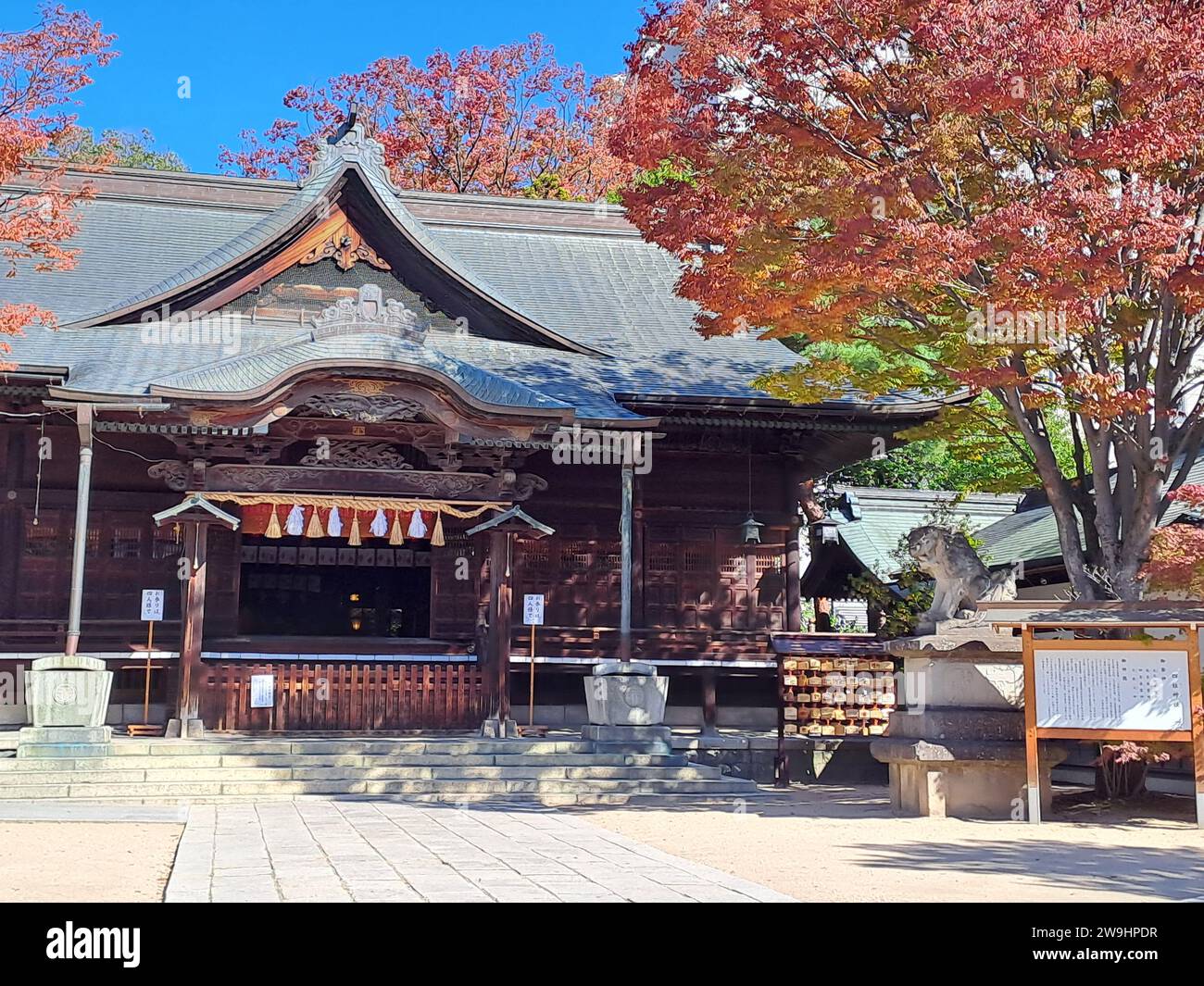 Yohashira Shrine, Matsumoto, Japan Stock Photohttps://www.alamy.com/image-license-details/?v=1https://www.alamy.com/yohashira-shrine-matsumoto-japan-image591075235.html
Yohashira Shrine, Matsumoto, Japan Stock Photohttps://www.alamy.com/image-license-details/?v=1https://www.alamy.com/yohashira-shrine-matsumoto-japan-image591075235.htmlRF2W9HPDR–Yohashira Shrine, Matsumoto, Japan
 Kotai Jingu temple or Ise Jingu Naiku, in Ise, Mie, Japan Stock Photohttps://www.alamy.com/image-license-details/?v=1https://www.alamy.com/kotai-jingu-temple-or-ise-jingu-naiku-in-ise-mie-japan-image623189660.html
Kotai Jingu temple or Ise Jingu Naiku, in Ise, Mie, Japan Stock Photohttps://www.alamy.com/image-license-details/?v=1https://www.alamy.com/kotai-jingu-temple-or-ise-jingu-naiku-in-ise-mie-japan-image623189660.htmlRF2Y5TMNG–Kotai Jingu temple or Ise Jingu Naiku, in Ise, Mie, Japan
 TOKYO, JAPAN - JUNE 27 : A shinto priest staging a prayer to a deceased anime figure in front of an altar in Akihabara shrine in Akihabara, Tokyo, Japan on June 27, 2016. The newly opened Akihabara Shrine offers a memorial services for 'deceased' anime figures. © Richard Atrero de Guzman/AFLO/Alamy Live News Stock Photohttps://www.alamy.com/image-license-details/?v=1https://www.alamy.com/stock-photo-tokyo-japan-june-27-a-shinto-priest-staging-a-prayer-to-a-deceased-108163399.html
TOKYO, JAPAN - JUNE 27 : A shinto priest staging a prayer to a deceased anime figure in front of an altar in Akihabara shrine in Akihabara, Tokyo, Japan on June 27, 2016. The newly opened Akihabara Shrine offers a memorial services for 'deceased' anime figures. © Richard Atrero de Guzman/AFLO/Alamy Live News Stock Photohttps://www.alamy.com/image-license-details/?v=1https://www.alamy.com/stock-photo-tokyo-japan-june-27-a-shinto-priest-staging-a-prayer-to-a-deceased-108163399.htmlRMG7Y7EF–TOKYO, JAPAN - JUNE 27 : A shinto priest staging a prayer to a deceased anime figure in front of an altar in Akihabara shrine in Akihabara, Tokyo, Japan on June 27, 2016. The newly opened Akihabara Shrine offers a memorial services for 'deceased' anime figures. © Richard Atrero de Guzman/AFLO/Alamy Live News
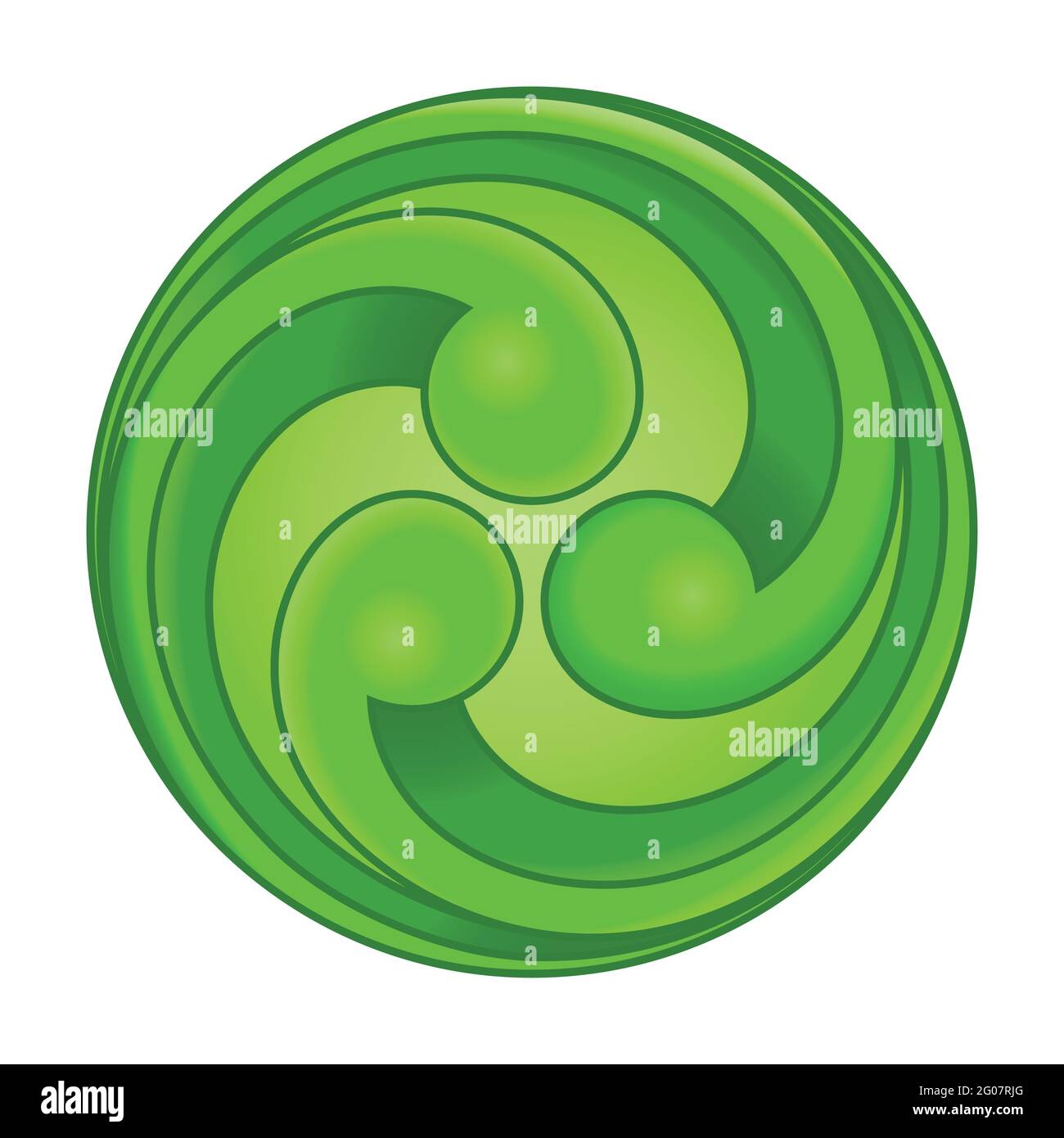 Vector design.Tomoe hams symbol formed by three magatama Stock Vectorhttps://www.alamy.com/image-license-details/?v=1https://www.alamy.com/vector-designtomoe-hams-symbol-formed-by-three-magatama-image430431416.html
Vector design.Tomoe hams symbol formed by three magatama Stock Vectorhttps://www.alamy.com/image-license-details/?v=1https://www.alamy.com/vector-designtomoe-hams-symbol-formed-by-three-magatama-image430431416.htmlRF2G07RJG–Vector design.Tomoe hams symbol formed by three magatama
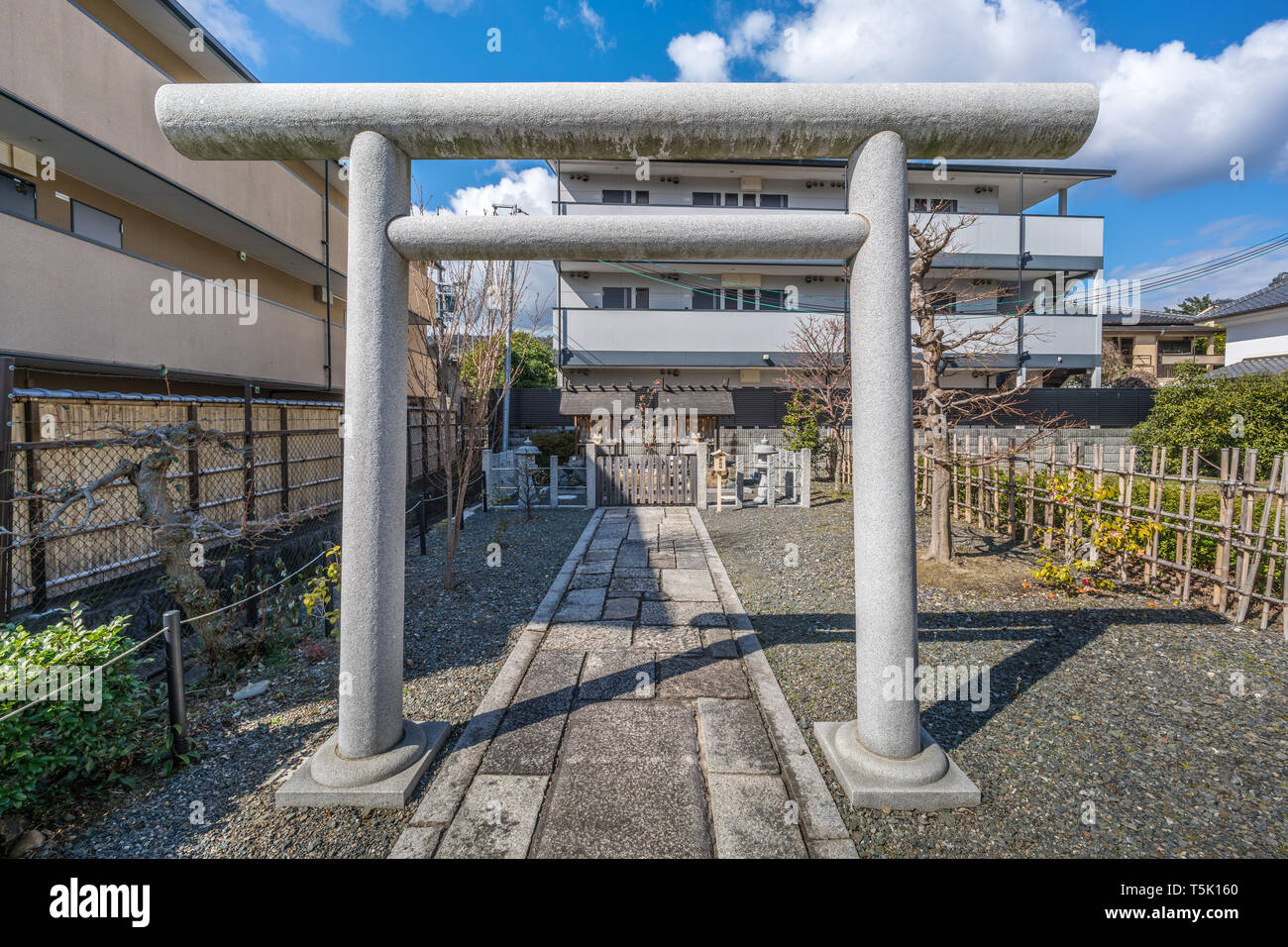 Kyoto, Japan - March 8, 2019 : Nishi-Umetsu Shinmyo-sha. Shinto Shrine devoted to Amaterasu-omikami and Toyoke-kami. Located in the grounds of Umenomi Stock Photohttps://www.alamy.com/image-license-details/?v=1https://www.alamy.com/kyoto-japan-march-8-2019-nishi-umetsu-shinmyo-sha-shinto-shrine-devoted-to-amaterasu-omikami-and-toyoke-kami-located-in-the-grounds-of-umenomi-image244436472.html
Kyoto, Japan - March 8, 2019 : Nishi-Umetsu Shinmyo-sha. Shinto Shrine devoted to Amaterasu-omikami and Toyoke-kami. Located in the grounds of Umenomi Stock Photohttps://www.alamy.com/image-license-details/?v=1https://www.alamy.com/kyoto-japan-march-8-2019-nishi-umetsu-shinmyo-sha-shinto-shrine-devoted-to-amaterasu-omikami-and-toyoke-kami-located-in-the-grounds-of-umenomi-image244436472.htmlRFT5K160–Kyoto, Japan - March 8, 2019 : Nishi-Umetsu Shinmyo-sha. Shinto Shrine devoted to Amaterasu-omikami and Toyoke-kami. Located in the grounds of Umenomi
 Bridge At Ise Grand Shrine At Ise Japan 30-8-2024 Stock Photohttps://www.alamy.com/image-license-details/?v=1https://www.alamy.com/bridge-at-ise-grand-shrine-at-ise-japan-30-8-2024-image604296002.html
Bridge At Ise Grand Shrine At Ise Japan 30-8-2024 Stock Photohttps://www.alamy.com/image-license-details/?v=1https://www.alamy.com/bridge-at-ise-grand-shrine-at-ise-japan-30-8-2024-image604296002.htmlRM2X341M2–Bridge At Ise Grand Shrine At Ise Japan 30-8-2024
 Hakata, Fukuoka / JAPAN - Aug 15 2020 : The Sign of Kushida Shrine, a Shinto shrine in Hakata-ku founded in 757, hanged on its Torii gate. Stock Photohttps://www.alamy.com/image-license-details/?v=1https://www.alamy.com/hakata-fukuoka-japan-aug-15-2020-the-sign-of-kushida-shrine-a-shinto-shrine-in-hakata-ku-founded-in-757-hanged-on-its-torii-gate-image471552708.html
Hakata, Fukuoka / JAPAN - Aug 15 2020 : The Sign of Kushida Shrine, a Shinto shrine in Hakata-ku founded in 757, hanged on its Torii gate. Stock Photohttps://www.alamy.com/image-license-details/?v=1https://www.alamy.com/hakata-fukuoka-japan-aug-15-2020-the-sign-of-kushida-shrine-a-shinto-shrine-in-hakata-ku-founded-in-757-hanged-on-its-torii-gate-image471552708.htmlRF2JB5284–Hakata, Fukuoka / JAPAN - Aug 15 2020 : The Sign of Kushida Shrine, a Shinto shrine in Hakata-ku founded in 757, hanged on its Torii gate.
 Osaki jinja shinto shrine, Kanazawa, Ishikawa, Japan. Stock Photohttps://www.alamy.com/image-license-details/?v=1https://www.alamy.com/osaki-jinja-shinto-shrine-kanazawa-ishikawa-japan-image545093159.html
Osaki jinja shinto shrine, Kanazawa, Ishikawa, Japan. Stock Photohttps://www.alamy.com/image-license-details/?v=1https://www.alamy.com/osaki-jinja-shinto-shrine-kanazawa-ishikawa-japan-image545093159.htmlRF2PJR3TR–Osaki jinja shinto shrine, Kanazawa, Ishikawa, Japan.
 Miyazaki, Japan - Nov 24 2022: Takachiho Shrine founded over 1,900 year, Ninigi no Mikoto, the grandchild of Amaterasu Omikami. It's widely worshipped Stock Photohttps://www.alamy.com/image-license-details/?v=1https://www.alamy.com/miyazaki-japan-nov-24-2022-takachiho-shrine-founded-over-1900-year-ninigi-no-mikoto-the-grandchild-of-amaterasu-omikami-its-widely-worshipped-image558853710.html
Miyazaki, Japan - Nov 24 2022: Takachiho Shrine founded over 1,900 year, Ninigi no Mikoto, the grandchild of Amaterasu Omikami. It's widely worshipped Stock Photohttps://www.alamy.com/image-license-details/?v=1https://www.alamy.com/miyazaki-japan-nov-24-2022-takachiho-shrine-founded-over-1900-year-ninigi-no-mikoto-the-grandchild-of-amaterasu-omikami-its-widely-worshipped-image558853710.htmlRF2RD5YH2–Miyazaki, Japan - Nov 24 2022: Takachiho Shrine founded over 1,900 year, Ninigi no Mikoto, the grandchild of Amaterasu Omikami. It's widely worshipped
 Japan: A bride and groom at the Kushida Shrine (Kushida-jinja), Hakata, Fukuoka, Kyushu. Kushida-jinja is a Shinto shrine dedicated to Amaterasu, the Stock Photohttps://www.alamy.com/image-license-details/?v=1https://www.alamy.com/japan-a-bride-and-groom-at-the-kushida-shrine-kushida-jinja-hakata-fukuoka-kyushu-kushida-jinja-is-a-shinto-shrine-dedicated-to-amaterasu-the-image357255474.html
Japan: A bride and groom at the Kushida Shrine (Kushida-jinja), Hakata, Fukuoka, Kyushu. Kushida-jinja is a Shinto shrine dedicated to Amaterasu, the Stock Photohttps://www.alamy.com/image-license-details/?v=1https://www.alamy.com/japan-a-bride-and-groom-at-the-kushida-shrine-kushida-jinja-hakata-fukuoka-kyushu-kushida-jinja-is-a-shinto-shrine-dedicated-to-amaterasu-the-image357255474.htmlRM2BN6B02–Japan: A bride and groom at the Kushida Shrine (Kushida-jinja), Hakata, Fukuoka, Kyushu. Kushida-jinja is a Shinto shrine dedicated to Amaterasu, the
 Susanoo-no-Mikoto, more commonly known as just Susanoo or Susano-o, was a kami and god in the Shinto pantheon, master of storm and sea. He was born, alongside his siblings Amaterasu and Tsukuyomi, when the creator god Izanagi washed himself after his journey into the Yomi, the underworld. Susano was born from Izanagi washing his nose. Susanoo was known as a hot-headed and violent man, and had a long-standing rivalry with his sister Amaterasu. After losing a chalenge to her, he raged and killed one of her attendants, destroyed her rice fields and hurled a flayed pony at her loom. For these act Stock Photohttps://www.alamy.com/image-license-details/?v=1https://www.alamy.com/susanoo-no-mikoto-more-commonly-known-as-just-susanoo-or-susano-o-was-a-kami-and-god-in-the-shinto-pantheon-master-of-storm-and-sea-he-was-born-alongside-his-siblings-amaterasu-and-tsukuyomi-when-the-creator-god-izanagi-washed-himself-after-his-journey-into-the-yomi-the-underworld-susano-was-born-from-izanagi-washing-his-nose-susanoo-was-known-as-a-hot-headed-and-violent-man-and-had-a-long-standing-rivalry-with-his-sister-amaterasu-after-losing-a-chalenge-to-her-he-raged-and-killed-one-of-her-attendants-destroyed-her-rice-fields-and-hurled-a-flayed-pony-at-her-loom-for-these-act-image344278794.html
Susanoo-no-Mikoto, more commonly known as just Susanoo or Susano-o, was a kami and god in the Shinto pantheon, master of storm and sea. He was born, alongside his siblings Amaterasu and Tsukuyomi, when the creator god Izanagi washed himself after his journey into the Yomi, the underworld. Susano was born from Izanagi washing his nose. Susanoo was known as a hot-headed and violent man, and had a long-standing rivalry with his sister Amaterasu. After losing a chalenge to her, he raged and killed one of her attendants, destroyed her rice fields and hurled a flayed pony at her loom. For these act Stock Photohttps://www.alamy.com/image-license-details/?v=1https://www.alamy.com/susanoo-no-mikoto-more-commonly-known-as-just-susanoo-or-susano-o-was-a-kami-and-god-in-the-shinto-pantheon-master-of-storm-and-sea-he-was-born-alongside-his-siblings-amaterasu-and-tsukuyomi-when-the-creator-god-izanagi-washed-himself-after-his-journey-into-the-yomi-the-underworld-susano-was-born-from-izanagi-washing-his-nose-susanoo-was-known-as-a-hot-headed-and-violent-man-and-had-a-long-standing-rivalry-with-his-sister-amaterasu-after-losing-a-chalenge-to-her-he-raged-and-killed-one-of-her-attendants-destroyed-her-rice-fields-and-hurled-a-flayed-pony-at-her-loom-for-these-act-image344278794.htmlRM2B03736–Susanoo-no-Mikoto, more commonly known as just Susanoo or Susano-o, was a kami and god in the Shinto pantheon, master of storm and sea. He was born, alongside his siblings Amaterasu and Tsukuyomi, when the creator god Izanagi washed himself after his journey into the Yomi, the underworld. Susano was born from Izanagi washing his nose. Susanoo was known as a hot-headed and violent man, and had a long-standing rivalry with his sister Amaterasu. After losing a chalenge to her, he raged and killed one of her attendants, destroyed her rice fields and hurled a flayed pony at her loom. For these act
 Ise Jingu Shrine Stock Photohttps://www.alamy.com/image-license-details/?v=1https://www.alamy.com/ise-jingu-shrine-image559584003.html
Ise Jingu Shrine Stock Photohttps://www.alamy.com/image-license-details/?v=1https://www.alamy.com/ise-jingu-shrine-image559584003.htmlRM2REB72Y–Ise Jingu Shrine
 Ise Grand Shrine, Mie Prefecture, Japan: View of the Outer Shrine (Geku) Stock Photohttps://www.alamy.com/image-license-details/?v=1https://www.alamy.com/ise-grand-shrine-mie-prefecture-japan-view-of-the-outer-shrine-geku-image227953906.html
Ise Grand Shrine, Mie Prefecture, Japan: View of the Outer Shrine (Geku) Stock Photohttps://www.alamy.com/image-license-details/?v=1https://www.alamy.com/ise-grand-shrine-mie-prefecture-japan-view-of-the-outer-shrine-geku-image227953906.htmlRMR6T5EX–Ise Grand Shrine, Mie Prefecture, Japan: View of the Outer Shrine (Geku)
 Washing water and ladles Kushida Shrine Fukuoka Kyushu Japan Stock Photohttps://www.alamy.com/image-license-details/?v=1https://www.alamy.com/stock-photo-washing-water-and-ladles-kushida-shrine-fukuoka-kyushu-japan-59246398.html
Washing water and ladles Kushida Shrine Fukuoka Kyushu Japan Stock Photohttps://www.alamy.com/image-license-details/?v=1https://www.alamy.com/stock-photo-washing-water-and-ladles-kushida-shrine-fukuoka-kyushu-japan-59246398.htmlRMDCAWAP–Washing water and ladles Kushida Shrine Fukuoka Kyushu Japan
 Asia culture concept - woman with kimono pray under shimenawa rope of traditional kushida shrine in Fukuoka Japan Stock Photohttps://www.alamy.com/image-license-details/?v=1https://www.alamy.com/asia-culture-concept-woman-with-kimono-pray-under-shimenawa-rope-of-traditional-kushida-shrine-in-fukuoka-japan-image232389761.html
Asia culture concept - woman with kimono pray under shimenawa rope of traditional kushida shrine in Fukuoka Japan Stock Photohttps://www.alamy.com/image-license-details/?v=1https://www.alamy.com/asia-culture-concept-woman-with-kimono-pray-under-shimenawa-rope-of-traditional-kushida-shrine-in-fukuoka-japan-image232389761.htmlRFRE27E9–Asia culture concept - woman with kimono pray under shimenawa rope of traditional kushida shrine in Fukuoka Japan
 Illustration vector isolated of Japanese mythology, Japanese gods Inzanami Stock Vectorhttps://www.alamy.com/image-license-details/?v=1https://www.alamy.com/illustration-vector-isolated-of-japanese-mythology-japanese-gods-inzanami-image468434512.html
Illustration vector isolated of Japanese mythology, Japanese gods Inzanami Stock Vectorhttps://www.alamy.com/image-license-details/?v=1https://www.alamy.com/illustration-vector-isolated-of-japanese-mythology-japanese-gods-inzanami-image468434512.htmlRF2J63100–Illustration vector isolated of Japanese mythology, Japanese gods Inzanami
 Kotai Jingu temple or Ise Jingu Naiku, in Ise, Mie, Japan Stock Photohttps://www.alamy.com/image-license-details/?v=1https://www.alamy.com/kotai-jingu-temple-or-ise-jingu-naiku-in-ise-mie-japan-image623189656.html
Kotai Jingu temple or Ise Jingu Naiku, in Ise, Mie, Japan Stock Photohttps://www.alamy.com/image-license-details/?v=1https://www.alamy.com/kotai-jingu-temple-or-ise-jingu-naiku-in-ise-mie-japan-image623189656.htmlRF2Y5TMNC–Kotai Jingu temple or Ise Jingu Naiku, in Ise, Mie, Japan
 TOKYO, JAPAN - JUNE 27 : A shinto priest staging a prayer to a deceased anime figure in front of an altar in Akihabara shrine in Akihabara, Tokyo, Japan on June 27, 2016. The newly opened Akihabara Shrine offers a memorial services for 'deceased' anime figures. © Richard Atrero de Guzman/AFLO/Alamy Live News Stock Photohttps://www.alamy.com/image-license-details/?v=1https://www.alamy.com/stock-photo-tokyo-japan-june-27-a-shinto-priest-staging-a-prayer-to-a-deceased-108163419.html
TOKYO, JAPAN - JUNE 27 : A shinto priest staging a prayer to a deceased anime figure in front of an altar in Akihabara shrine in Akihabara, Tokyo, Japan on June 27, 2016. The newly opened Akihabara Shrine offers a memorial services for 'deceased' anime figures. © Richard Atrero de Guzman/AFLO/Alamy Live News Stock Photohttps://www.alamy.com/image-license-details/?v=1https://www.alamy.com/stock-photo-tokyo-japan-june-27-a-shinto-priest-staging-a-prayer-to-a-deceased-108163419.htmlRMG7Y7F7–TOKYO, JAPAN - JUNE 27 : A shinto priest staging a prayer to a deceased anime figure in front of an altar in Akihabara shrine in Akihabara, Tokyo, Japan on June 27, 2016. The newly opened Akihabara Shrine offers a memorial services for 'deceased' anime figures. © Richard Atrero de Guzman/AFLO/Alamy Live News
 Vector design.Tomoe hams symbol formed by three magatama Stock Vectorhttps://www.alamy.com/image-license-details/?v=1https://www.alamy.com/vector-designtomoe-hams-symbol-formed-by-three-magatama-image430431451.html
Vector design.Tomoe hams symbol formed by three magatama Stock Vectorhttps://www.alamy.com/image-license-details/?v=1https://www.alamy.com/vector-designtomoe-hams-symbol-formed-by-three-magatama-image430431451.htmlRF2G07RKR–Vector design.Tomoe hams symbol formed by three magatama
 Kyoto, Japan - March 8, 2019 : Nishi-Umetsu Shinmyo-sha. Shinto Shrine devoted to Amaterasu-omikami and Toyoke-kami. Located in the grounds of Umenomi Stock Photohttps://www.alamy.com/image-license-details/?v=1https://www.alamy.com/kyoto-japan-march-8-2019-nishi-umetsu-shinmyo-sha-shinto-shrine-devoted-to-amaterasu-omikami-and-toyoke-kami-located-in-the-grounds-of-umenomi-image244446656.html
Kyoto, Japan - March 8, 2019 : Nishi-Umetsu Shinmyo-sha. Shinto Shrine devoted to Amaterasu-omikami and Toyoke-kami. Located in the grounds of Umenomi Stock Photohttps://www.alamy.com/image-license-details/?v=1https://www.alamy.com/kyoto-japan-march-8-2019-nishi-umetsu-shinmyo-sha-shinto-shrine-devoted-to-amaterasu-omikami-and-toyoke-kami-located-in-the-grounds-of-umenomi-image244446656.htmlRFT5KE5M–Kyoto, Japan - March 8, 2019 : Nishi-Umetsu Shinmyo-sha. Shinto Shrine devoted to Amaterasu-omikami and Toyoke-kami. Located in the grounds of Umenomi
 Vector design Tomoe hams symbol formed by three magatama Stock Vectorhttps://www.alamy.com/image-license-details/?v=1https://www.alamy.com/vector-design-tomoe-hams-symbol-formed-by-three-magatama-image477300959.html
Vector design Tomoe hams symbol formed by three magatama Stock Vectorhttps://www.alamy.com/image-license-details/?v=1https://www.alamy.com/vector-design-tomoe-hams-symbol-formed-by-three-magatama-image477300959.htmlRF2JMEX6R–Vector design Tomoe hams symbol formed by three magatama
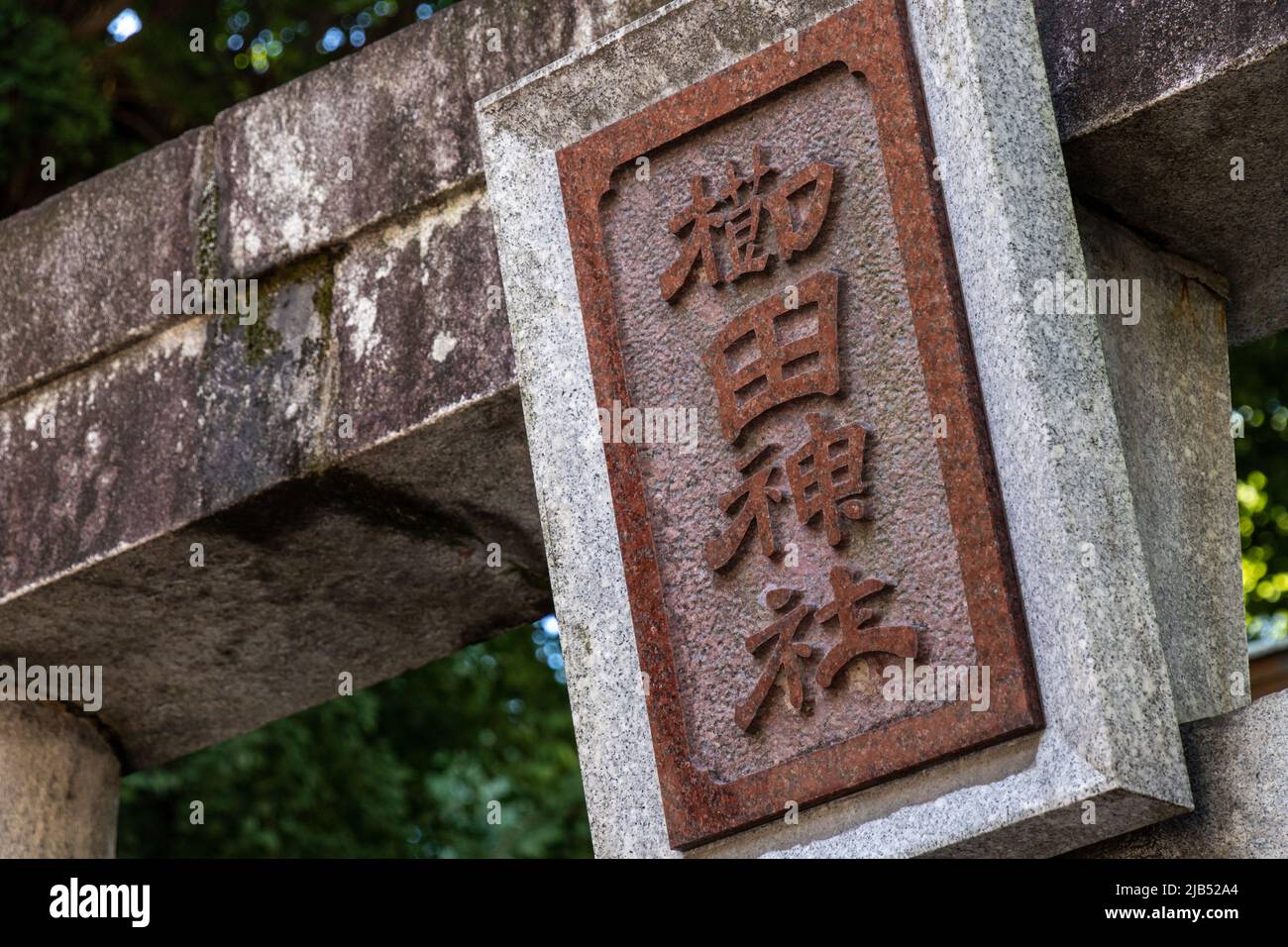 Hakata, Fukuoka / JAPAN - Aug 15 2020 : The Sign of Kushida Shrine, a Shinto shrine in Hakata-ku founded in 757, hanged on its Torii gate. Stock Photohttps://www.alamy.com/image-license-details/?v=1https://www.alamy.com/hakata-fukuoka-japan-aug-15-2020-the-sign-of-kushida-shrine-a-shinto-shrine-in-hakata-ku-founded-in-757-hanged-on-its-torii-gate-image471552764.html
Hakata, Fukuoka / JAPAN - Aug 15 2020 : The Sign of Kushida Shrine, a Shinto shrine in Hakata-ku founded in 757, hanged on its Torii gate. Stock Photohttps://www.alamy.com/image-license-details/?v=1https://www.alamy.com/hakata-fukuoka-japan-aug-15-2020-the-sign-of-kushida-shrine-a-shinto-shrine-in-hakata-ku-founded-in-757-hanged-on-its-torii-gate-image471552764.htmlRF2JB52A4–Hakata, Fukuoka / JAPAN - Aug 15 2020 : The Sign of Kushida Shrine, a Shinto shrine in Hakata-ku founded in 757, hanged on its Torii gate.
 Osaki jinja shinto shrine, Kanazawa, Ishikawa, Japan. Stock Photohttps://www.alamy.com/image-license-details/?v=1https://www.alamy.com/osaki-jinja-shinto-shrine-kanazawa-ishikawa-japan-image529241892.html
Osaki jinja shinto shrine, Kanazawa, Ishikawa, Japan. Stock Photohttps://www.alamy.com/image-license-details/?v=1https://www.alamy.com/osaki-jinja-shinto-shrine-kanazawa-ishikawa-japan-image529241892.htmlRF2NN11C4–Osaki jinja shinto shrine, Kanazawa, Ishikawa, Japan.
 Miyazaki, Japan - Nov 24 2022: Takachiho Shrine founded over 1,900 year, Ninigi no Mikoto, the grandchild of Amaterasu Omikami. It's widely worshipped Stock Photohttps://www.alamy.com/image-license-details/?v=1https://www.alamy.com/miyazaki-japan-nov-24-2022-takachiho-shrine-founded-over-1900-year-ninigi-no-mikoto-the-grandchild-of-amaterasu-omikami-its-widely-worshipped-image546558630.html
Miyazaki, Japan - Nov 24 2022: Takachiho Shrine founded over 1,900 year, Ninigi no Mikoto, the grandchild of Amaterasu Omikami. It's widely worshipped Stock Photohttps://www.alamy.com/image-license-details/?v=1https://www.alamy.com/miyazaki-japan-nov-24-2022-takachiho-shrine-founded-over-1900-year-ninigi-no-mikoto-the-grandchild-of-amaterasu-omikami-its-widely-worshipped-image546558630.htmlRF2PN5W32–Miyazaki, Japan - Nov 24 2022: Takachiho Shrine founded over 1,900 year, Ninigi no Mikoto, the grandchild of Amaterasu Omikami. It's widely worshipped
 Tori At Ise Grand Shrine At Ise Japan 2016 Stock Photohttps://www.alamy.com/image-license-details/?v=1https://www.alamy.com/tori-at-ise-grand-shrine-at-ise-japan-2016-image337579563.html
Tori At Ise Grand Shrine At Ise Japan 2016 Stock Photohttps://www.alamy.com/image-license-details/?v=1https://www.alamy.com/tori-at-ise-grand-shrine-at-ise-japan-2016-image337579563.htmlRF2AH624Y–Tori At Ise Grand Shrine At Ise Japan 2016
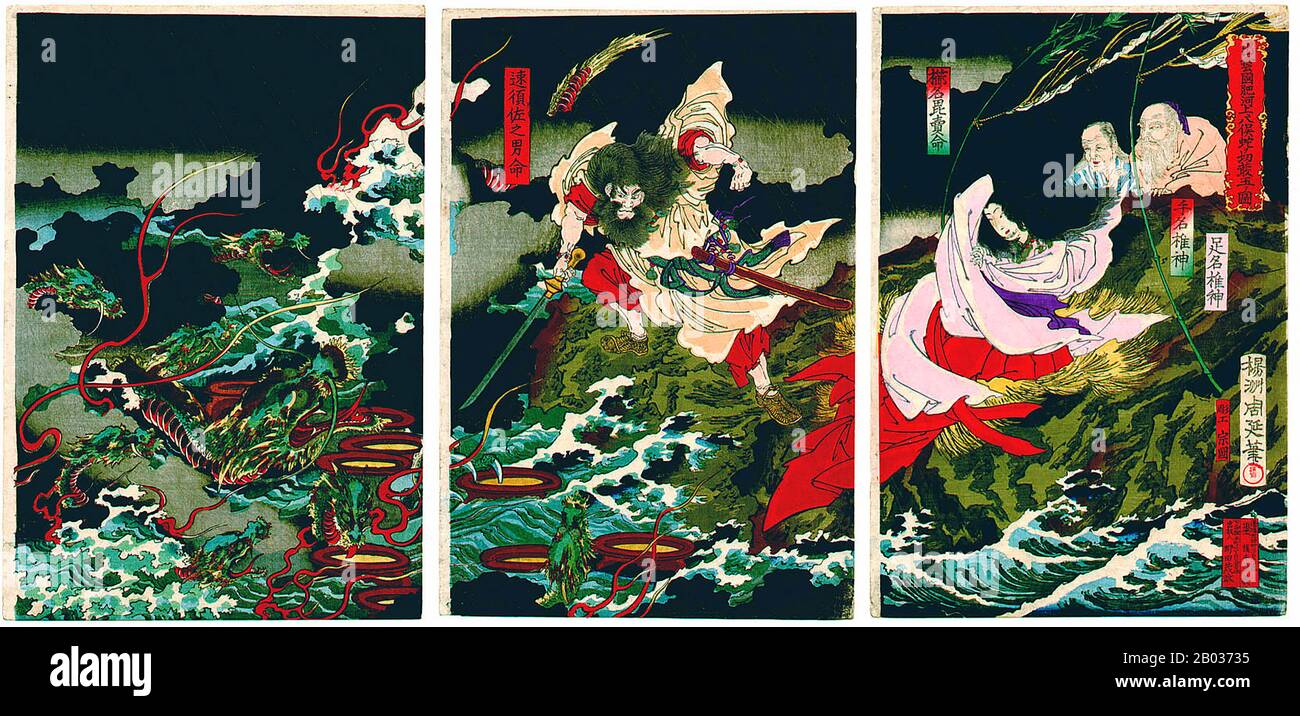 Susanoo-no-Mikoto, more commonly known as just Susanoo or Susano-o, was a kami and god in the Shinto pantheon, master of storm and sea. He was born, alongside his siblings Amaterasu and Tsukuyomi, when the creator god Izanagi washed himself after his journey into the Yomi, the underworld. Susano was born from Izanagi washing his nose. Susanoo was known as a hot-headed and violent man, and had a long-standing rivalry with his sister Amaterasu. After losing a chalenge to her, he raged and killed one of her attendants, destroyed her rice fields and hurled a flayed pony at her loom. For these act Stock Photohttps://www.alamy.com/image-license-details/?v=1https://www.alamy.com/susanoo-no-mikoto-more-commonly-known-as-just-susanoo-or-susano-o-was-a-kami-and-god-in-the-shinto-pantheon-master-of-storm-and-sea-he-was-born-alongside-his-siblings-amaterasu-and-tsukuyomi-when-the-creator-god-izanagi-washed-himself-after-his-journey-into-the-yomi-the-underworld-susano-was-born-from-izanagi-washing-his-nose-susanoo-was-known-as-a-hot-headed-and-violent-man-and-had-a-long-standing-rivalry-with-his-sister-amaterasu-after-losing-a-chalenge-to-her-he-raged-and-killed-one-of-her-attendants-destroyed-her-rice-fields-and-hurled-a-flayed-pony-at-her-loom-for-these-act-image344278793.html
Susanoo-no-Mikoto, more commonly known as just Susanoo or Susano-o, was a kami and god in the Shinto pantheon, master of storm and sea. He was born, alongside his siblings Amaterasu and Tsukuyomi, when the creator god Izanagi washed himself after his journey into the Yomi, the underworld. Susano was born from Izanagi washing his nose. Susanoo was known as a hot-headed and violent man, and had a long-standing rivalry with his sister Amaterasu. After losing a chalenge to her, he raged and killed one of her attendants, destroyed her rice fields and hurled a flayed pony at her loom. For these act Stock Photohttps://www.alamy.com/image-license-details/?v=1https://www.alamy.com/susanoo-no-mikoto-more-commonly-known-as-just-susanoo-or-susano-o-was-a-kami-and-god-in-the-shinto-pantheon-master-of-storm-and-sea-he-was-born-alongside-his-siblings-amaterasu-and-tsukuyomi-when-the-creator-god-izanagi-washed-himself-after-his-journey-into-the-yomi-the-underworld-susano-was-born-from-izanagi-washing-his-nose-susanoo-was-known-as-a-hot-headed-and-violent-man-and-had-a-long-standing-rivalry-with-his-sister-amaterasu-after-losing-a-chalenge-to-her-he-raged-and-killed-one-of-her-attendants-destroyed-her-rice-fields-and-hurled-a-flayed-pony-at-her-loom-for-these-act-image344278793.htmlRM2B03735–Susanoo-no-Mikoto, more commonly known as just Susanoo or Susano-o, was a kami and god in the Shinto pantheon, master of storm and sea. He was born, alongside his siblings Amaterasu and Tsukuyomi, when the creator god Izanagi washed himself after his journey into the Yomi, the underworld. Susano was born from Izanagi washing his nose. Susanoo was known as a hot-headed and violent man, and had a long-standing rivalry with his sister Amaterasu. After losing a chalenge to her, he raged and killed one of her attendants, destroyed her rice fields and hurled a flayed pony at her loom. For these act
 Ise Grand Shrine, Mie Prefecture, Japan: View of the Moon Shrine near the Outer Shrine (Geku) Stock Photohttps://www.alamy.com/image-license-details/?v=1https://www.alamy.com/ise-grand-shrine-mie-prefecture-japan-view-of-the-moon-shrine-near-the-outer-shrine-geku-image227953737.html
Ise Grand Shrine, Mie Prefecture, Japan: View of the Moon Shrine near the Outer Shrine (Geku) Stock Photohttps://www.alamy.com/image-license-details/?v=1https://www.alamy.com/ise-grand-shrine-mie-prefecture-japan-view-of-the-moon-shrine-near-the-outer-shrine-geku-image227953737.htmlRMR6T58W–Ise Grand Shrine, Mie Prefecture, Japan: View of the Moon Shrine near the Outer Shrine (Geku)
 Yamakasa festival float Kushida Shrine Fukuoka Kyushu Japan Stock Photohttps://www.alamy.com/image-license-details/?v=1https://www.alamy.com/stock-photo-yamakasa-festival-float-kushida-shrine-fukuoka-kyushu-japan-59222959.html
Yamakasa festival float Kushida Shrine Fukuoka Kyushu Japan Stock Photohttps://www.alamy.com/image-license-details/?v=1https://www.alamy.com/stock-photo-yamakasa-festival-float-kushida-shrine-fukuoka-kyushu-japan-59222959.htmlRMDC9RDK–Yamakasa festival float Kushida Shrine Fukuoka Kyushu Japan
 Asia culture concept - the beautiful roof decoration art and shimenawa rope of traditional kushida shrine in Fukuoka Japan Stock Photohttps://www.alamy.com/image-license-details/?v=1https://www.alamy.com/asia-culture-concept-the-beautiful-roof-decoration-art-and-shimenawa-rope-of-traditional-kushida-shrine-in-fukuoka-japan-image232389753.html
Asia culture concept - the beautiful roof decoration art and shimenawa rope of traditional kushida shrine in Fukuoka Japan Stock Photohttps://www.alamy.com/image-license-details/?v=1https://www.alamy.com/asia-culture-concept-the-beautiful-roof-decoration-art-and-shimenawa-rope-of-traditional-kushida-shrine-in-fukuoka-japan-image232389753.htmlRFRE27E1–Asia culture concept - the beautiful roof decoration art and shimenawa rope of traditional kushida shrine in Fukuoka Japan
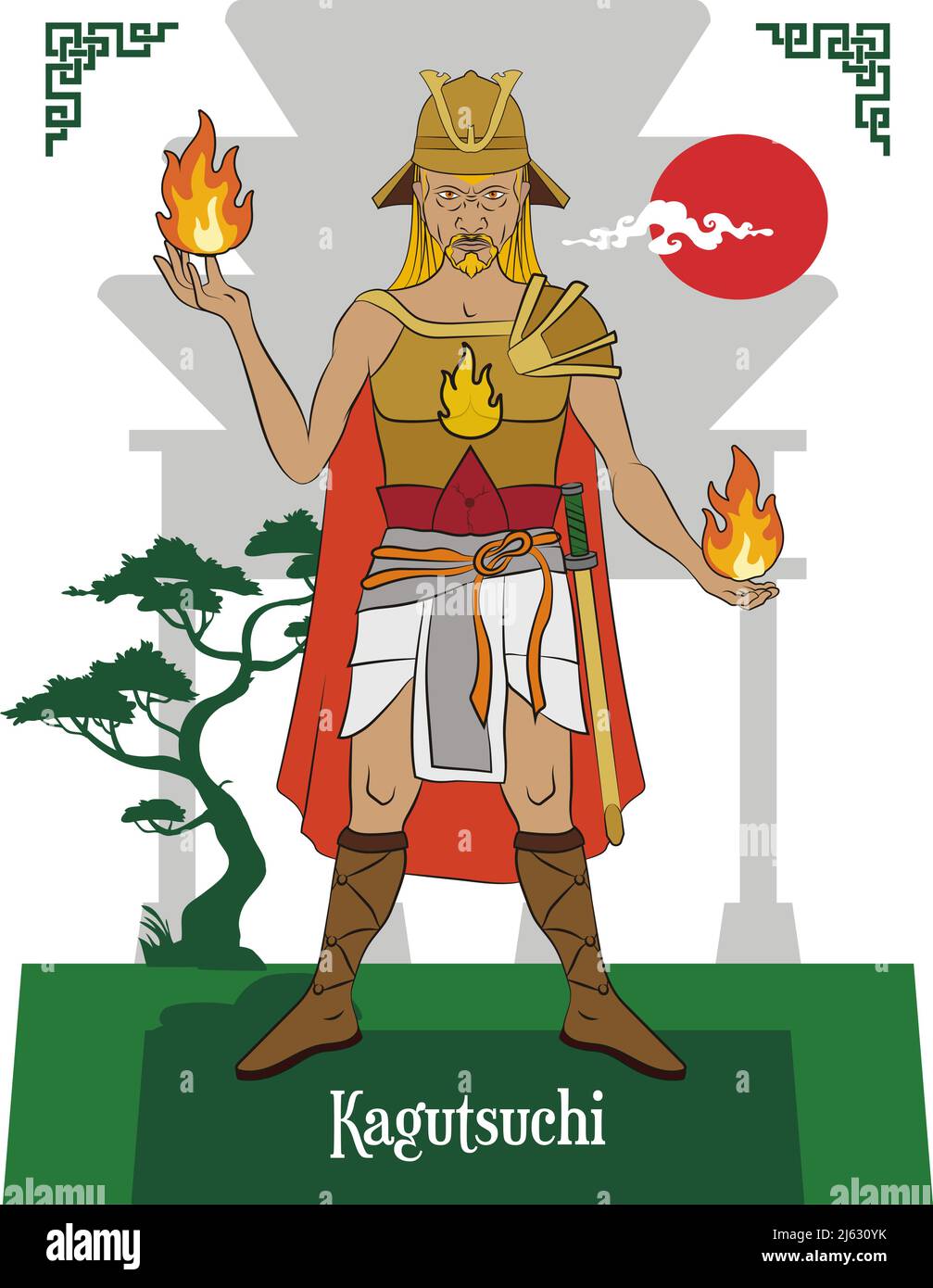 Illustration vector isolated of Japanese mythology, Japanese gods Kagutsuchi Stock Vectorhttps://www.alamy.com/image-license-details/?v=1https://www.alamy.com/illustration-vector-isolated-of-japanese-mythology-japanese-gods-kagutsuchi-image468434503.html
Illustration vector isolated of Japanese mythology, Japanese gods Kagutsuchi Stock Vectorhttps://www.alamy.com/image-license-details/?v=1https://www.alamy.com/illustration-vector-isolated-of-japanese-mythology-japanese-gods-kagutsuchi-image468434503.htmlRF2J630YK–Illustration vector isolated of Japanese mythology, Japanese gods Kagutsuchi
 Kotai Jingu temple or Ise Jingu Naiku, in Ise, Mie, Japan Stock Photohttps://www.alamy.com/image-license-details/?v=1https://www.alamy.com/kotai-jingu-temple-or-ise-jingu-naiku-in-ise-mie-japan-image623189658.html
Kotai Jingu temple or Ise Jingu Naiku, in Ise, Mie, Japan Stock Photohttps://www.alamy.com/image-license-details/?v=1https://www.alamy.com/kotai-jingu-temple-or-ise-jingu-naiku-in-ise-mie-japan-image623189658.htmlRF2Y5TMNE–Kotai Jingu temple or Ise Jingu Naiku, in Ise, Mie, Japan
 TOKYO, JAPAN - JUNE 27 : A shinto priest staging a prayer to a deceased anime figure in front of an altar in Akihabara shrine in Akihabara, Tokyo, Japan on June 27, 2016. The newly opened Akihabara Shrine offers a memorial services for 'deceased' anime figures. © Richard Atrero de Guzman/AFLO/Alamy Live News Stock Photohttps://www.alamy.com/image-license-details/?v=1https://www.alamy.com/stock-photo-tokyo-japan-june-27-a-shinto-priest-staging-a-prayer-to-a-deceased-108163413.html
TOKYO, JAPAN - JUNE 27 : A shinto priest staging a prayer to a deceased anime figure in front of an altar in Akihabara shrine in Akihabara, Tokyo, Japan on June 27, 2016. The newly opened Akihabara Shrine offers a memorial services for 'deceased' anime figures. © Richard Atrero de Guzman/AFLO/Alamy Live News Stock Photohttps://www.alamy.com/image-license-details/?v=1https://www.alamy.com/stock-photo-tokyo-japan-june-27-a-shinto-priest-staging-a-prayer-to-a-deceased-108163413.htmlRMG7Y7F1–TOKYO, JAPAN - JUNE 27 : A shinto priest staging a prayer to a deceased anime figure in front of an altar in Akihabara shrine in Akihabara, Tokyo, Japan on June 27, 2016. The newly opened Akihabara Shrine offers a memorial services for 'deceased' anime figures. © Richard Atrero de Guzman/AFLO/Alamy Live News
 Kyoto, Japan - March 8, 2019 : Nishi-Umetsu Shinmyo-sha. Shinto Shrine devoted to Amaterasu-omikami and Toyoke-kami. Located in the grounds of Umenomi Stock Photohttps://www.alamy.com/image-license-details/?v=1https://www.alamy.com/kyoto-japan-march-8-2019-nishi-umetsu-shinmyo-sha-shinto-shrine-devoted-to-amaterasu-omikami-and-toyoke-kami-located-in-the-grounds-of-umenomi-image244436201.html
Kyoto, Japan - March 8, 2019 : Nishi-Umetsu Shinmyo-sha. Shinto Shrine devoted to Amaterasu-omikami and Toyoke-kami. Located in the grounds of Umenomi Stock Photohttps://www.alamy.com/image-license-details/?v=1https://www.alamy.com/kyoto-japan-march-8-2019-nishi-umetsu-shinmyo-sha-shinto-shrine-devoted-to-amaterasu-omikami-and-toyoke-kami-located-in-the-grounds-of-umenomi-image244436201.htmlRFT5K0T9–Kyoto, Japan - March 8, 2019 : Nishi-Umetsu Shinmyo-sha. Shinto Shrine devoted to Amaterasu-omikami and Toyoke-kami. Located in the grounds of Umenomi